Patron Management
Find a Patron using the Patron List
- Click the Patron
 button in the main toolbar / ribbon bar.
button in the main toolbar / ribbon bar.
The Contact List window opens.
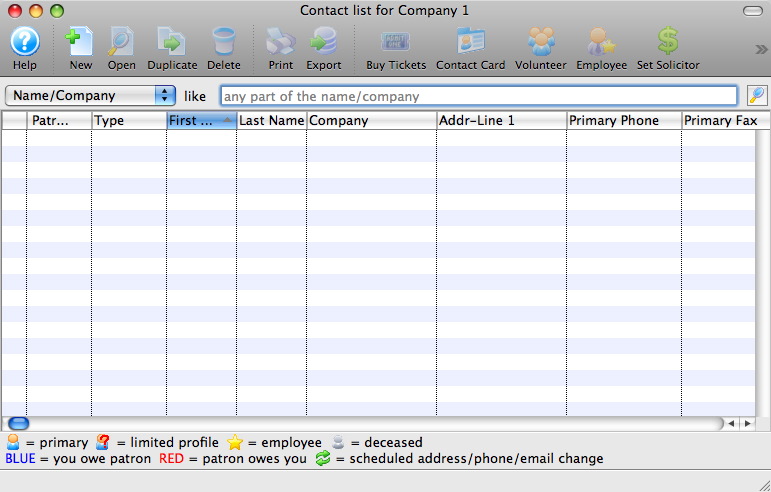
For more information on the Contact List window click here.
- Select a search option.
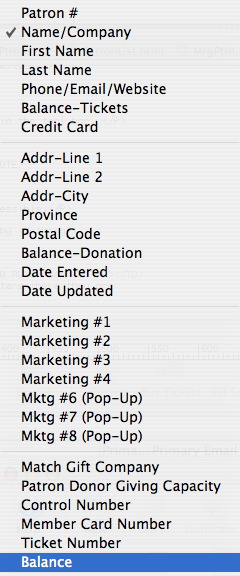
In this example the Name / Company search option was selected. The Name / Company search option searchs for what you type in the First Name, Last Name or Company fields. This search option is special because it will search anywhere in the field, meaning the name or company does not need to start with what you type in, it can be in the start, middle or end. For example, if you search for Don, the search will return Don, Macdonald and Mastadon.
- Type the last name into the "Like" field.
Theatre Manager allows the use of the '%' wildcard when searching. The % wildcard substitutes for normal characters in a search string. For example, to search for people that sound like 'Smith', you could use 'Sm%th'. To search for all people who live on Main, you could use '% main' (this could find 123 Main Street, 895 Main Avenue, etc).

- Click the Search
 button.
button.
The results of the search will appear in the contact list.
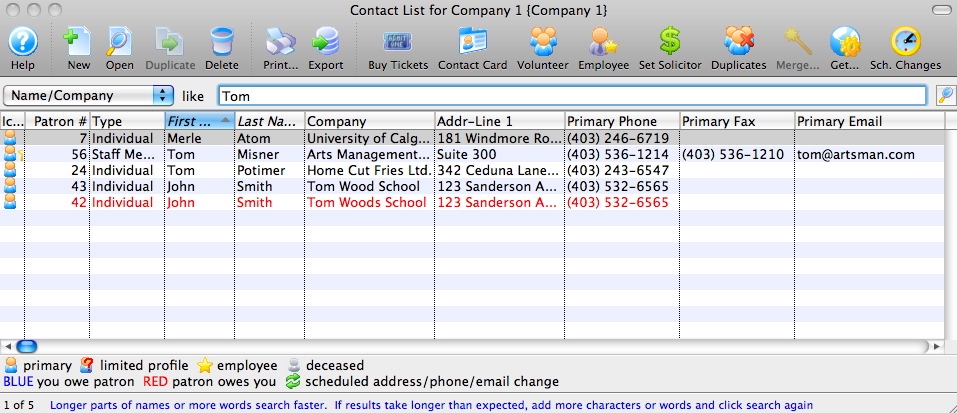
- Click the Patron # column header.
This button is located at the top left hand corner of the patron list window. When it is selected the list of patrons will sort by patron number. Clicking other column headers will sort the list by that column. An underlined column header indicates the column that the list is sorted by. Sorting in reverse order is also possible. Hold down the <CTRL> key (Windows) or the <OPTION> key (Mac) while clicking the column header. You can also sort by more than one column at once by holding down the SHIFT key (Windows and Mac) and clicking on the additional column(s) you wish to sort by. You can sort by up to nine columns.
- Single click on the patron searched for.
- Click the Open
 button.
button.
The patron record opens. For more information on the patron window click here.
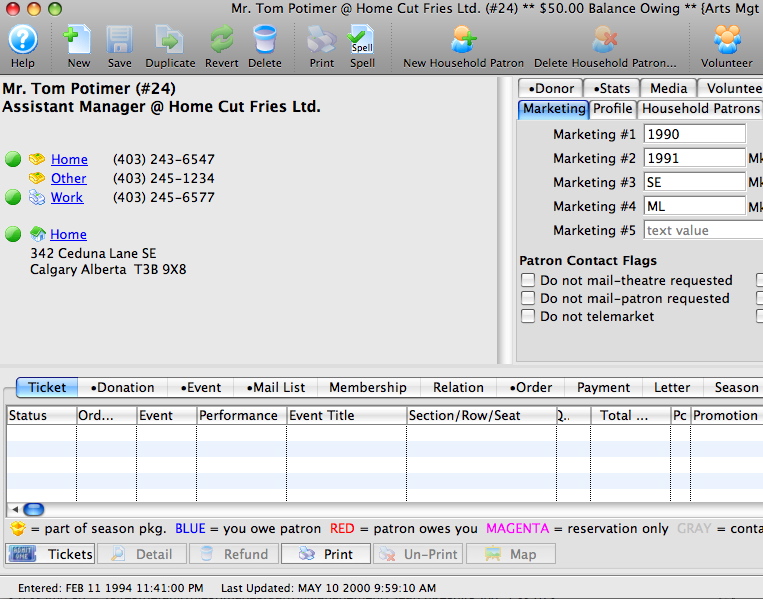
Finding a Patron using Quick Find
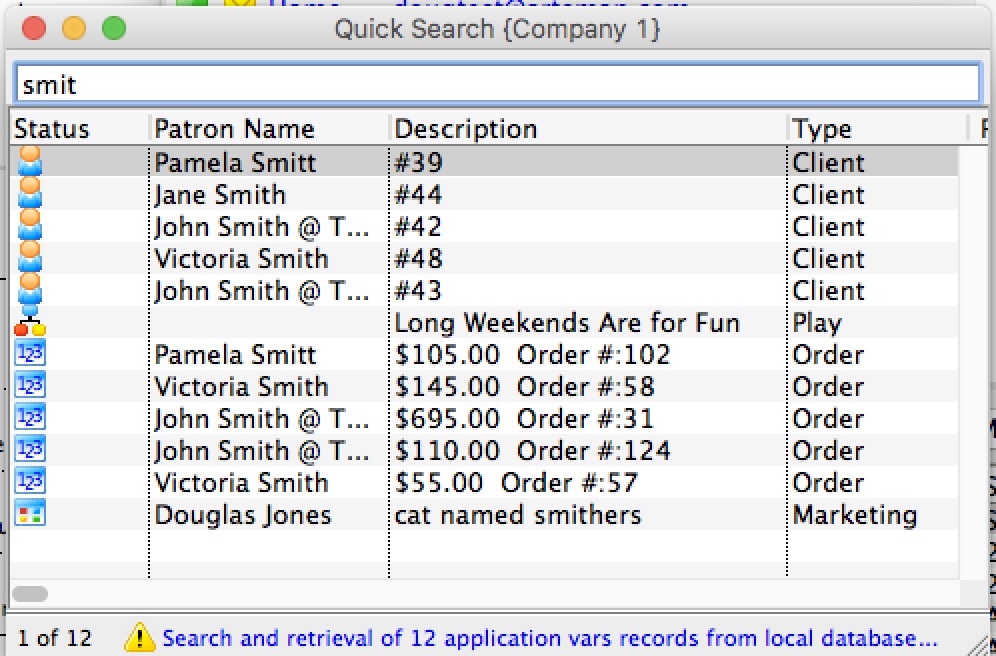 Quick find uses a database feature called text search to look for partial words almost anywhere in text string in the database. Quick find:
Quick find uses a database feature called text search to look for partial words almost anywhere in text string in the database. Quick find:
- searches for words in any order, regardless of the order you typed them
- searches for words that start with what you type
- generally ignores plurality - so that a search for actors will find actor and vice versa
- may not find words you typed that are called stop words when they are in fields other than name. Stop words are those that occur too frequently to be useful in searching - such as a, and, it.
To find a Patron using Quick Find, you perform the following steps:
- Click the
 button in the toolbar.
button in the toolbar. - The Quick Search window opens.
- Enter a key search item for the patron.
This can be the patron number, patron name, company name, words in notes - anything.
- Click the enter key on the keyboard.
The Quick Search window will populate with all records where part or all of the key search can be found.
- Double click on the desired record
The patron record will open.
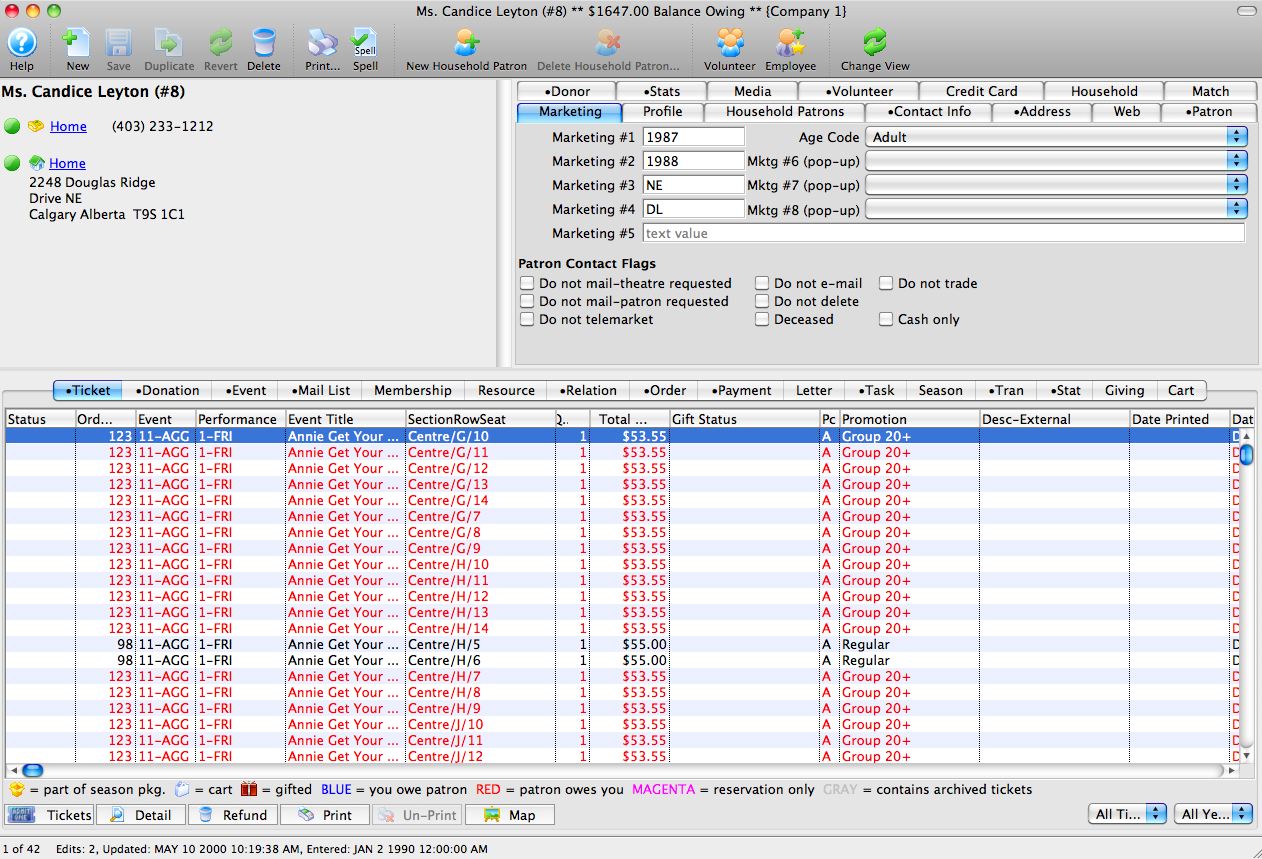
Finding Duplicate Patrons and Merging Them
- Patron List window - which allows scanning of the currently displayed list -or- will scan the entire database to suggest duplicate patrons
- Mail List Detail window - the whos' in tab allows searching of the patrons within the list (which is really patrons in the mail list) to see if any of them are duplicates. This can be helpful if Arts Management has built a list of patrons with duplicate email addresses for you.
On these two windows, there is a button called 'duplicates'. Clicking on that will show some fields that can be used to find possible duplicate patrons in the database that can be used to merge patrons together. This is helpful if:
- You have done a recent import of patrons and have a number of duplicates
- You need to identify people who have added themselves multiple times online using different email addresses and need consolidated into one patron record
The find duplicate process also has a feature to auto-merge the patrons that are found according to various criteria. Because merging patrons cannot be reversed, the merge feature should only be used if you really know what you are doing and are:
- Planning on merging a lot of patrons -and-
- Have made a backup of the database for contingency sake
Find Duplicate/Merge Process
If you are going to merge patrons, we recommend doing it in a two step process as follows:
- Use the duplicate finding routine to identify possible duplicates (but not merge)
- Look at the list of patrons manually. If there are any obvious patrons that need removed (which duplicate process found), then 'remove' them manually from the list by selecting the rows and right-clicking and picking 'remove from list'.
- The run the duplicates process a second time and search the list (not the database) and merge from the names in the list. This is a lot safer
- Alternately, if you only have a handful to merge, you can use the 'prompt' feature in the auto-merge to identify up to 25 matches at one time.
Search the database using fields, duplicate email addresses or the List
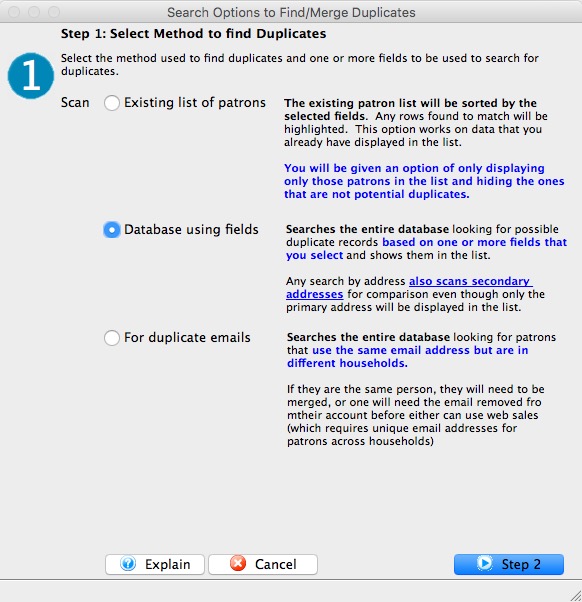 You have a choice of searching the:
You have a choice of searching the:
- current contents of the patron list for duplicates using fields you specify.
- database for duplicate patrons, also using fields you specify
- database for patrons that are using the same email address but are in different households. Two patrons with the same email address is not allowed, but could have occurred if data was imported from multiple systems and that still needs reconciling.
After that, you may want to search the list and add more fields to hone the matching criteria. You cold also search the list if you have just pulled up a large range of people such as all those whose last name starts with 'S', for example.
Select the option you wish and then click 'Step 2'
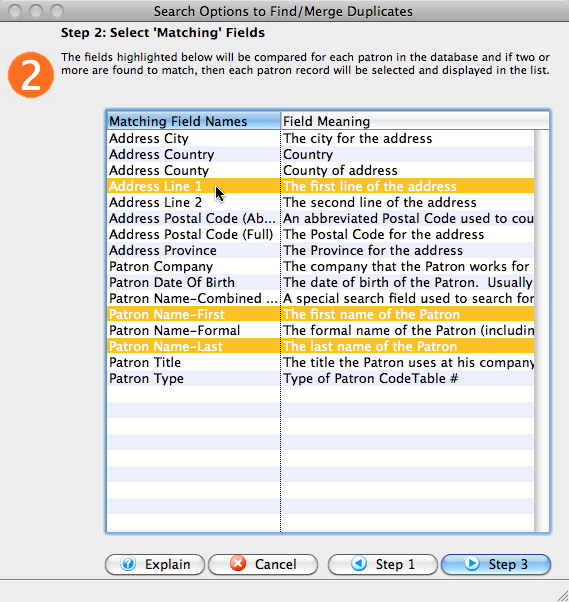
Select Fields to Match
The next step is to pick some database fields that you want to use to actually match patrons. You can use one, or more than one. For example, you could use Last Name, First Name and Address to create matches -- and ignore company if you do not consider the company field important for this particular search.
The fields above are used to IDENTIFY possible groups of patrons. They will appear in the list as highlighted.
When done, click step 3.
Indicate if You Want to Merge (or Not)
If you do not wish to merge, then click 'Manual'. You might choose this option the first time to identify records that might be possible duplicates and review them. Even if you only identify the possible duplicates, you can use the 'merge' button on the patron list to manually merge them.
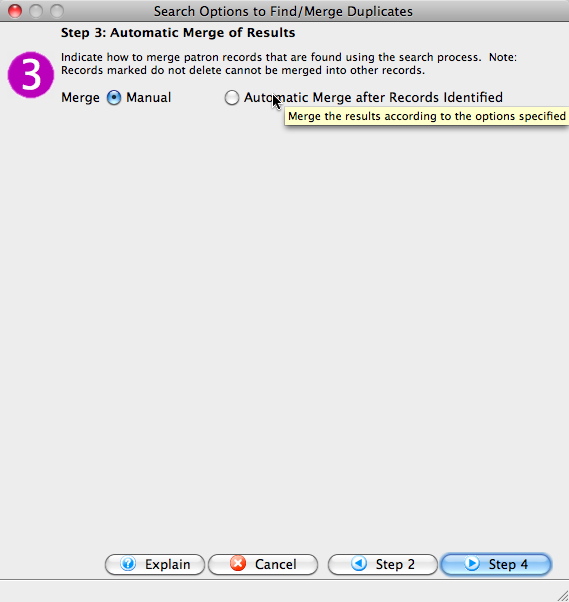 |
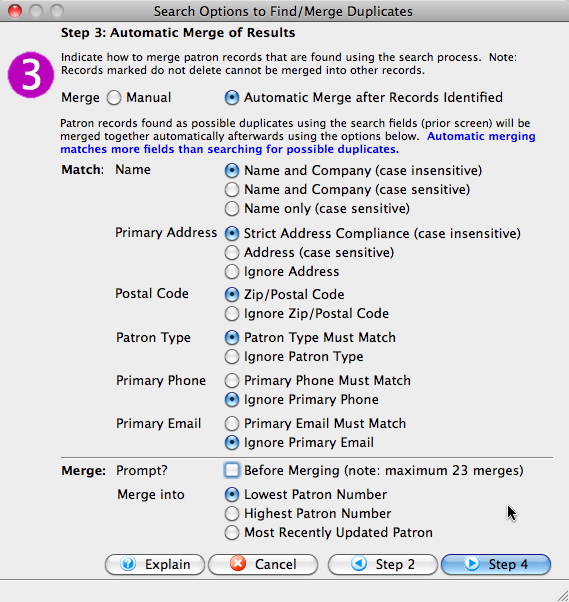 |
However, if you wish to automatically merge patrons that are IDENTIFIED as matching using the fields in step 3, you can click the 'Automatic Merge after Records Identified'. If you select this option, the lower part of the screen changes so that you can specify other options to use for matching records before a merge is possible.
The important thing is that step 2 IDENTIFIES records that MIGHT match (say using last name and address) and Step 3 indicates from those in step that a merge can only occur if last, first, address, zip, patron type and phone number match. Step 3 should generally indicate MORE fields than step 2.
After selecting fields to match on (or ignore), then at the bottom indicate if you want TM to
- prompt you for each match (this process can only open up to 23 windows) due to memory constraints) -or-
- you can have Theatre Manager automatically merge data that matches and it could do a lot of records. Use this option if you have fairly conservative matching criteria (i.e. use a lot of fields) and you have a lot of data that you might have just imported.
If you want TM to automatically merge, then indicate how you want TM to pick the patron number to merge into. The general rules for merging a group of possible duplicates are:
- TM will always merge into an employee if one is in the group -or-
- If no employee exists, then TM will look for any patron that is marked as 'do not delete' and try to merge into that patron
- If neither scenario above exists, then TM will merge into the lowest, highest, or patron with the most recent change, depending on what you selected.
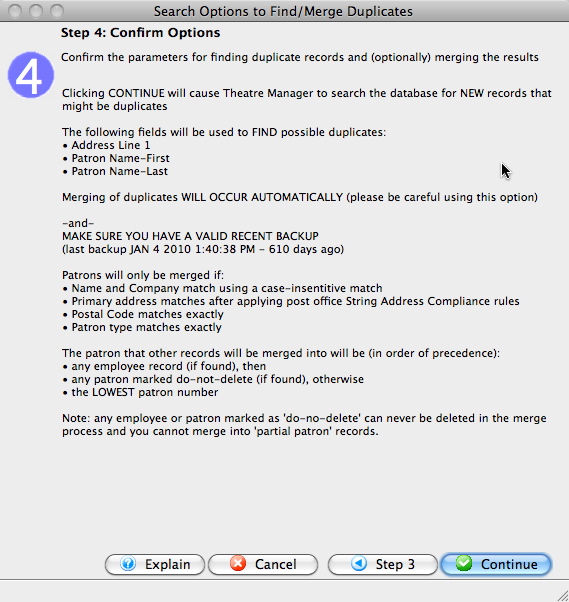
Review the Actions You've Requested
Finally, TM will show you a description of exactly what it its going to do including:
- If you are searching the database or the list
- The last known backup date
- The fields used to IDENTIFY possible duplicate records
- What fields are used for merging patrons together -and-
- How TM will decide which patron to use to merge into
Review the Actual Results
The results of a duplicate search may differ depending if you searched:
- by one or more fields in the database or list
- looking specifically for duplicate email addresses
Errors during the merge process
 |
Occasionally, you may get some errors during the merge process that prevent the merge from finishing. Please review the message closely and see if it compares to some of those below. |
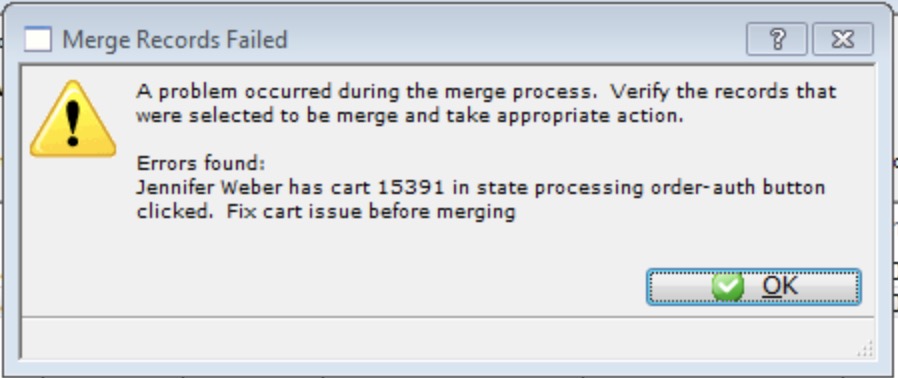 You receive an error that the cart cannot be merged because there is a problem with a past shopping cart that did not complete correctly. Refer to
You receive an error that the cart cannot be merged because there is a problem with a past shopping cart that did not complete correctly. Refer to closing carts to reset the status and then remerge.
Merge Results-Duplicate Patron Search
It is suggested that you only show the possible duplicates in the list. If you chose to leave others within the list, they will show between the groups in their original colours.
Merge the resulting list according to:
- whether the patron is the same person -OR-
- if they should be in the same household
- or ignore if the data is correct
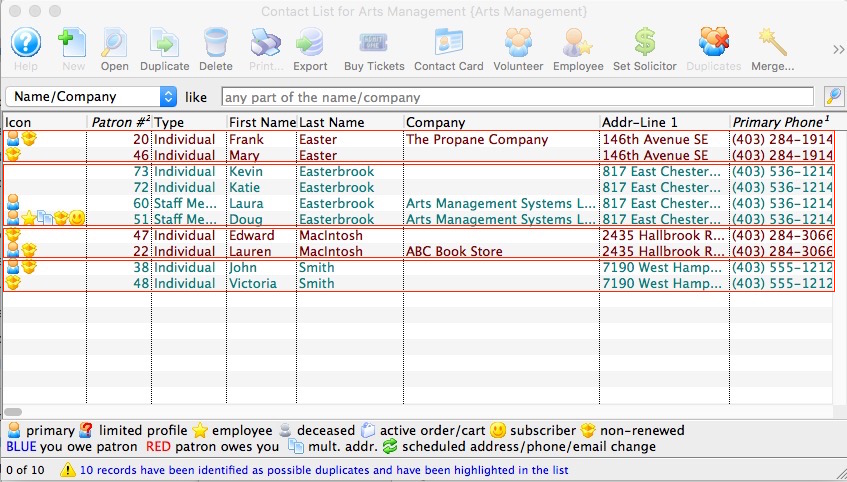
Merge Results-Email Search
- Two (or more) patrons in different households could have the same primary email address.
- Patrons in the same household could have the same email address twice in their contact record, possibly as a result of a part merge.
- Two (or more) patrons in different households could have the same secondary email address, a less obvious situation
If any of the conditions above are found, then you will get an advisory message like the one below indicating how many records of each type were found.

Viewing the Result Window
On the result window, they are shown differently

Interpreting the results - which of three actions to take to correct the problem
Examples of:
- A red '-' icon at the beginning of the line indicates:
two (or more) patrons in different households that have the same email address is indicated with the red square in the image above. Follow the link to see the suggested course of action when this condition occurs.
- A triangle at the beginning of the line usually indicates one of three sub-conditions.
- a single patron with the same email address twice in their contact record.
- A single patron with multiple links to the same email address. Simply opening the patron window will fix this.
-
Patrons in different households with duplicate SECONDARY email addresses in their contact record.
These patrons are harder to identify because they have multiple email addresses and need a secondary search to find the other patron (who may also have a triangle in their record in the list). If you also include the column 'All Email Addresses' in the list (see image below), you may be able to see who has duplicate secondary addresses with other patrons.
Hint: use *
to find a name within the list, then '+' to see the next match
What if customers or patrons complain that they didn't get emails?
 |
The first place to look is the Manage Pending/Unsent Emails screen to look at the error messages behind the emails that did not get sent. You can look at the error message column, or double click on individual emails to look at the error message tab.
The second possibility is that they requested a password reset for an email that does not exist or exists twice. Refer to patrons who request password resets and claim they didn't get an email. |
Same Primary Email-Different Patrons

Two (or more) patrons in different households with same PRIMARY email
If the example is two (or more) patrons in different households that have the same primary email address, it is indicated with the red square in the image above. They will have a red '-' icon at the beginning of the line. Suggested course of action when this condition occurs is to do one of:
- If a colour coded group of patrons are really the same person or should be in the same household, merge them
- if the patrons are very different people, then edit one of the patrons and remove the email address from their contact record. If the patron is limited profile, then you will need to do it from the contact tab on the patron record if you need to avoid providing all data for a full patron.
Same Patron/Household-Same Email

A single patron household with the same email address twice
 If the list shows a Caution icon at the beginning of the row, the most likely cause is a single patron (or household) with the same email address twice in their contact record.
If the list shows a Caution icon at the beginning of the row, the most likely cause is a single patron (or household) with the same email address twice in their contact record.
The first course of action for these patrons is to:
- edit their contact information in the contact card
- Use the Add button to add an existing email to a patron. Only continue if you see the duplicate email in the popup list under add email address.
- Once the duplicate email has been added to their account:
- Change that email address to be obviously different. eg, if the email you just added was 'doug@abc.com', edit it to be 'xxxdoug@abc.com' - something visually and obviously different.
- The patron will now have both 'doug@abc.com' and 'xxxdoug@abc.com' on their patron contact card.
- note: This is the only time you will type over top of an existing email address to as you try to fix the problem.
- remove the email 'xxxdoug@abc.com' from the patron's contact card.
- If there are other patrons in the household
- look at the emails on their account and remove any that now say 'xxxdoug@abc.com'.
- If you do remove the one called 'xxxdoug@abc.com' from that patron, then use add and select the one from the list that says 'doug@abc.com' using the add button.
- Note: The reason to do this is because the patron previously had the old (duplicated) copy of the email address that is no longer desired.
- If the above:
- worked perfectly, then run the duplicate search by email again to see if the duplicate email still exists.
- did not work, then try:
- looking at other household members to see if they have the duplicate email address -or-
- Looking to see if another patron has the same secondary email address as this patron, especially if the patron you are looking at has two email addresses
- contact support and we will help you find it.
 |
If you do not see duplicated email addresses in the patron contact window
look at all emails addressess associated with the household and follow the procedure below to make both emails visible. |
Same Secondary Email-Different Patrons

Multiple Patrons with the same SECONDARY email address
Examples of:
They patrons will have more than one email address associated with their record and the duplicated one is the non-primary.
If the cause of the duplicate is non-obvious, the course of action for these patrons is to do one of he following:
Option 1: show secondary address
If you also include the column 'All Email Addresses' in the list (see image below), you may be able to see who has duplicate secondary addresses with other patrons.
- Hint: use *
to find a name within the list, then '+' to see the next match. - then follow the some of the suggestions below for merging patrons or remove an email address from the patron it doesn't belong to.
Option 2: Search by email address from duplicate list
- Copy the secondary email address in the account to the clipboard
- Click the patron button on the toolbar
- Change the search to be by Phone/Email/Web
- Paste in the email address from step 1 and click search.
- If this yields two or more patrons, the solution can be one of the following:
- Merge people with somewhat similar names and emails into same patron -OR-
- Merge people with similar last names or a known relationship to each other into same household -OR-
- If the patrons have no known relationship to each other, then remove the email from one of the patrons - the one who is most likely not to own it. If it is unclear who might own the email adddress, contact the patrons to get clarification.
 |
You may have to do some analysis and contact patrons to find out who should rightfully have the email address, or to find out if patrons are the same or related before choosing an action. |
Merging Patrons Into Same Person

The Merge button on the patron list window gives you the option of combining the highlighted patrons:
- Into a single patron when the majority of the information indicates that the two records are for the same person -or-
- Into a common household (for example you searched for the same address and are merging patrons into a household record)
 |
|
Rules that prevent patrons from being merged are:
- They are marked 'do not delete'
- They are an employee in any outlet
- They have an order in the middle of being sold
- They have shopping carts that have one or more of the following status codes
- Active
- Auth button clicked
- Processing a payment
- Filling the order after payment accepted -or-
- The cart has a partially completed checkout with some error condition that must be fixed before the patron can be merged.
- You cannot merge a patron with complete information into a limited profile patron record - but you can merge as many limited profile patrons into each other or into a full patron record.
 |
Limited profile patrons are not recommended - but you can enable the feature
Setup->System Preferences->Mandatory Data if desired |
Merge into a single patron
When the 'merge' button (above) is clicked and into a single patron is selected, you will see a dialog similar to below asking you to confirm the merge. In the example below, it looks like Jim and James are the same person.
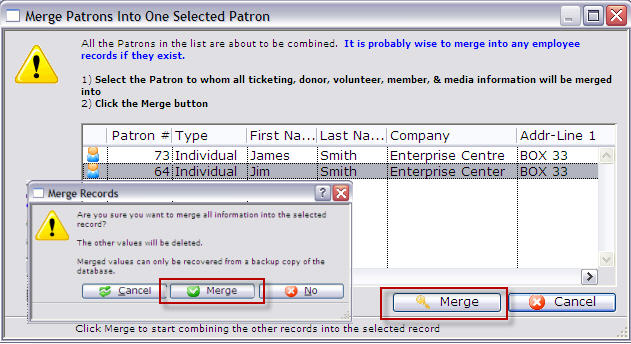
- Select the Patron to which appears to have the most correct information and click the Merge
 button.
button.
The Merge Records dialog opens.
- The dialog asks you to confirm your choice.
Click the Merge
 button.
button.You are returned to the Contact List window and the Primary patron remains In our example, there is now a single patron record for Jim Smith, containing the data added and tickets purchased with the other Patron number.
Merging Patrons into One Household
Theatre Manager is designed to keep all information about a patron on one record. You can merge patrons into the same household. To merge two patrons into the same household, you perfrom the following steps:
- Open the Patron List and find the patrons to be merged into the same household.
- Highlight the patrons to be merged and click the Merge
 button.
button.
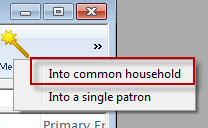
- Click Into Common Household.
The Combine Patrons into a Single Household window opens.
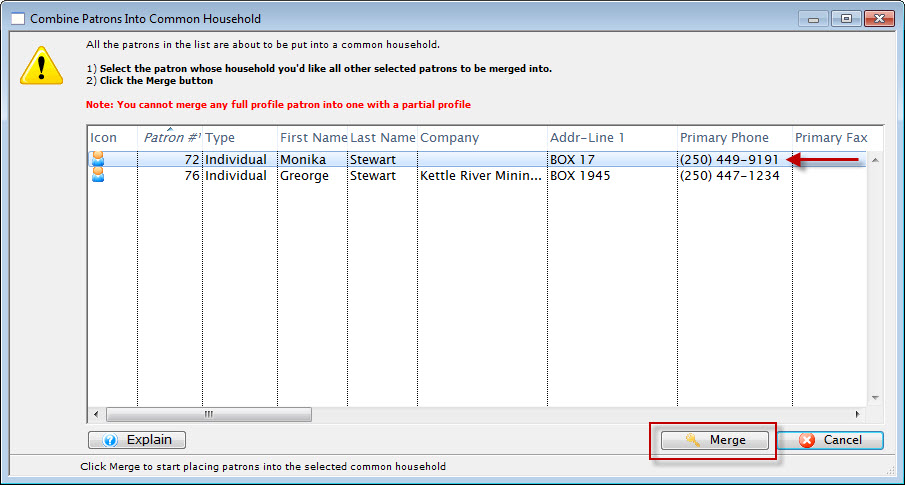
- Select the Patron to be the Primary Patron you would like all of the other patrons to be merged into.
- Click the Merge
 button.
button.
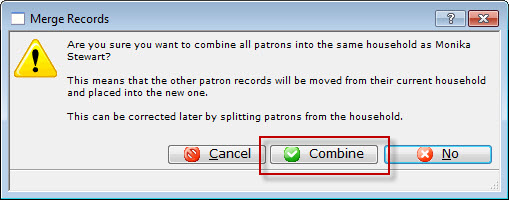
The Merge Records confirmation dialog opens.
- Confirm you indeed want to combine the patrons into a single houslehold by clicking the Combine
 button.
button.
The two patrons are combined into the same household.
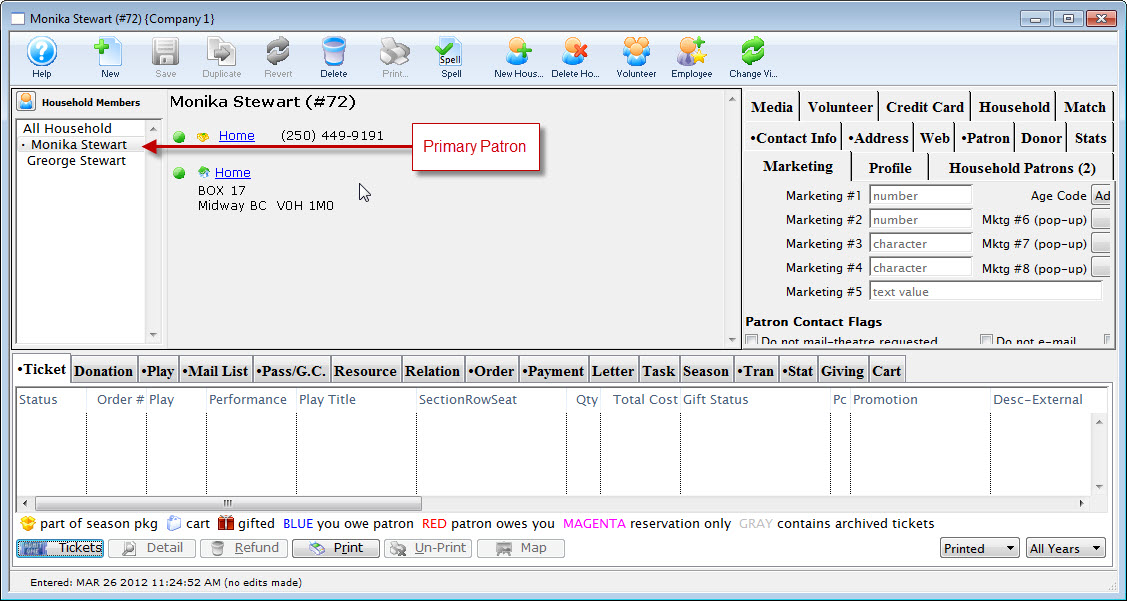

The Patron Window
The Patron window is the main interface used in Theatre Manager. The patron window can be opened in the following two ways:
- Clicking on the Patron
 button in the main Theatre manager toolbar / ribbon bar.
button in the main Theatre manager toolbar / ribbon bar.
- Use the Patron Sales menu and clicking on Patron.
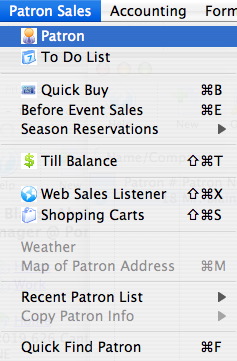
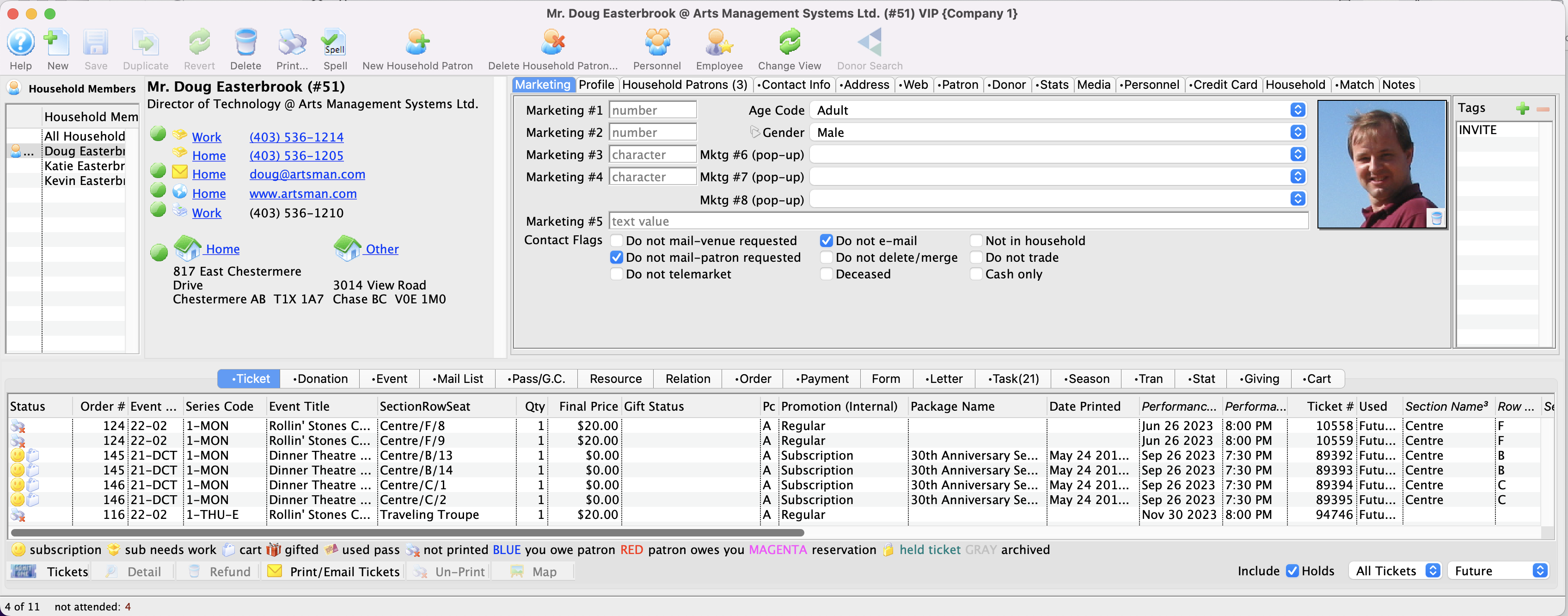
The main sections are listed below. Click on a link to learn more about the features.
Patron Window Buttons
 |
Inserts a new Patron. Click here to learn more about inserting new patrons. |
 |
Saves changed made in the patron window. |
 |
Unavailable in the Patron List window. |
 |
Reverts the patron window data back to the last save point. |
 |
Deletes the patron. For more information click here. |
 |
Prints the selected record. |
 |
Completes a spell check of the patron record. |
 |
Inserts a new member of the current household. Click here to learn more about inserting new household members. |
 |
Deletes a member of the current household. Click here to learn more about deleting household members. |
 |
Changes the current view or layout in the household portion of the patron window. |
 |
Opens the volunteer history for the selected patron. To learn more about this feature click here. |
 |
Clicking the Employee button, makes the current patron and employee. To learn more about adding employees click here. |
Patron Data
For more information on Patron Data click here.
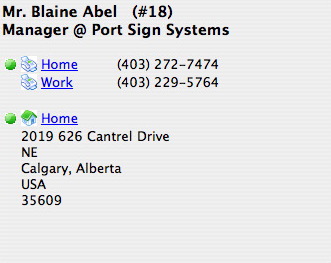
Patron Window Tabs
There are two different sets of tabs on the patron window. There are the Patron Detail Tabs which harvest information about the actual patron, their personal details, and other information that relates to them as a person. Whereas the Patron Account Tabs carry information significant to the patrons account, their tickets, orders, contact history, and transactions.
Patron Detail and Account Tabs

There are two different sets of tabs on the patron window. There are the Patron Detail Tabs which harvest information about the actual patron, their personal details, and other information that relates to them as a person. Whereas the Patron Account Tabs carry information significant to the patrons account, their tickets, orders, contact history, and transactions.

Click here for more information on the tabs.
Changing the View of Patron Window
There are 3 distinct views of the patron window.
Option 1
(standard – popular view)Full view includes patron personal information - contact card, patron detail tabs - marketing tabs and patron account tabs – ticket, donation and pass purchases, orders, relationships, season packages, online shopping carts and more.
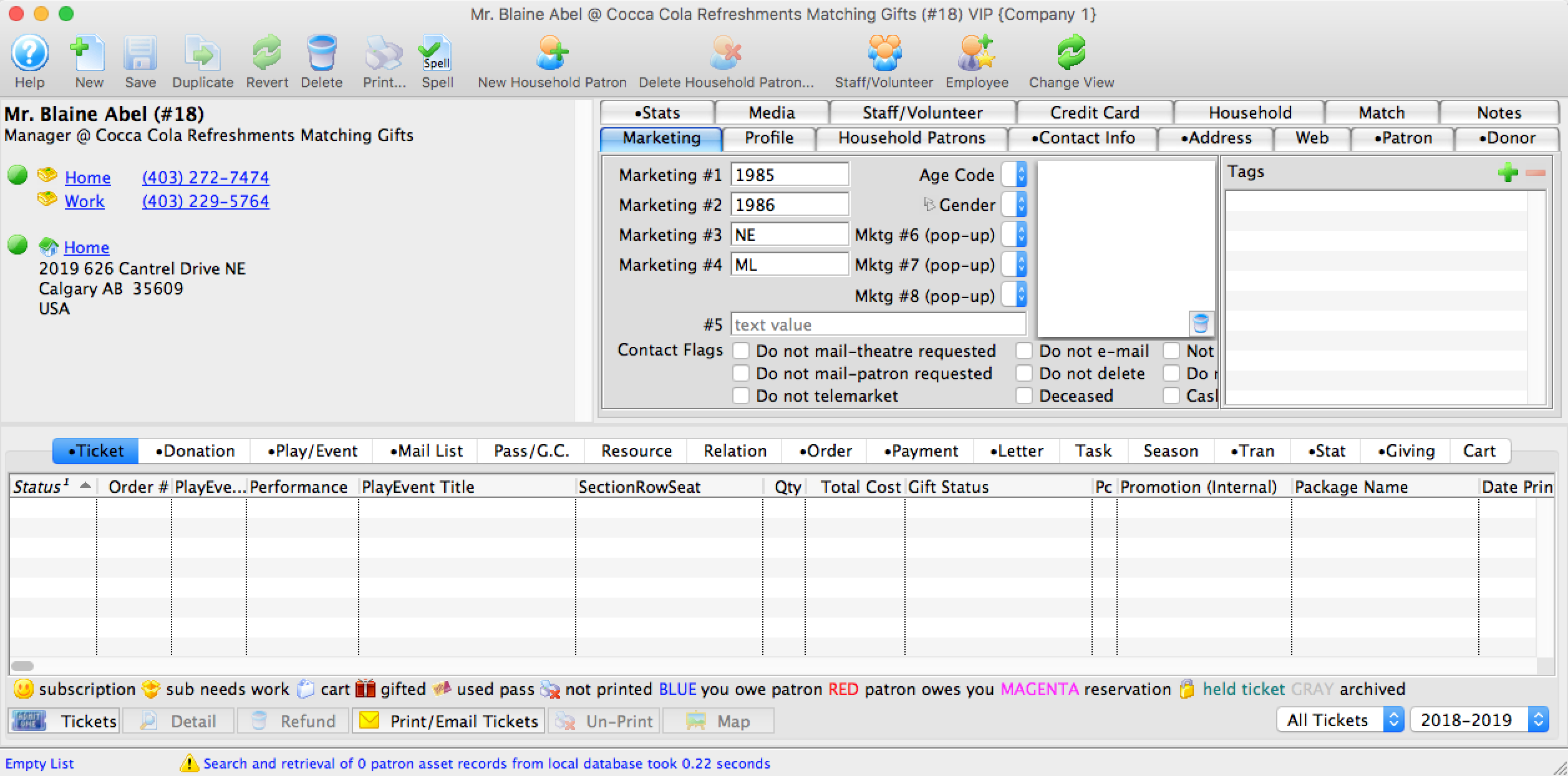
Option 2
View includes only the top half of the patron record, which includes patron detail tabs – marketing tabs.

Option 3
(good when just selling items to patrons)View includes only the bottom half of the patron record, which includes patron account tabs – ticket, donation and pass purchases, orders, relationships, season packages, online shopping carts and more.
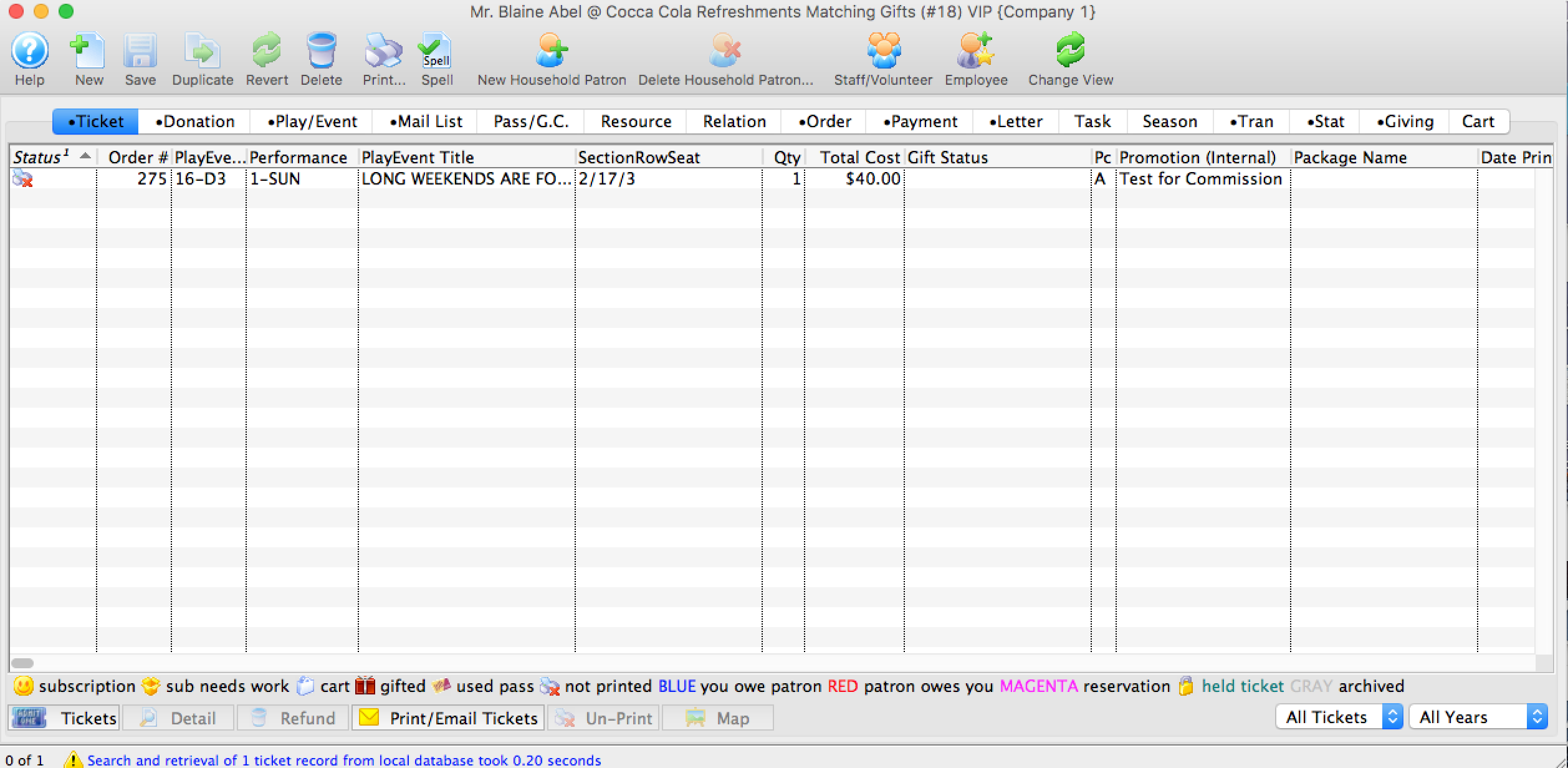
To change the view of the patron record click on the ‘Change View’ button 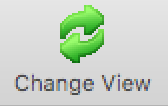 located in the toolbar of the patron window. This button toggles; keep clicking until you find a view you like.
located in the toolbar of the patron window. This button toggles; keep clicking until you find a view you like.
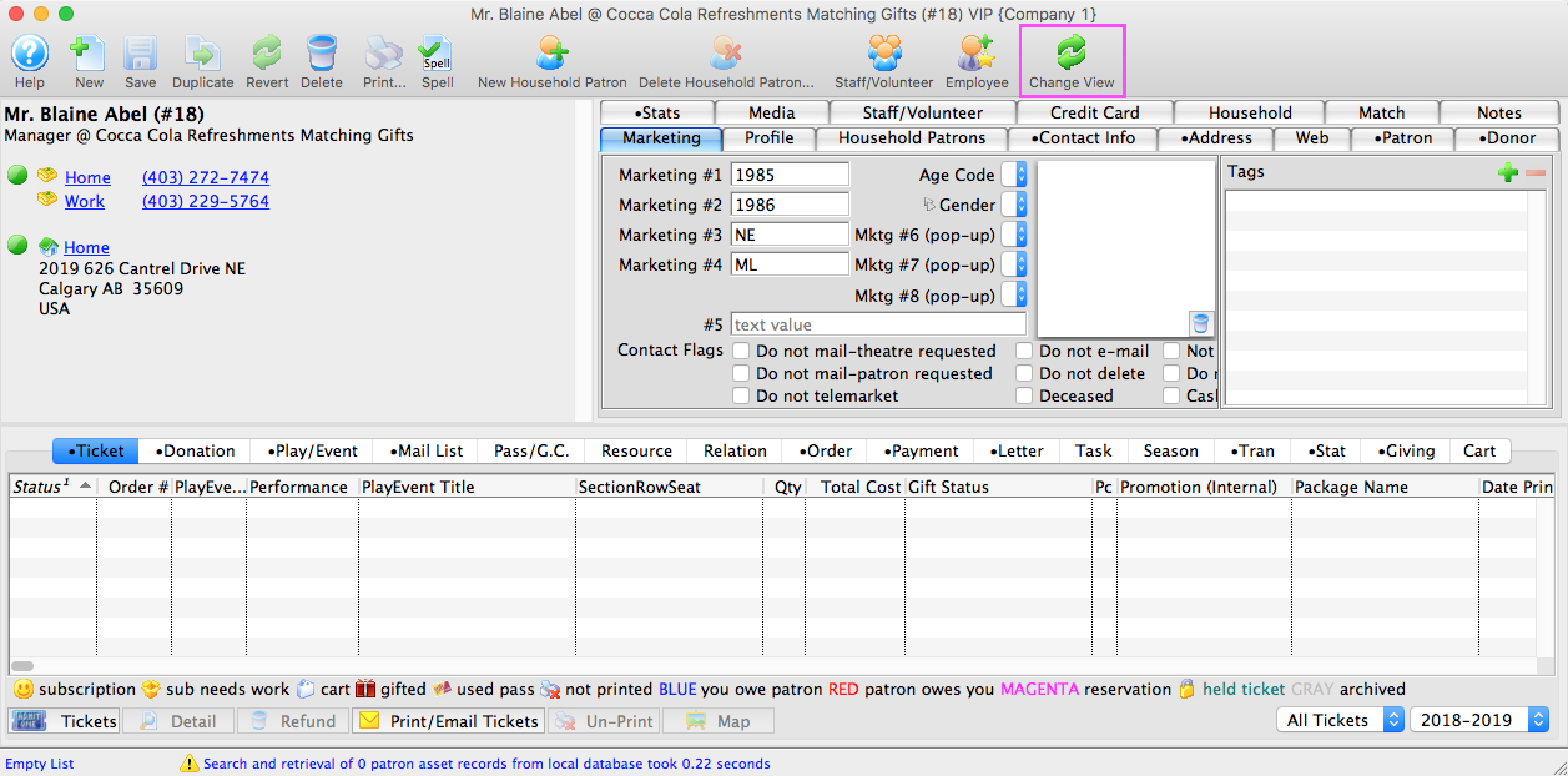
Detail and Account Tabs
- The Patron Detail Tabs on the upper right contain marketing information about the patron, which can include personal details, birthdays, key address and contact info. Data in the details tab is considered optional - to be enhanced as you get to know the patron. This data can be used as criteria for mail lists and reports.
- The Patron Account History Tabs at the lower part of the screen generally contains transactional information significant to the patrons account such as their tickets, orders, correspondence history, meetings, donations and transactions.
Patron Detail Tabs
The patron detail tabs are located in the upper right hand corner of the Patron window. The Marketing Tab is automatically selected when a patron window is opened unless the VIP checkbox is clicked on the patron tab. If it checked, the window will default to the patron tab to show the patron notes.
In some instances, one of the tabs may have a bullet prior to its name. The bullet lets the user knows that there is information stored in the tabbed field. For example, entering information in the donor module causes a bullet to appear in the Donor Tab.
Patron Account Tabs
The account tabs are at the lower part of the patron window.
In some instances, one of the tabs may have a bullet prior to its name. The bullet lets the user knows that there is information available in that tab. For example, the 'Trans' Tab in the above picture has a bullet prior to its name meaning there is information contained in that section.
Detail Marketing Tabs
Marketing Tab

The Marketing Tab displays the marketing details for the current patron. These fields are useful in capturing additional ‘specific’ yet common information about patrons that can be used in the future to create a target market group. Often these fields are used to record information about a patron origin to the database, status, programming preferences, organization affiliations etc. Note that the same data appears on the Volunteer window
This information can be used in a query to collect this group of patrons for a direct marketing purpose.
Parts of the Marketing Tab
Personalized Marketing FieldsThere are restrictions on the content of the marketing fields. This is not customizable. These fields are not intended to capturing large amount of information on any given patron but rather short “common denominators”. It is necessary to restrict these fields to that data collected is consistent throughout each patron file. The following list details the restrictions of each marketing field. |
|
| Marketing Field One | This field is a numeric field, restricted to 30 numbers and is searchable. |
| Marketing Field Two | This field is a numeric field, restricted to 30 numbers and is searchable. |
| Marketing Field Three | This field is an alphanumeric field, restricted to 10 letter/digit combination and is searchable. |
| Marketing Field Four | This field is an alphanumeric field, restricted to 10 letter/digit combination and is searchable. |
| Marketing Field Five | This field is an alphanumeric field, restricted to 60 letters/digit (including spaces) and is not are readily searchable. |
| Age Code | This field contains a pull down menu, which can be edited in the Age Codes tab in Code Tables. Click here for more information on Age Code Code Table.. |
| Marketing Field Six (Pop-up) | This field contains a pull down menu. This menu is created in the Marketing #6 tab in Code Tables. Click here for more information on Marketing Field #6 Code Table. |
| Marketing Field Seven (Pop-up) | This field contains a pull down menu, which can be edited in the Marketing #7 tab in Code Tables. Click here for more information the Marketing Field #7 Code Table. |
| Marketing Field Eight (Pop-up) | This field contains a pull down menu, which can be edited in the Marketing #8 tab in Code Tables. Click here for more information on the Marketing Field #8 Code Table. |
Patron Contact Flags |
|
| Do Not Mail - Theatre Requested | Used when the company decides it will not mail particular patrons. That is, the company may have lost contact with a patron or it is not necessary to mail board members. |
| Do Not Mail - Patron Requested | Used when a patron asks the company not to mail them. |
| Do Not Telemarket | Used when a patron requests not to be Telemarketed. |
| Do Not E-mail | Used when a patron does not want to be contacted via E-mail. |
| Do Not Delete | Used when the patron is never to be removed from the database. This also prevents the patron from being merged with other patrons. |
| Deceased | Used if the patron has passed away. These patrons cannot be printed on labels or emailed to |
| Not in Household | Used if the patron has left a company but there is a lot of data that should remain with the company. In a sense, acts like deceased, but is clearly marked different. These patrons cannot be printed on labels or emailed to |
| Do Not Trade | Used when the patron does not want their contact information traded with other sources. |
| Cash Only | Used when the ONLY payment method accepted for patron is cash.
Credit cards or checks are no longer accepted. If the patron attempts to buy online using their account, any credit card they enter as a payment will respond back as if it were declined - effectively preventing them from buying online. If the patron calls in, you can still take over their shopping cart and complete the sale.
Employee functions settings, have permissions to indicate who can
|
| Gender | Used to allocate a patron's gender as being one Male, Female or Unknown. The gender can be manually flagged here or automatically flagged when a salutation is applied to a patron's record. The setup of salutations in the codes allows for a gender to be allocated. Gender can be used in search criteria for reports, exporting and mail lists. | Patron Photo | You can drag and drop an image of the patron onto the patron's record. For more information on image size and types click here. |
| Tags | You can add any number of tags to the patron. |
Uses for custom Marketing Fields
- 2 are alphabetic
- 2 are alpha/numeric
- 1 is a Text field
- 3 are drop-down lists
- one field, Age Code, is predefined in Theatre Manager.
These fields can be custom labeled to reflect the information chosen to record. For more information on customizing the marketing field label please click here.
It is not always easy to initially define a use for these marketing fields. The following examples come from practical uses that our customers have made of them.
Source: Most users will set aside one field for 'source'. Specifically, a code that indicates how the customer first came to be in the database. This can be useful when analyzing marketing efforts. For example; if the local paper is called 'The Rag' and the organization advertises in it weekly, number the ads as 9701, 9702, etc. for each ad in 1997. If the customer first came to be in the database because of ad #4, their source would be TR9704. This allows examination of the effectiveness of different media, ad placement, size, etc.
Year Youngest/Year Oldest: For our children's theatre venues, some keep track of the year when the youngest was born. This allows them to manage the transition of their 'little' customers through the theatre seasons. There comes a point when children feel they are to old to come to shows and would rather be with their friends ... until they have children of their own and the cycle begins again and the organization can now market to Grandma!
Government Officials: City/municipal, Provincial/State, Federal. This could be a marketing field to record the patron’s political affiliation. At a glance the system can produce a list of all patrons who are Federal Officials. Create a mail list of these patrons for special invite purposes etc.
Genre: Comedy, Drama, Musical - useful to record a patron overall preferences or type of performance they generally like to attend. However, using a Mail List to maintain this information is more beneficial.
County/Township: A marketing field used to record the county for patrons. Information that is not readily recorded in the address section and could be useful for grouping patrons based on their location.
Patron Type: A marketing field used to record the type of patron account. For example, corporation, foundation, granting agency, individual, school, etc.
School District: A marketing field used to record the school district and age category for patrons. Information that is not readily recorded in the address section and could be useful for grouping patrons based on their location and age category.
This is really general but certainly there is no limit to the types of marketing fields that can be created.
Marketing Ideas
Marketing to the Customer
Marketing really depends on the buying habits of the customers. Good things to assist the process are:
Sell the next season during the last show of the previous year. If the organization had a good show/season , it is easy to pick up 20% or more subscribers for the next year. Make sure that the price that the subscriber can buy for is the lowest possible (e.g. do not invent a discount to be used later in the year that makes the early subscriber think that they should have waited). Typical discounts for early season subscriptions is 20-25% or 5 shows for the price of 4. Something that will enhance those sales is a deadline where regular subscription prices are only 10-15% discounts.
There is usually a local paper section that everybody reads for movie listings, entertainment guides, upcoming events. Choose that paper and advertise in it. A suggestion for a season that starts in the fall is to put something in the paper that coincides with early renewals -- it can usually be included with advertising for the last show of the previous year.
Decima Research (A Canadian study in the arts industry in the early 1990's) indicated that 50% of the people make their buying decision 4 weeks in advance of the show. So for a 4 week run, start advertising 4-5 weeks in advance and throughout the show. Also, most people read a specific days newspaper. In Calgary, the 'Scene' comes out on Friday - so Friday is an extremely good day to advertise; followed by a Tuesday advertisement.
People listen to radio on the way to work; so a contract deal with a local radio station for a few free tickets for a caller as long as the giveaway is done during the morning driving hour is a good thing. Depending on the type of theatre, give away a show package that is less than the average number of attendees - so that they will be compelled to buy one or more tickets. (e.g. For children's theatre, the average attendance is 3.5 (one adult and 1-3 children, so give away only two tickets).
Getting names in the database is very important for direct mail. Good 'guerrilla' tactics are:
Have a draw for a meal for two at a local restaurant - but the patron must provide name, address, telephone number, etc. Drawing is done on the last performance. Now the names can go into the database. Chances are the local restaurant will give the organization the meal in exchange for some tickets.
Use a 2 for 1 coupon book and make the coupons valid for slow performances (e.g. Wednesdays or Thursday). Some people will do anything for a discount and the organization gets their name.
Do some co-op advertising with a local business and use their mail list. A clothing store or electronics place where they record names is a good thing - ideas may include 10% off a tie with purchase of a ticket or 10% of a ticket with purchase of a tie -- they do the mailer with the theatre's flyer and everybody wins.
Organize some special days where the people get to interact with the production people. Examples are:
Talk back to the director day.
Special award night.
Autograph day for the kids where actors sign for the kids in the lobby.
Sleep-overs in the theatre (the organization can charge a bundle for the tickets).
Theatre Tour and wine tasting night.
Remember to use a mail list. Once people buy, target them for similar shows and they will buy again. They just need to be asked. A telemarketing campaign to people on the list who have not yet bought subscriptions during the last show and before the early discount arrives is a very good thing. Best time to get people is between 5:00-8:00pm. And the caller needs to have a good script like:
Noticed you came to our show for the first (or second) time...
How did you like it...
Anything that would have improved your experience and made it more enjoyable...
Would you like to be our partner next year and come to all shows...
etc., etc., etc.,
It's all about building a personal relationship with the customer.
Determining When the Customer will Buy
The ideal time to sell tickets is dependent on the customer base purchasing habits. Evaluate if the customer base plans out their activities, or whether they wait until the last minute to make a purchase decision. Once the organization determines the purchasing habits, then determine the most effective time to advertise the event, at which time, be prepared to start selling tickets. There is no need to advertise unless the customers are in a situation to buy.
The organization may find that people typically buy tickets first thing in the morning (e.g. 9:00 am), over an extended lunch hour (11:30 am - 2:00 pm) and there is always a rush before 5:00 pm. In the hour before the event, there will be walk up sales so plan on having the box office open at least an hour and a half before the event starts.
For a large community or city where there is competition with other events, start advertising and selling tickets 6 to 8 weeks in advance to insure that they purchase the organization's tickets first before another organizations tickets. For a smaller community or town where there is less competition with other events, start advertising and selling tickets 3 to 4 weeks in advance.
If the event adverting is focused for children, the organization may find that many tickets will be purchased at the last minute, as children get sick; go to birthday parties; have recreational activities (soccer, hockey, baseball) and the parents may not make a decision to go until the event is within the next few days. With events focused on adults, the organization normally can count on them more, so the organization may see that they will purchase tickets more in advance as they plan what they will be doing in the upcoming weeks.
Again, the key to determining when the best time to sell tickets has to start with knowing the purchasing habits of the potential customers and knowing the audience that the organization is trying to attract.
And remember to use Theatre Manager to assist in finding out purchasing trends. Theatre Manager's cash flow report tells when people buy for a show. It's very important because the organization should see two or three major humps. One at early season renewal, one in the fall when the season subscription campaign occurs, and sales start to rise about 4 weeks in advance of the show. There should be mini spikes after a prior day's advertising. (e.g. Friday should see some extra Saturday sales, or a Tuesday advertising should see some Wednesday sales). If not, move around the advertising to different days, or move around to different advertisers.
Profile Tab

This tab provides a place to save some more personal information about the patron
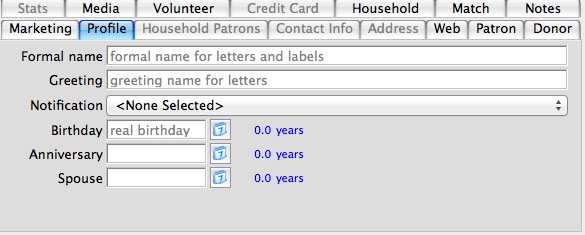
Parts of the Profile Tab
| Formal Name | The patrons formal name. The formal name is a combination of the Salutation, the First name, the Initial and the Last name. |
| Greeting | Displays the name the patron likes being called in every day life. It is quite often the patron's first name or a version of it. |
| Birthday | Date of the Patrons Birth. Use the Calendar  button to select a date or type a date in the field provided. button to select a date or type a date in the field provided. |
| Anniversary | Patrons Anniversary date. Use the Calendar  button to select a date or type a date in the field provided. button to select a date or type a date in the field provided. |
| Spouse | Patrons Spouses birthday. Use the Calendar  button to select a date or type a date in the field provided. button to select a date or type a date in the field provided. |
| Notification | Select an electronic notification from the drop down. This will send an electronically generated letter to a designated employee alerting that employee of activity in the patrons record. |
Resizing images to fit into Theatre Manager
- Placing full resolution pictures into a database rapidly increases the size of the database and affects backup times. For example: a single 5 magapixel picture takes as much room as approximately 5000 patrons in the database.
- Sending emails or eblasts with large images affects the delivery of the eblast to customers with slow internet connections or who like to receive their emails on mobile devices.
- Sending high resolution screenshots to our support team was filling our database and affecting support
We've chosen to assist you in managing your database size by limiting the size of images that can be put into the Theatre Manager database. In order to fit pictures into the image space on the PROFILE tab of the patron record, they need to reduced to under 500kb in size. Ideally, 100kb is a good target size for most images. The question is how to change a high resolution picture or screenshot into a lower resolution and then place it in a Theatre Manager database or send it as an e-blast or email attachment.
Using Image Converters
There are tools available for you to use and a fairly common shareware application is GIMP. The following describes how to use gimp on Windows. GIMP on the Mac OS requires xWindows to be installed. However, on the Mac, you can use Apple-Shift-4 to capture a specific area of the screen or use a tool like Snapz Pro (not free) which we use for our documentation.
GIMP (GNU Image Manipulation Program)
GIMP is a free download from the internet and the web site contains information about downloading, installing, using, and enhancing it. This site also serves as a distribution point for the latest releases. To use GIMP to capture a screen image and reduce its overall memory size:
In the Main Palette:
- Go to the FILE menu
- Choose CREATE, and then Screen Shot
- Click the GRAB A SINGLE WINDOW
- Use the +hand tool to grab the active window where your image resides (you will crop the window in the next step
- Use the selection tools (the dotted rectangle or dotted lasso) to highlight the desired area.
- You can also manipulate the image in any way you see fit, including flipping, rotating, or airbrushing.
Back in the Main Palette
- Go to the IMAGE menu
- Click CROP TO SELECTION
- Proceed to the FILE menu
- Choose SAVE AS
- Use the SELECT FILE TYPE to change the file format to JPG. JPGs are the only file format that will import into the PROFILE tab in Theatre Manager.
- Click SAVE
-
A window will pop up that allows you to change the Image Quality. Quite simply:
High Quality = More KB and more storage space
Low Quality - Fewer KB and soemthing that is better for storage in databases or use in eblasts - Use the slider to adjust the image quality so that the final image is under 500KB.
- Click SAVE
Household Patron Tab

This tab is used to view all members of the household.
Parts of the Household Patrons Tab
| Patron # | Unique number used as reference for the patron. |
| First Name | First name of the patron. |
| Last Name | Last name of the patron. |
| Household # | Unique number used as reference for the household. |
 |
Adds a new member to the household. For more information on adding a member to a household click here. |
 |
Opens the patron contact card. For more information on the patron contact card click here. |
 |
Deletes a member of the household. |
 |
Changes the primary contact person for the household. The primary household person is recognized by the  symbol. To set a patron as the primary of the household, highlight the patron in this window, click Set Primary button. symbol. To set a patron as the primary of the household, highlight the patron in this window, click Set Primary button. |
Contact Info Tab
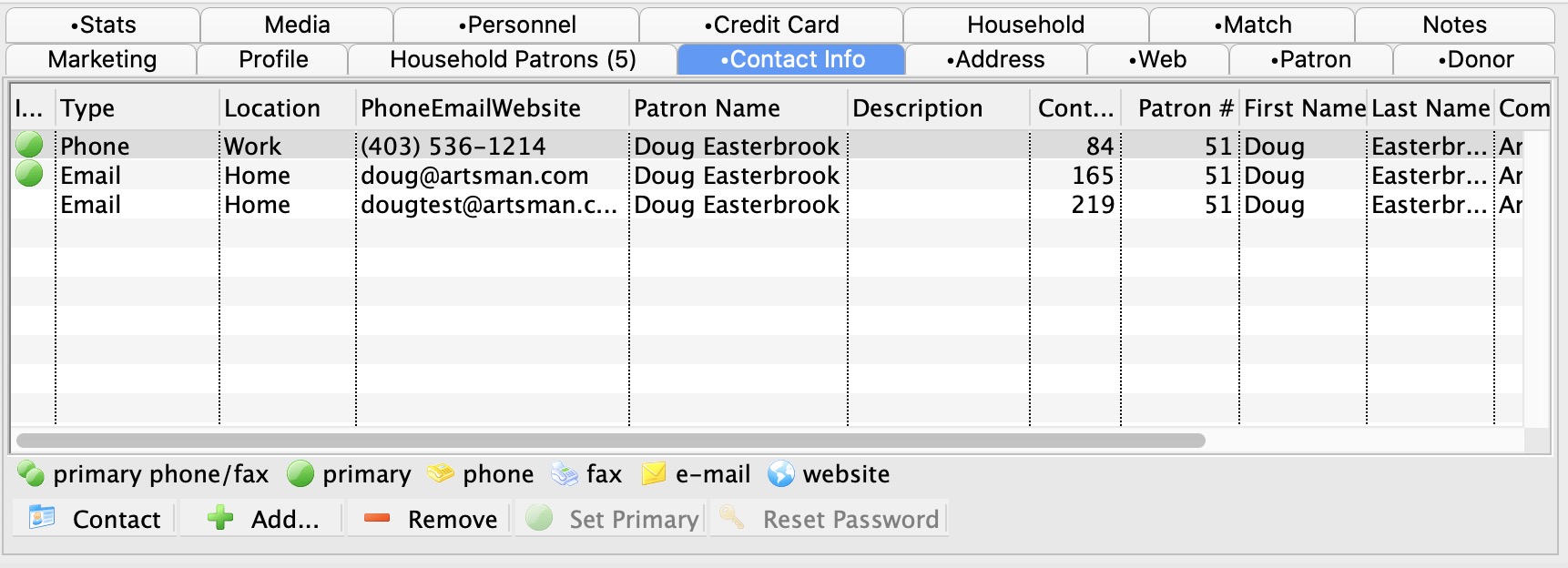
This tab is used to show all the contact information for a patron or phone, fax, email and web links. You can alter key preferences from the list or you can go to the patron contact card to add, edit or delete any of the contact information.
Parts of the Contact Info Tab
| Type | An image representing the type of contact information represented on this line. Contact data can be one of:
|
||||
| Location | The location for the patron information. This is a customizable field and the values are defined in Code Tables | ||||
| Phone/Email/Website | The detailed contact information. | ||||
 |
Opens the patron's Contact Card so that you can edit their contact information, including:
|
||||
 |
Adds a piece of contact information to the patrons record. Each selection opens another flyout to select. When you make your selection, the patron's Contact Card opens to the field selected. | ||||
 |
Removes the highlighted piece of contact information from the patron record. | ||||
 |
Changes the highlighted information to the primary contact information for the patron. The primary information is recognized by the  symbol. symbol. |
||||
 |
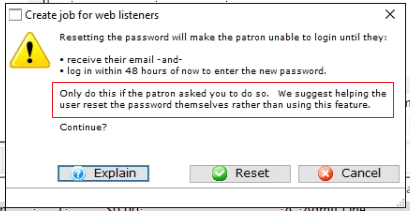 You will be asked if you want to reset the patron's email password for the email you selected.
You will be asked if you want to reset the patron's email password for the email you selected.
If you continue, this causes:
|
Patron Contact Card

The patron Contact Card is accessible without opening a Patron Record from the Contact List window by clicking on the Contact Card icon in the toolbar. It can also be opened once on the Patron Record by double-clicking on any patron name in the Household Member List window
Parts of the Contact Card

The patron contact card has three parts to it, Patron Details, Address and Contact Info.
The Patron Details area stores information on the Type of patron, their Company and Title, their proper Salutation, Formal and Greeting Names. Some of these fields maybe marked as Mandatory Data Fields and require data to be entered and can not be left blank. Mandatory Data Fields are located in Company Preferences.
The Address area stores patron mailing information; their Address, City, State/Province, Country and Zip/Postal Code. A Patron can have many different addresses stored here as need. Some examples: a patron may have a winter home, summer home and several work addresses. Some of these fields maybe marked as Mandatory Data Fields and require data to be entered and can not be left blank. Mandatory Data Fields are located in Company Preferences.
The Contact Info area stores information on how to reach a patron by Home Phone, Work Phone, Mobile/Cell, Home Fax, Work Fax, Home Email or Work Email. There can be as many lines of contact information as needed.
Patron Contact Card - Tool Bar
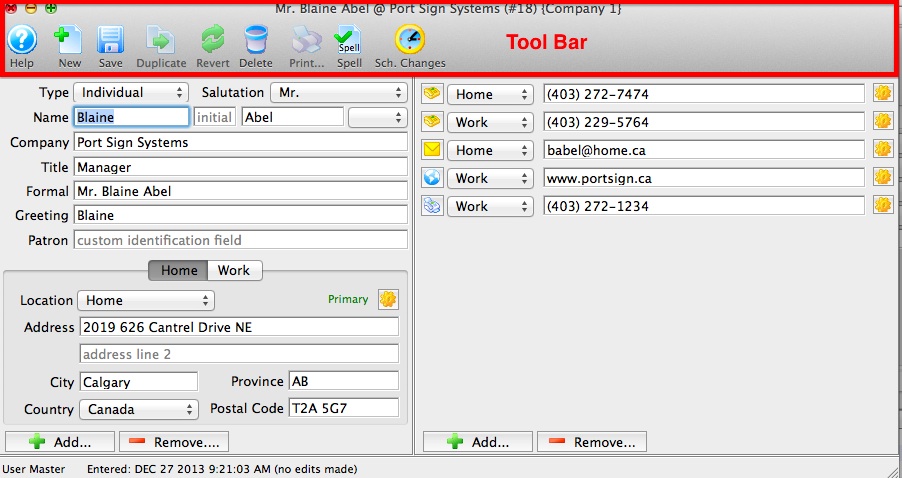
Parts of the Contact Card Tool Bar
The Tool Bar has many helpful function buttons.
 |
Connects to Theatre Manager Online Help for the Patron Contact Card. |
 |
Inserts a New patron contact card for another patron in the same household. |  |
Allows Contact Card to be saved. |
 |
Not applicable. |
 |
Returns the content/text back to the saved content/text prior to any recent changes. |
 |
Removes the patron record providing there is no financial transactions associated with the patron. |
 |
For future development. |
 |
Spell check. |
 |
Displays a list of the Scheduled Changes for the patron. |
Patron Contact Card - Scheduled Changes
Scheduled Changes Window
This window displays a list of address and contact change schedules. A patron may have more than one address where they reside during different times of the year. For example they may have a summer home and would like to receive mailings at their summer home from June to September. An address can be schedule to change from their permanent to their summer address and then back to their permanent address in September.
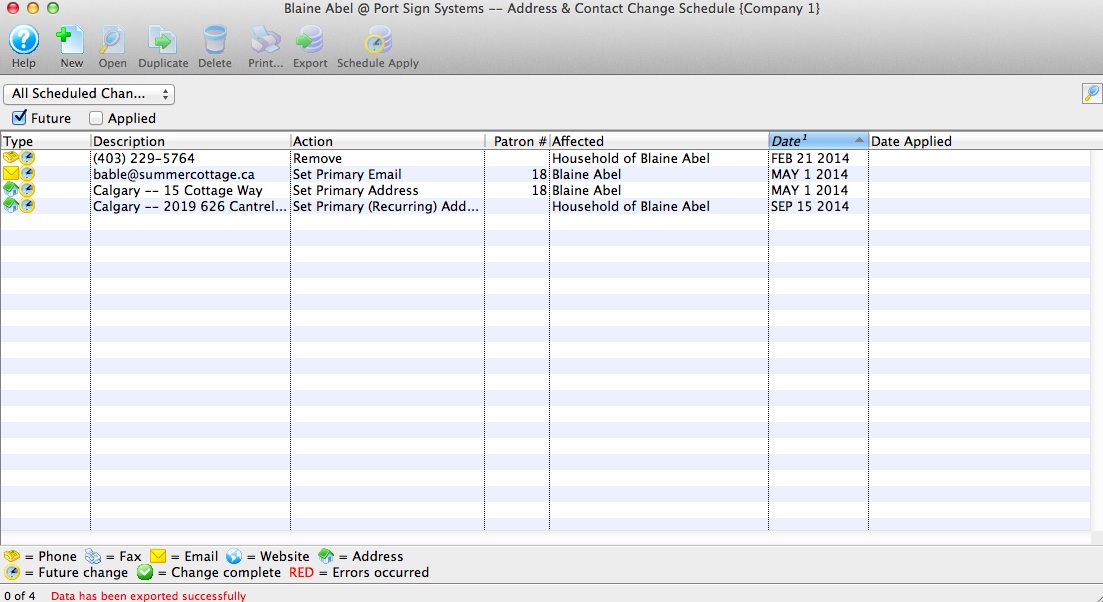
Parts of the Scheduled Changes Window
 |
Connects to Theatre Manager Online Help for the Scheduled Changes. |
 |
Inserts a New address for patron. |  |
Allows an existing scheduled change from the list in the window to be opened for viewing or editing. |
 |
For future development. |
 |
Removes the scheduled change record. |
 |
For future development. |
 |
Allows for the list of Scheduled Changes to be exported to a tab delimited or MS Excel workbook file. |
 |
Rather than waiting until it's scheduled date, the contact information can be change now. |
  |
Search criteria for Schedule Change window can be set by Date range, by All Schedule Changes, Future or Applied. |
Editing Scheduled Change
When you make a scheduled address or phone change , you likely need yo make TWO scheduled changes. For example:
- If a person is moving in the future, you would set up a ONE-TIME change for:
- The new address and the specific date in the future when you want it to be effective -and-
- some time beyond that (say a couple of months), a scheduled deletion of the old address so that it is no longer in the patron record
- If the patron is a snowbird and is regularly changing addresses, you would indicate a RECURRING change:
- for the month/day that address 1 becomes effective each year
- for the month/day that address 2 should become effective each year
 |
This feature can also be reached by using the "gear" icon next to the contact on the Contact Card |
- Use the Schedule Change button to open the Schedule Change window.

- Double click on a Scheduled Change to the selected line in the display window.

- Address or Contact Change wizard will pop up.
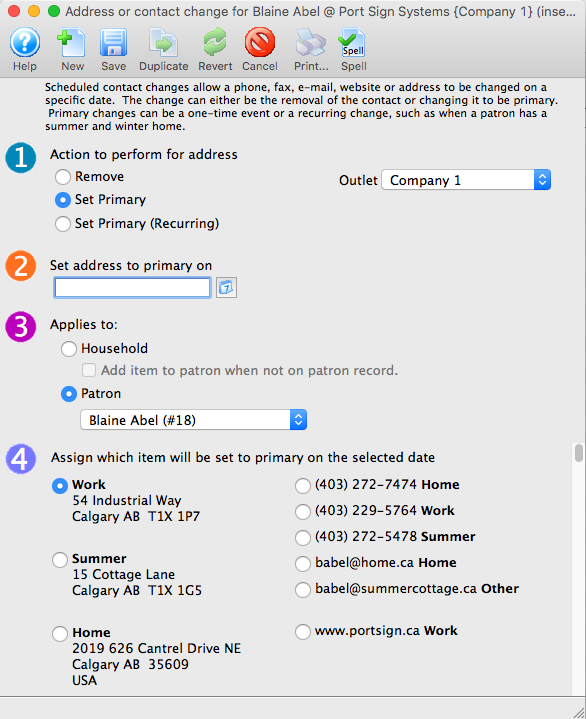
- Make required changes to any step(s)and save.
Note: In each of the 4 steps only one item within each step can be selected for change. If you need to make another change to a different contact information, simply create another New record to schedule the next change.
Apply Schedule Change Now
Rather than waiting until it's scheduled date for an automactic change, the contact information can be manually changed by using the Schedule Apply button from the toolbar.
- Use the Schedule Change button to open the Schedule Change window.

- Highlight the contact information line in the Schedule Change window.

- Click the
 button.
button.
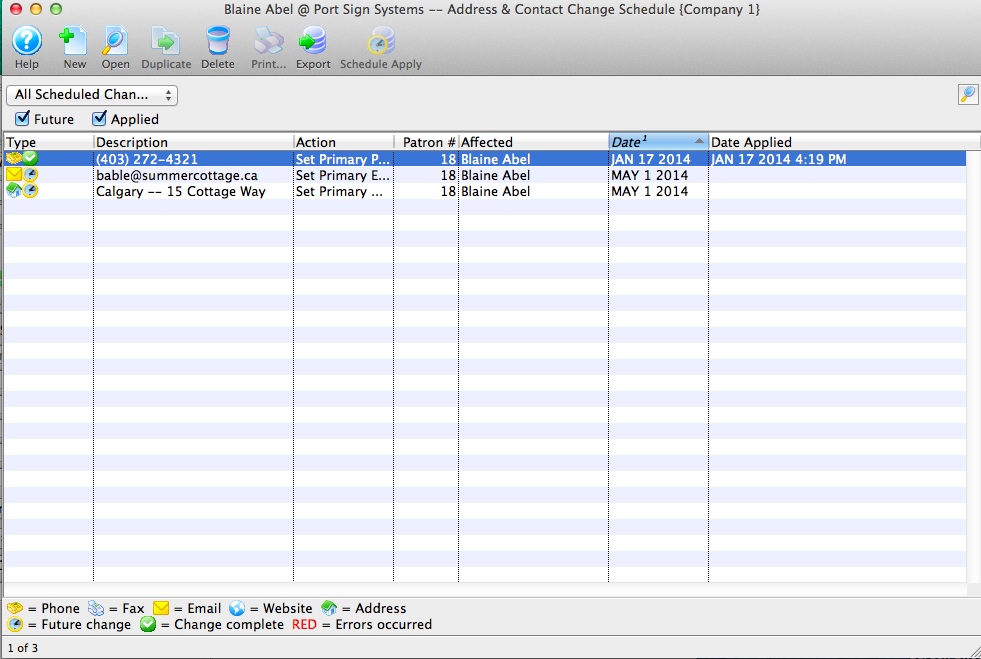
Clicking Schedule Apply button changes the effective date to be today's date. The 'Set Recurring' function will continue to exist for future scheduled effective dates, even though the contact information has been updated through this process.
Exporting A List of Schedule Changes
Allows for individual or groupings of Scheduled Changes to be exported to a tab delimited or MS Excel workbook file.
- Use the Schedule Change button to open the Schedule Change window.

- Highlight one or all Scheduled Change lines.
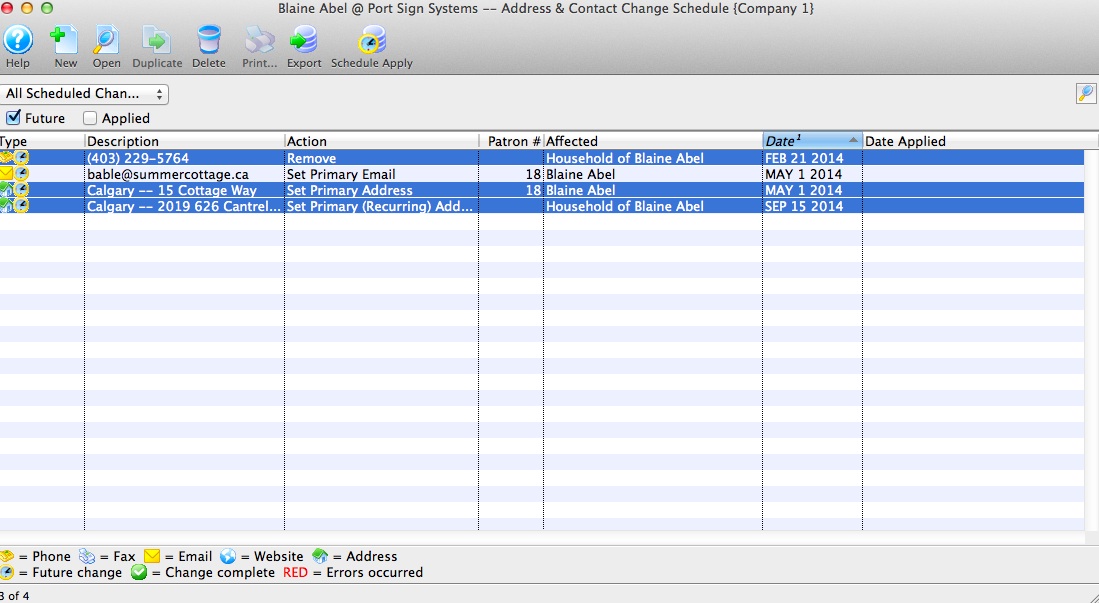
- Click Export button.
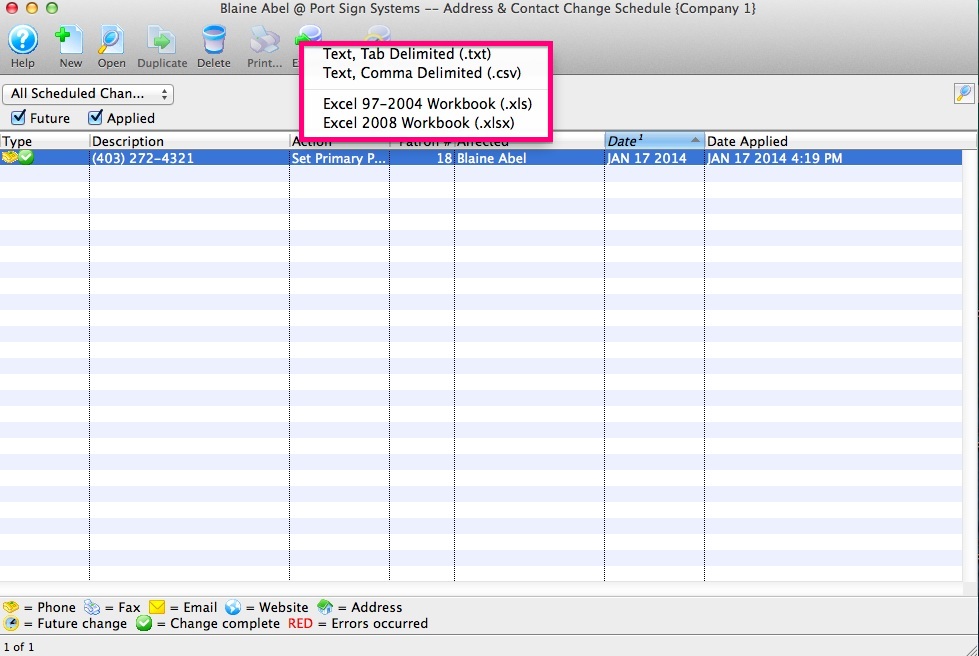
- Select a Tab Delimited or MS Excel workbook file and save.
Patron Contact Card - Details
Patron Details
In this area, some Patron Detail data fields may be marked as Mandatory Data fields within the Company Preferences. These pieces of information must be entered in order to save changes to the contact card.
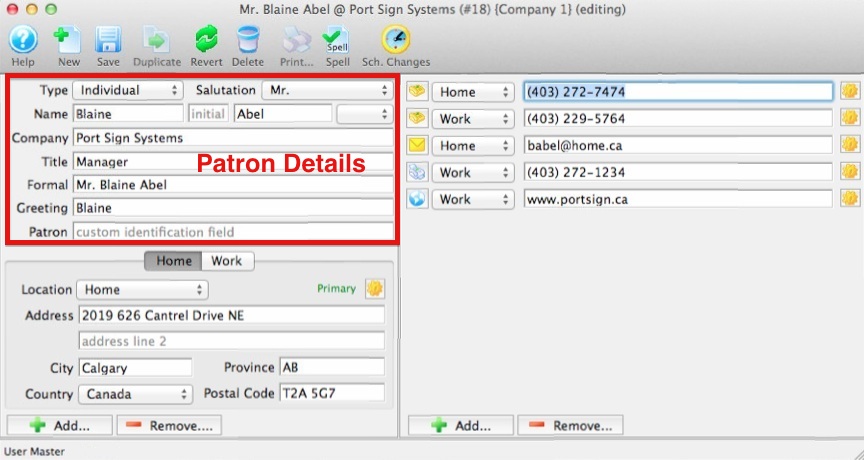
| Type | The Type of patron record that is being entered. For example: Individual, Company, or School. The Type of patron field is apart of the Code Tables and can be edited and customized. |
| Salutation | Formal Salutation for the patron. The Salutation field is apart of the Code Tables and can be edited and customized. |
| Name First | First Name of the patron. This is a Mandatory Data field. |
| Name Init | Middle Initial of the patron. |
| Name Last | Last Name of the patron. This is a Mandatory Data field. |
| Suffix | Suffix for the patron if applicable. The Suffix field is apart of the Code Tables and can be edited and customized. |
| Company | Company the patron is associated with. This is a Mandatory Data field. |
| Title | Title within the company the patron is associated with. |
| Formal | The Formal Name of the patron (including salutation) usually used for donation requests. This field provides the patron donor name for program listing unless the name is altered in the Publication Name found under the Donor Tab.
The Formal Name is auto populated by the First and Last Name fields. The auto populate can be manually over written by highlighting the text in this field and typing over it. |
| Greeting | A Greeting (or familiar name - such as first name or nickname) for the patron. The Greeting preference is set in System Preferences under the Edits Tab.
The Greeting is auto populated by the First Name field. The auto populate can be manually over written by highlighting the text in this field and typing over it. |
| Patron | A custom 30 character identification field. Designated for an external number for a patron that can also be used to find patron. Possible usage are for student/faculty numbers or a number in any other external system that you may need to communicate with. |
Patron Contact Card - Address
Address
There can be many different address locations for one patron stored within the Address. Some address information may be marked as Mandatory Data within the Company Preferences. If a field is marked as Mandatory Data it must be entered in order to save changes to the contact card.

| Location | Location of the patron's address. The patron Location field is apart of the Code Tables and is used to categorizes addresses, phone numbers, emails and web site addresses. In the Location drop down there are three default options Home, Work and Other available. | ||
| Address | Address of the location. There are two Address lines available
for more complex addresses. When a second address line is used, check formatting when printing address labels and ticket face.
|
||
| City | The City or town for the address provided. To assist in quickly adding a patron, a default City can be displayed when adding new patrons. The default City is set through Mandatory Data in Company Preferences under default values on patron insert. The default City comes from the City field under the Company tab in Company Preferences. | ||
| Province/State | The Province or State where the city is located. The Province or State field is apart of the Code Tables. To assist in
quickly adding a patron, a default province or state can be displayed.
The default Province or State is set through Mandatory Data in Company Preferences under default values on patron insert.
The default Province or State comes from the Province or State field under the Company Tab in Company Preferences.
The screen is able to display either "Province" or "State". The tab name "Province" or "State" may be renamed in the Appearance tab under Company Perfrences. |
||
| Country | The Country where the province or state is located. The Country field is apart of the Code Tables. To assist in quickly adding a patron, a default Country can be displayed. The default Country comes from the Country field under the Company tab in Company Preferences. | ||
| Postal Code/Zip Code | The Postal Code or Zip Code field records the patron's postal identification number. Postal Codes format automatically to capital letters. Zip Codes format automatically to add hyphens when 9 numbers are entered. Edit checks warn if numbers or letters are entered incorrectly. The screen is able to display either 'Postal Code' or 'Zip Code'. The tab name "Postal Code" or "Zip Code" may be renamed in the Appearance tab under the Company Preferences. | ||
 |
Adds another address to the Patron. | ||
 |
Removes a location from the address area. Click here for more information on removing. | ||
 |
Provides several options related a patron's address. For example, you can schedule future address changes. |
Link Another Address
- Open the Patron Window.
Click here for information on opening the Patron Window.
- Click the Address
 in the patron window.
in the patron window.
Click the Contact Card
 button.
button.The contact card window opens.
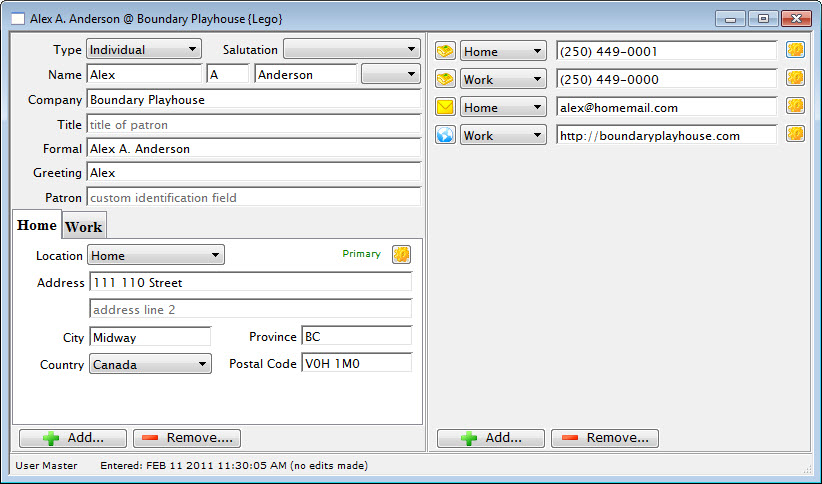
Click the Add button in the lower left corner.
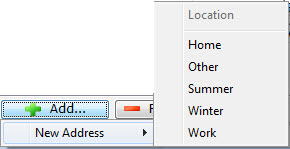
An address location drop opens. Select the new address location.
Enter the new address information.
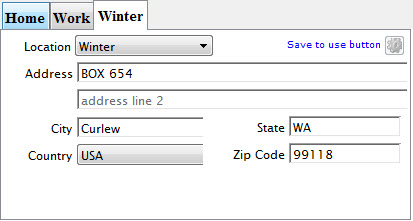
Close the contact card to save the information ot the patron record.
The new address is now added to the contact card.
Remove Linked Address
- Open the Patron Window.
Click here for information on opening the Patron Window.
- Click the Address
 in the patron window.
in the patron window.
- Click the Contact Card
 button.
button.
The contact card opens.

- Click the Remove
 button in the lower left corner.
button in the lower left corner.
Select the address to remove.

A warning dialog opens.
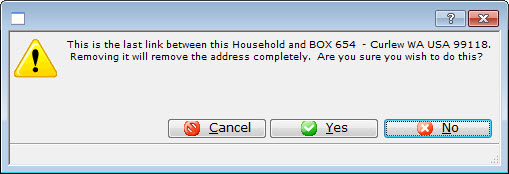
- Click the Yes
 button.
button.
A confirmation dialog opens.
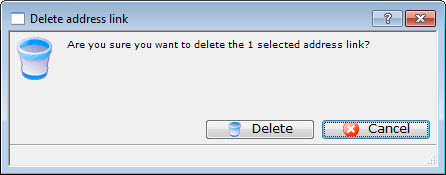
Click the Delete
 button.
button.The contact information is now removed from the contact card.
Patron Contact Card - Contacts
Contact Info
There can be as many lines of contact information within the contact area as are needed. Location types can be customized to meet needs.
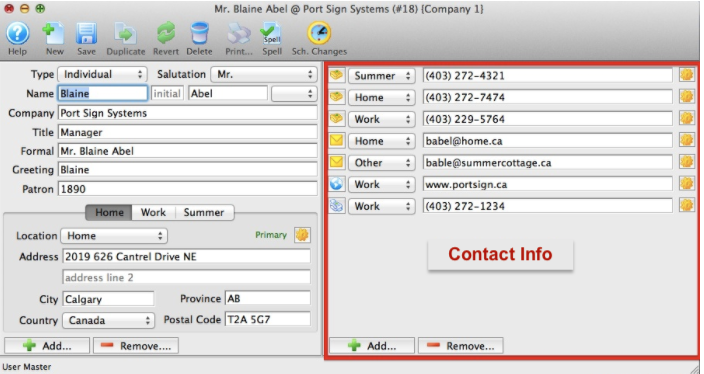
 | Type of contact information for the patron. |
 |
Location of the contact. For information on how to edit this drop down field click here. |
| Contact | Contact information for the patron. |
 |
Adds a piece of contact information to the patrons record. Each selection opens another flyout to select. When you make your selection, the patron's Contact Card opens to the field selected. |
 |
Removes the highlighted piece of contact information from the patron record. |
Add Contact Information
A patron may have as many contact types such as phone numbers, email addresses, fax numbers or websites as are needed.
- To Add a new contact type to patron's record, click on the ADD button at the bottom of the the Contact window.
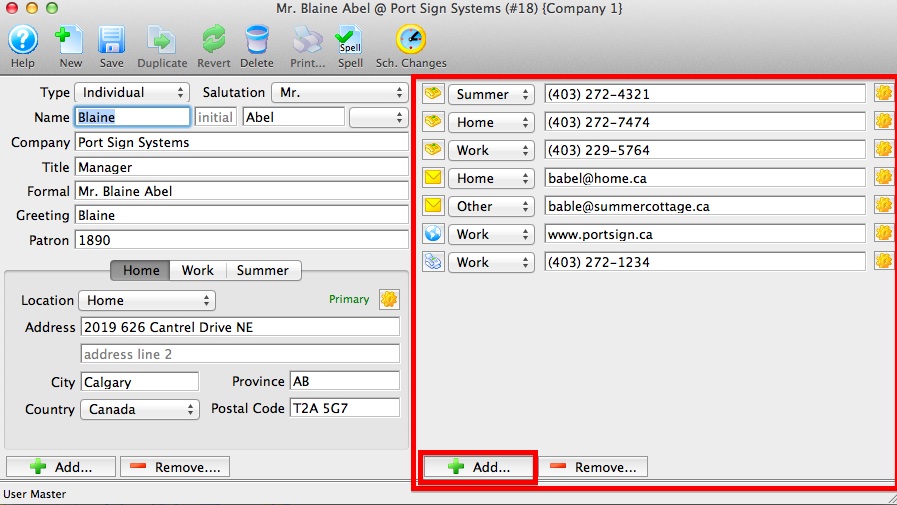
- Select the type of contact to add Phone, Email, Website or Fax. A sub menu will populate off of each of these contact types.
Mouse over or roll over the contact type and end by clicking the contact type and the location in the sub menu.
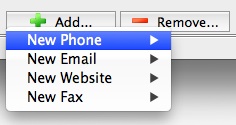
- Enter the patron contact information in the new line provided and SAVE.
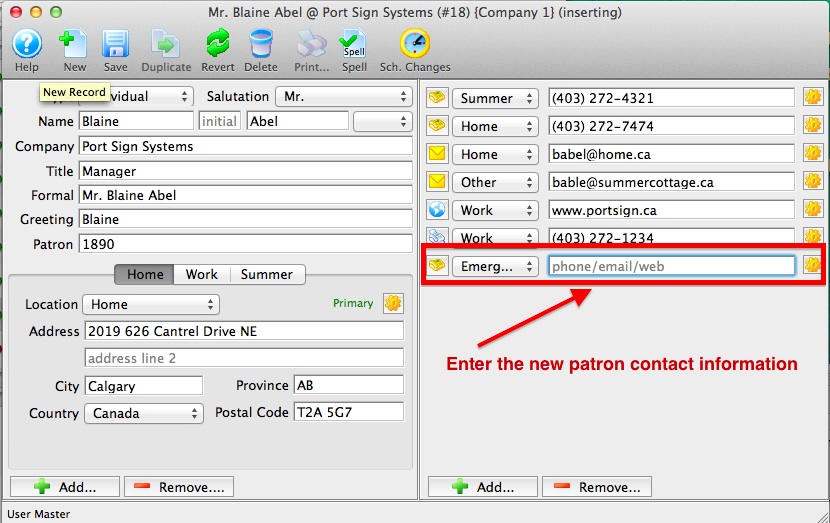
Remove Contact Information
When a patron's contact type(s) changes or becomes no longer valid, the phone number, email address, fax number or website can be remove as long as it NOT the primary contact.
- To Remove a contact type from the patron's record, click on the REMOVE button at the bottom of the Contact window.
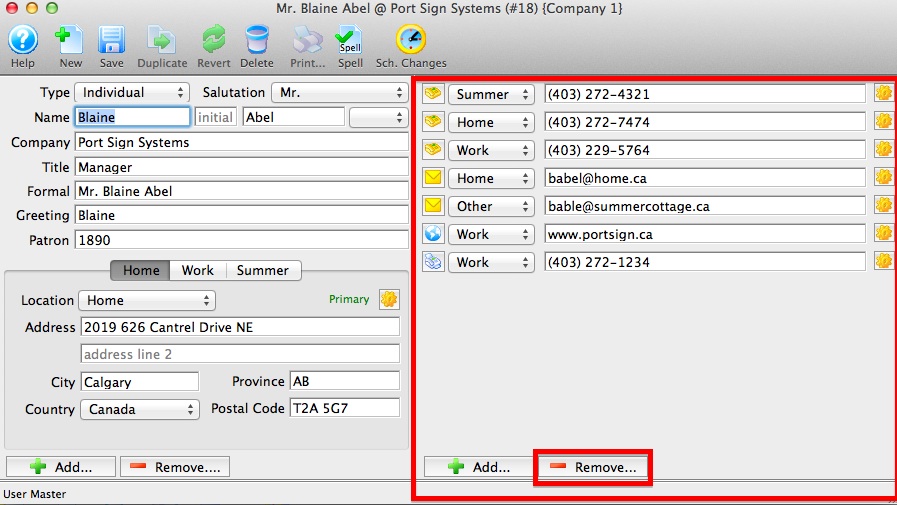
- Select the type of contact to remove Phone, Email, Website or Fax. A sub menu will populate off of each of these contact types.
Mouse over or rollover the contact type and end by clicking the contact type and the location in the sub menu.
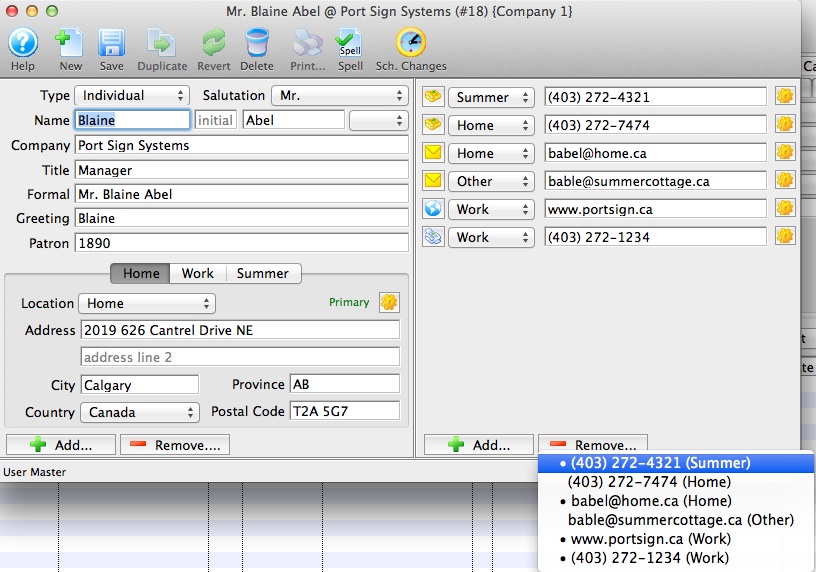
- Confirm the contact to remove.
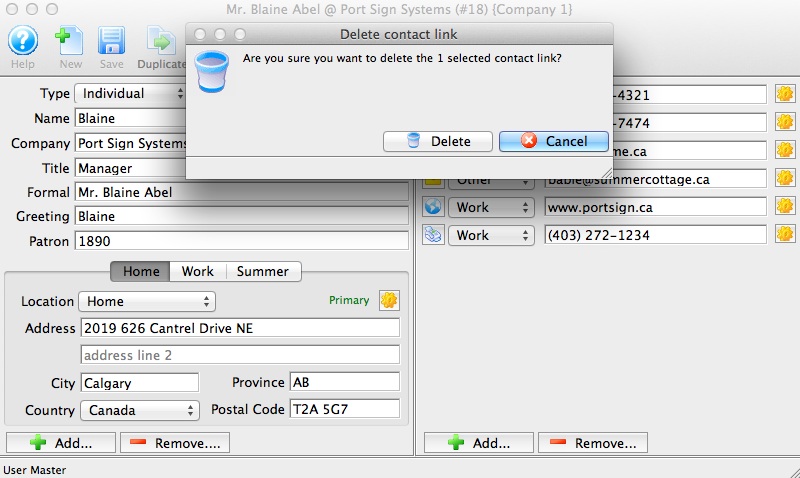
Alternate Way To Remove A Contact
- Click on the "Gear" next to the contact. A sub window appear. Mouse over or rollover the Remove Now and end by clicking.

- Confirm the contact to remove.

Using the "Gear" Buttons
 button on the Contact Card can be used for several functions depending on the contact field the gear button is next to. For example, with these buttons you can:
button on the Contact Card can be used for several functions depending on the contact field the gear button is next to. For example, with these buttons you can:
- Schedule the removal of a phone, fax, email, website or address.
- Schedule a change to the primary phone, fax, email, website or address as a one-time occurrence (and then change it back again at a later date).
- Show a map of the patron's address.
- Show the weather at the patron's address.
- Send an email to the patron.
- Reset the web sales password for the patron's account and send a one-time login email.
- If its an email address, then you can ask the system to display a Forgotten Password Reset Log which shows effort around the patron trying to login, forget their password, their success and checkouts
Sending a Patron an online password reset email
If a Patron calls and asks for their online password because they have either forgotten it, or don't know that they have one, you can send them a one-time password reset email so they can reset the password themselves.
 |
For security reasons, you cannot send the patron their actual current password.
You can only:
|
- Locate their Patron Record
- Open their Contact Card
- On the Contact Details panel, click the
 next to their email address
next to their email address - Choose the option for Reset web sales password and send one-time login email

The email will go out immediately. Have the Patron check their inbox for a new email. They can then follow the prompts in the email to change their password.
It is exactly the same email that the patron would receive if they had initiated the password reset themselves online
 |
If the email does not appear in the Patron's inbox within a few minutes, it may have gone to their "SPAM" or "Junk" folder. Have them check those folders. If it is there, they should also adjust their Mail Settings so that future emails from you are not also placed there. |
 |
An email will not be sent it there are two patrons in separate households with the same email address. If this is the case, you will need to de-dup the email addresses before it can be sent. |
Address Tab
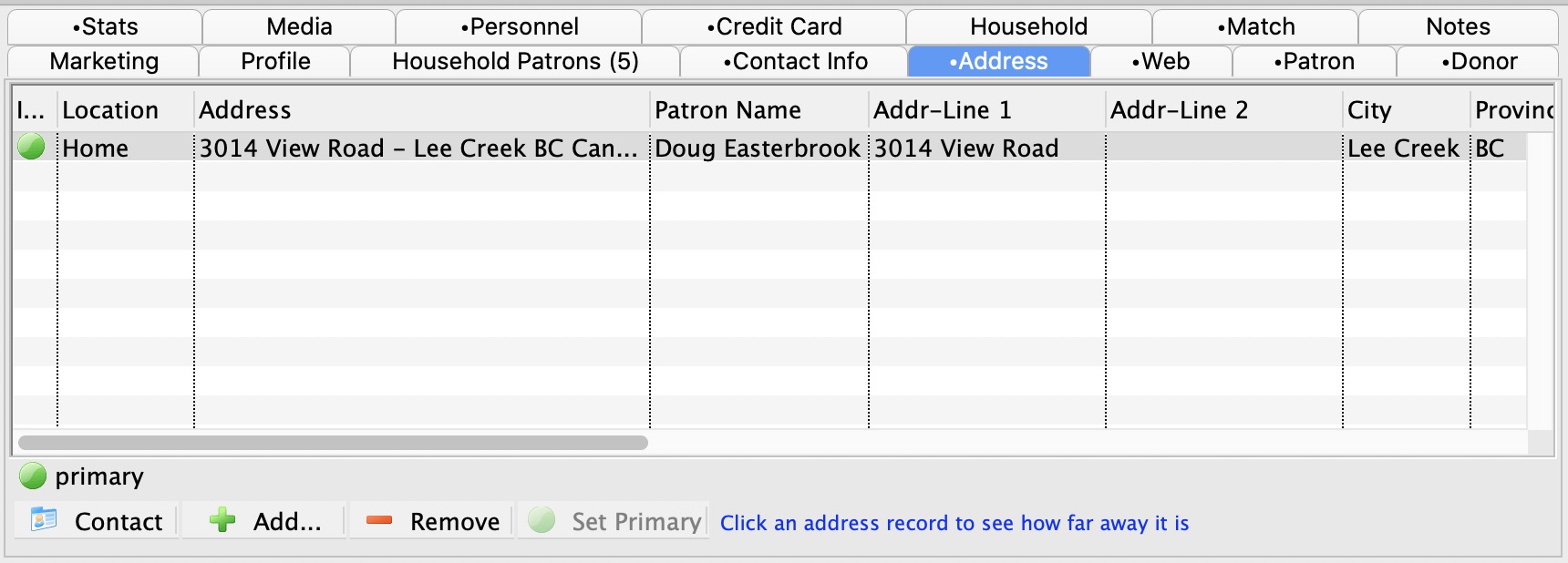
This tab is used to store address information for a patron.
Parts of the Address Tab
| Location | The location for the patron information. This is a customizable field. Click here to edit the options. |
| Addr-Line 1 | Patrons street address or P.O. Box. |
| Addr-Line 2 | Additional line for patron address details if needed. |
| Addr-City | City of the address. |
| Province | Province or state of the address. |
| Postal Code | Postal code or zip code of the address. |
| Country | Country of the address. |
 |
Opens the patron contact card. Click here to learn more about the contact card. |
 |
Clicking Add, opens a flyout to select the address type you want to add (Home, Others, Summer, Winter, Work). Making a selection, opens the Contact Card with the correct tab for that address added for data entry. Click here to learn more about the contact card. |
 |
Removes an address from the patrons record. |
 |
Changes the primary address for the patron. The primary address is recognized by the  symbol. symbol. |
 |
Highlighting a patron's address in the window changes the display to show the number of miles/kilometers from the patron's home to the address set in Company Preferences. The calculated distance will replace the existing text and now display like this:  |
Address Functions

When a Patron's address is highlighted from the Address Tab several additional functions are available setting column Preferences, Add, Open or delete a patron address, Export, Get Google Map and Geocode Address.
Additional Address Features
| Preferences | These Preferences pertain to the Patron window Toolbar allowing the Toolbar to be customized. Customizations include Hide and Show Toolbar or Text Under icons. Icon size can also be customized Small Icons. | changing-column-preferences
| New | Adds a new address to patron's record. |
| Open | Opens a selected address from patron's record. |
| Delete | Removes an address from patron's record, unless it is the primary address for the patron. If the primary address needs to be removed, set another address on the account to the primary address. |
| Duplicate | For future development. |
| For future development. | |
| Import | For future development. |
| Export | Allows for the patron address record to be exported to text or MSExcel document. Exported data includes: Patron number, address lines 1 and 2, city, Province/State, country, first and last names household number and title. |
| Hide Selected Lines | For future development. |
| Get | Allows the patron's address to copy patron name and address to the clipboard, Show map of address using MapQuest through a Web browser, and show weather at patron address using WeatherUnderground through a Web browser. |
| Google Map | Allows the patron's address to link directly to Google Map through a Web browser. |
| Geocode Addresses | Allows for the patron's address(es) be converted a into a geographic location using latitude and longitude. |
Delete or Remove A Patron Address
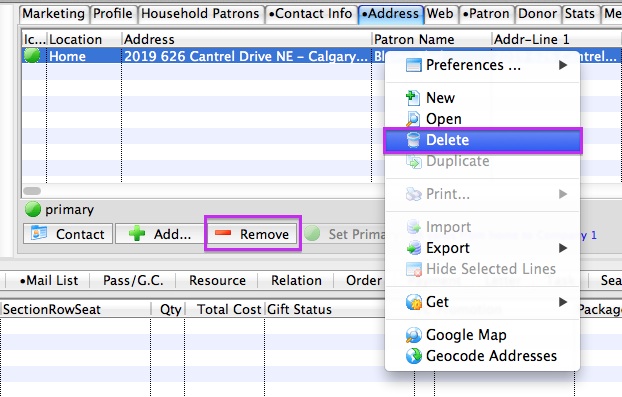
A Patron's address can only be removed or deleted when the address is not the primary address on the patron's account.
There are two methods to Remove or Delete a patron address.
Select the patron address. Use the Remove button at the bottom of the Address Tab window. OR Right click on the address will bring up a flyout menu. Click on Delete.
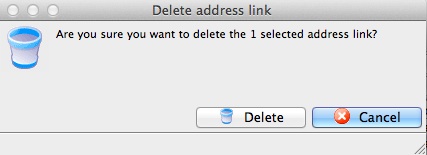
|
If the address is the primary address, it can not be deleted. |
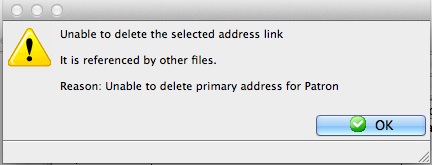
Export Patron Address
Patron's name and address can be exported to a spreadsheet through the Address Tab. Exporting multiple patron's name and addresses at once and can be done by highlighting multiple different patron records from the Patron Contact List Window.


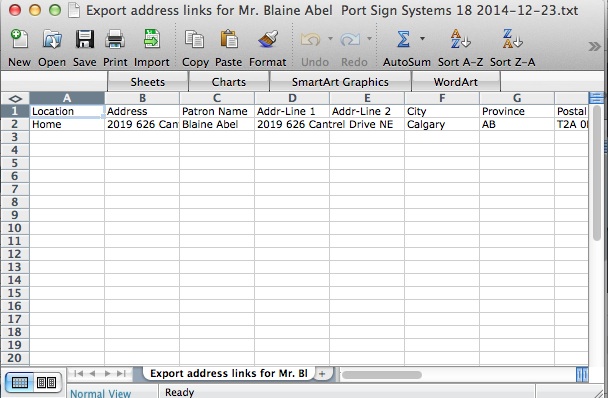
|
If the patron has more than one address, all or selected addresses can be exported to the same file. |
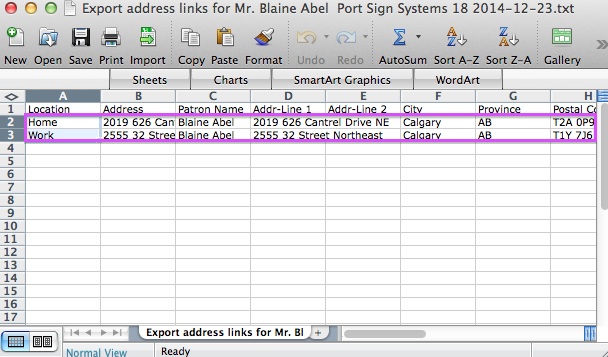
Geocode Addresses
- to get generalized information from the zip code/postal code table (zip codes are accurate only to a fairly large area and Postal Code may ba accurate to street (for cities) or area (for rural postal codes)
- or use Google Maps to obtain data - which is generally more accurate to the buildings actual location.

The database will display a message like the one below in the bottom left corner of the Patron Address Tab indicating that geocoding of addresses can not be performed because Google look up for Addresses has not been set in System Preferences. No database error message indicates Google has been enabled in System Preferences.

|
Google may limit the number of addresses being geocoded in a given day. |
Geocoding an address makes use of data from a street geographic information system where the street network is already mapped within the geographic coordinate space. Each street segment is attributed with address ranges (e.g. house numbers from one segment to the next). Geocoding takes an address, matches it to a street and specific segment (such as a block, in towns that use the "block" convention). Geocoding then interpolates the position of the address, within the range along the segment. More can be found on the Web by searching geocoding addresses.
Distance Patron Address is from Venue

Theatre Manager uses the geocode of the patron's address to determine the patron's distances from your venue. The distance from your venue is determined by the address listed in Default Company Information in Company Preferences.
Mail List with Address Latitude and Longitude
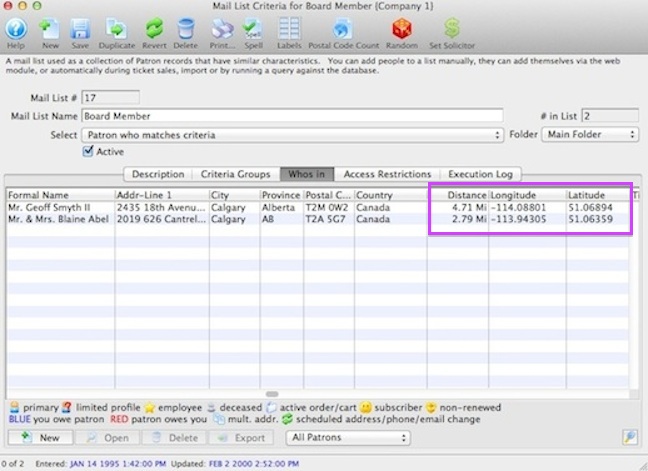
Get Function
There are three Get functions related to a patron's address from the Address Tab. The Get function can also be used through the Patron Contact List Window. These are helpful actions within Theatre Manager related to patron data that is commonly used.
- Copy patron name and address to the clipboard.
- Show map of patron address using MapQuest.
- Show weather at patron address using Weather Underground.
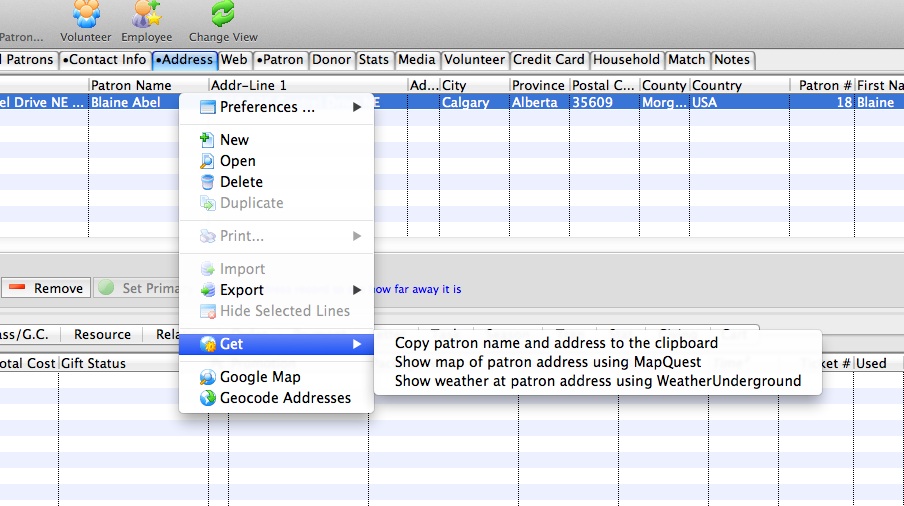
Copy Patron Name and Address to the Clipboard
Theatre Manager allows the patron name and address to be copied the clipboard. Then the name and address can then be pasted into any document by using the Edit >> Paste menu.
 For more information on how to Copy Patron Name and Address to the Clipboard Click here.
For more information on how to Copy Patron Name and Address to the Clipboard Click here.
Show Map of Address using MapQuest through a Web Browser
Theatre Manager takes the patron address and opens MapQuest through a web browser. This will display an interactive map showing the patron's address. From here MapQuest, provides directions to or from the patron address.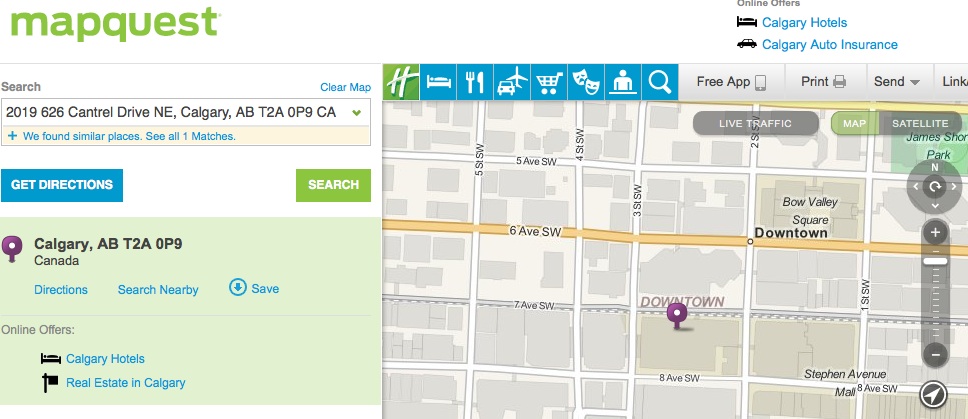
Show Weather at Patron Address using WeatherUnderground through a Web browser
Theatre Manager takes the patron address and opens WeatherUnderground in a web browser. WeatherUnderground web site provides real-time information surrounding the patron's address.
Copy Patron Name and Address to the Clipboard
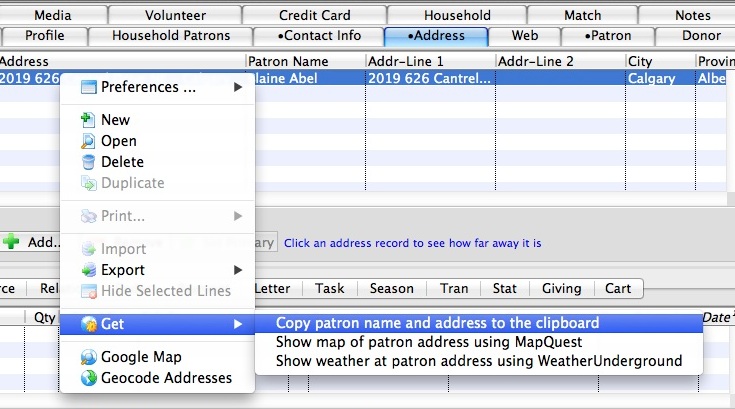

|
If the patron has more than one address, all or selected addresses can be copied to the clipboard to the same time. |
Show Map of Address using MapQuest through a Web Browser
The Get function of the Address Tab allows a patron's address be used in MapQuest to pin point where the patron lives. Show Map of Address using MapQuest through a Web Browser will display an interactive map showing the patron's address. MapQuest provides directions to or from the patron address.
 |
This feature can also be reached by using the "gear" icon next to the contact on the Contact Card |
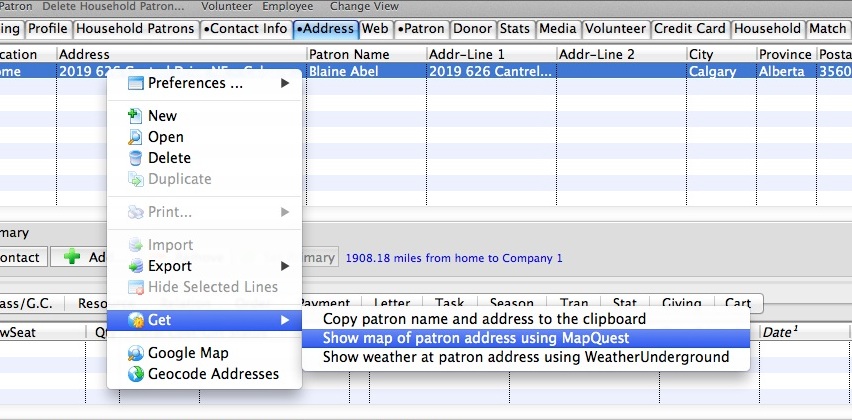

Show Weather at Patron Address using WeatherUnderground through a Web browser
The Get function of the Address Tab allows a patron's address be used to pin point the current weather where the patron lives. Show Weather at Patron Address using WeatherUnderground through a Web browser will display an interactive map showing real-time weather information surrounding the patron's address.
 |
This feature can also be reached by using the "gear" icon next to the contact on the Contact Card |
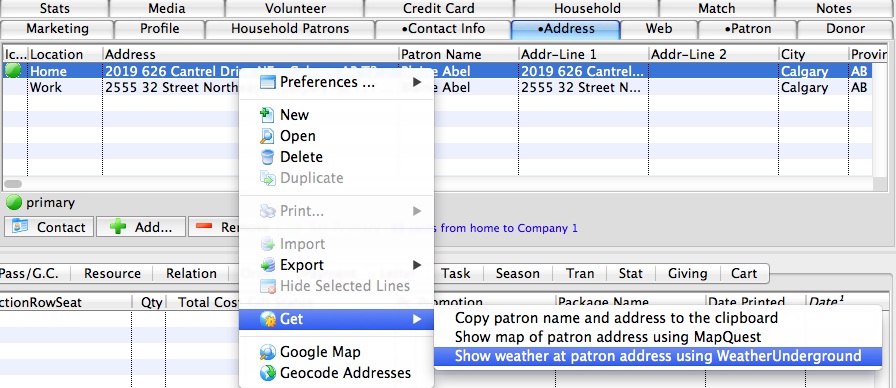

Google Map
The Google Map function allows Theatre Manager to use the patron's single or multiple address(es) to plot the patron's address on a Google Map. The web browser displays a static map of the patron's address(es). Google Maps is also available through Patron Contact List, the WHO's IN Tab of a Mail List of Patrons, or anywhere a listing of patrons are generated.

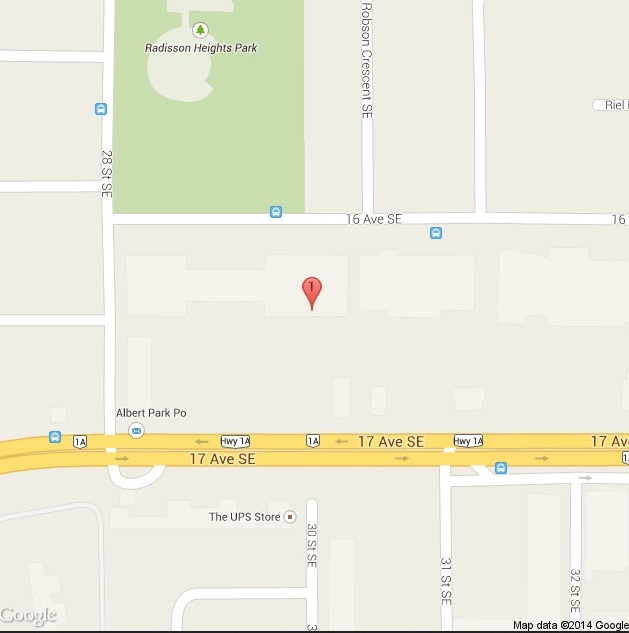
|
If there is more than one address for the patron, several addresses can be selected and displayed on the same static map. This is helpful if you wish to see a graphic representation of where your patron, subscribers or donors live.
|
|
Needing an interactive map to get directions to a patron's address use the Show Map Address Using MapQuest Through Web Browser |
Web Tab
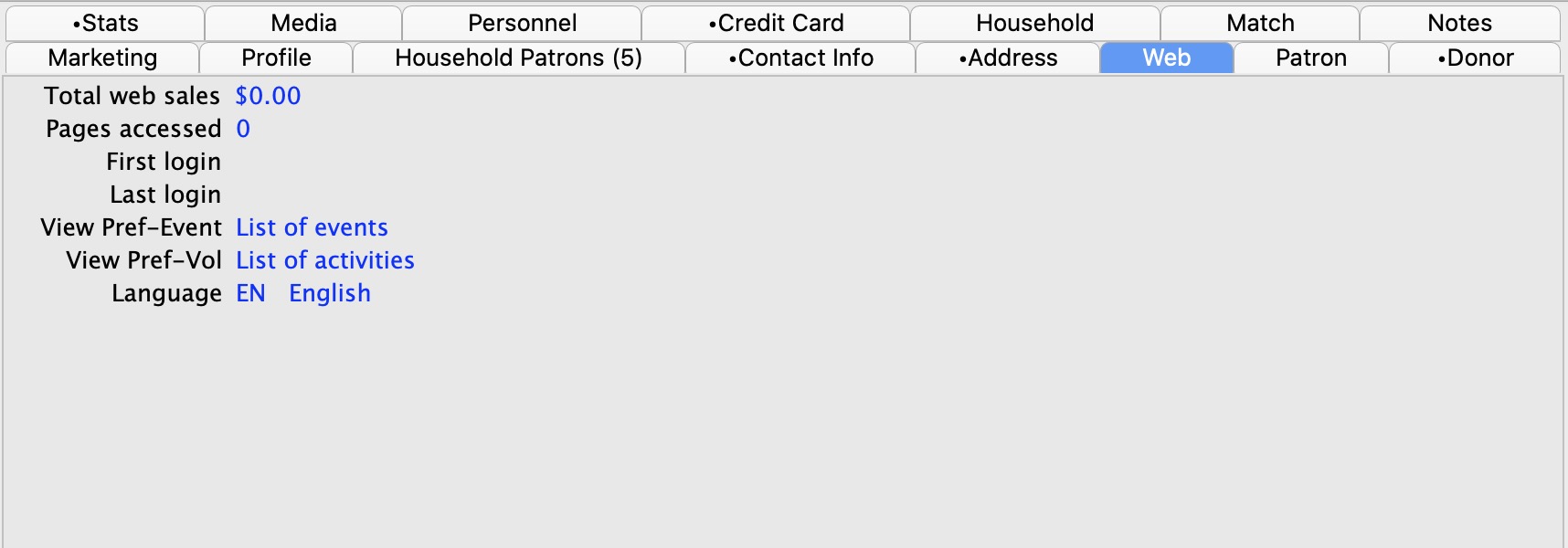
The web tab is used to keep track of a patron's history of purchases over the internet.
Parts of the Web Tab
| Total Web Sales | Total value of sales over the web. |
| Pages Accessed | Number of pages accessed by the patron. |
| First Login Date | The first time the patron logged into the website. |
| Last Login Date | The last time the patron logged into the website. |
Patron Tab
This tab gives a brief overview of the patrons financial history with the company.
Parts of the Patron Tab
| Patron Special Needs | A high priority note employees need to be aware of during sales. For example: Patron requires wheelchair seating. This note appears in the orders window during purchasing. | ||||
| Tax number | If this patron has a Tax Exempt number, you may enter it here. This field is only for reference, however. To automatically remove the taxes, be sure to add the Tax Exempt number to the Household tab. | ||||
| Default Sales Promotion | An option to select a default sales promotion when this patron purchases tickets (if the sales promotion is available).
|
||||
| Allowed Sales Promotions |
If the patron is a tour operator, reseller, or school where you want them to receive specific pricing at the box office, you can enter one or more sales promotions on their record. By doing so, only those sales promotions can be used to sell tickets for the patron- none of the others that the box office normally has access to will be seen.
For example, you might associate a group price and a bus driver comp with the patron - and thats the only price that they can be charged. If those promotions are not available on a performance, you cant sell a ticket to them.
|
||||
| Remind Employee of Notes | When checked and you open the patron window, it makes a audible beep and opens to the patron tab instead of the default marketing tab.
There is no pop up displayed to keep movement during a sale process faster - it allows you to read the notes and move on without having to acknowledge a confirmation message. |
||||
| General Patron Notes | Notes about the individual patron. | ||||
| Ticket Balance | Amount of money due from or to the patron. A red number means the patron owes the company, a blue number means the company owes the patron. | ||||
| Total Tickets | Total amount of money spent on tickets by the patron. | ||||
| Total Memberships | Total amount of money spent on membership items by the patron. | ||||
| Last Ticket | Last year the patron purchased tickets. |
Donor Tab
The donation tab provides a brief look at the donation defaults for a patron.
Parts of the Donor Tab
| Publication Name | This is how the patron generally wishes to be recognized.
Normally this is left blank for most patrons, but if patron has a specific request for all donations, enter something here. It was intended for foundations, granting agencies, and matching gift corporations that have specific recognition needs. However, it can be used for any patron. Refer to the actual entry of a donation to see how the program name is populated. |
| Giving Capacity | Expectation of the patrons giving range within a specific time frame. |
| Don't solicit by: | The options are:
|
| Solicitor | Assigns a specific employee as solicitor for this patron. |
| Donor Tab #2 | Donor Date field. |
| Moves Mgt Date | Use to track the date a patron reached a selected level within the moves management structure. The calendar  button can be used to select a date. button can be used to select a date. |
 |
Donor level. Allows you to choose a donation selections level. |
| Last Match Co. | The company and individual who last matched the donors gift. |
| General Donor Notes | Any general notes about the donor that are not related to a specific donation. |
| Private | Restricts the view of the patron's donation info from general users of Theatre Manager. For more information on restricting access to donor information click here . |
| Asset Tracking | If you wish to track key assets for a donor, you can enter them into the list on the upper left. This allows you to identify high net worth individuals.
This is described in more detail in donor asset tracking |
Donor Asset Tracking
 If you are tracking planned giving, a list of assets owned by the patron can be displayed. This allows employees (with permission) to see and/or edit a list of assets (and optionally, the value) for a patron for major gift prospecting. There are separate permissions for this feature and the window will not be shown if an employee does not have permission to see the data.
If you are tracking planned giving, a list of assets owned by the patron can be displayed. This allows employees (with permission) to see and/or edit a list of assets (and optionally, the value) for a patron for major gift prospecting. There are separate permissions for this feature and the window will not be shown if an employee does not have permission to see the data.
Click the new, edit or delete buttons under the asset list to edit various aspects of the assets, including the value and when it was valued. A total of all assets is displayed to the right at the bottom of the statistical information column.
 |
Refer to the Donor Assets Code Table to create or edit code table values used in this window. |
 |
A user must have access to the asset tracking data in their employee permissions, otherwise this list is not displayed in the window. You can choose to have only key development staff members see this information.
|
Stats Tab
This tab displays some summary statistics on the donations the patron has made. The data is separated into:
- Fiscal year - past 6 and future
- Program year - past 6 and future
- Balance, and totals for soft credits and pledge amounts
- An indication of minimum, maximum gifts and when they were given
Meaning of Fiscal and Program Year
The Fiscal Year for a donation is displayed using the current fiscal year from company preferences, accounting tab. All accounting is done based on fiscal year.
The Program Year for a donation generally tracks the fiscal year - meaning it is the same. However, you can make the program year an arbitrary year in the future or in the past -- so that you can track totals differently than fiscal year. Changing program year has no effect on financial data. It can be used as selection criteria for creating the program listing.
Calendar Year is derived from the date of the donation for tax receipt purposes.
 |
The totals are displayed on mail lists and a few other places within the system. They are handy for quickly finding people based on total donations.
However, if you want to distinguish based on campaigns or other donation fields, you may need to use mail lists to identify and contact people. |
Media Tab
The Media Tab is used to keep track of patron's who are member's of the media and the marketing materials they could best but to use.
Parts of the Media Tab
Media Information |
|
| Media Type | Record the type of media that the patron works with. To select a media type, open the drop down list and click on the desired choice. The list of media type can be altered in the Media Types Code Table. Click here for more information. |
| Community | The area in which the media type spans. Television for example would span the entire city, so the user might put a city name in the community field, or the media could be a community paper and it only spans one or two communities, so the user would put the community name(s) in the field. The Community defaults to the City entered in the patron window. |
| Last Contact | Last time the media member was contacted. |
| Lead Time | Number of days (in advance) the media members need to be aware of an event in order to advertise it. |
| Priority | Rating media contacts for accurate distribution of limited advertising materials. |
| Notes | Relevant notes about the media contact. |
Send Following |
This is what the media member requires in order to properly advertise the event. Add a check mark by clicking in the box next to the required items. |
| Media Release | Does the Media Member require a Press Release? |
| Invitation | Does the Media Member receive an Invitation? |
| Poster | Does the Media Member receive a Poster to display? |
| PSA | Does the Media Member require a Public Service Announcement? |
| Photo Call | Does the Media Member receive Photo opportunities? |
| Media Kit | Does the Media Member receive a Media Kit? |
| Brochure | Does the Media Member receive a Brochure? |
| Calendar of Events | Does the Media Member receive a Calendar of the Theatre's Events? |
| Comp. Tickets | Does the Media Member receive Complimentary Tickets? By
placing a check mark in the Comp Tickets box another field will appear
alongside Comp. Tickets which allows room to define the number of tickets the
media member is to receive. Enter the standard number of complimentary
tickets for this contact. This is a security feature. When the media
member calls to request their complimentary tickets, check
this field to see how many tickets they are to receive.
|
Volunteer Tab
The Volunteer Tab is used to show which patrons are volunteering for an play. Click Here for more information on setting volunteers.
Parts of the Volunteer Tab
| Status | Select the appropriate one of the following:
|
| Passport # | The Passport number of the individual |
| Equity # | The equity number of the individual |
| Height | The height of the individual |
| Weight | The weight of the individual |
| General Volunteer Notes | General notes about the volunteer |
| Last Activity | Displays the year the individual last volunteered |
| Total History | The number of times the individual has volunteered |
| Awarded Hours | Number of hours the volunteer has worked that have been awareded |
| Total Hours | The total number of hours the individual has worked as a volunteer |
Credit Card Tab
This tab stores the patrons credit card history for records and auditing purposes. Data in this tab is visible to an employee if they have been granted access under Employee Setup.
 |
If you want to black list the card and prevent it from being used in Theatre Manager, edit the card and click the black list checkbox |
Parts of the Credit Card Tab
| Type | Credit card type. e.g. Visa, Master Card, American Express. |
| Name on Card | Name printed on the credit card used for added security when processing the card. |
| Credit Card | The credit card number |
| Expiry Date | Date the card will expire. |
| Uses | Once a card has been used, a count of the number of times it is used is retained. This is the number of payments records with this credit card number on it. |
 |
Adds a new credit card to the patrons file. Click here for more information on Adding New Credit Cards. |
 |
Opens the credit card detail window for editing. Click here for more information on Editting a Credit Cards. |
 |
Deletes a credit card from the patron file. Once credit cards without transaction history can be deleted from the patron record. Click here for more information on Deleting a Credit Card. |
 |
Shred the selected credit card records if they exceed the minimum retention policy of # days. Theatre Manager can implement either Schedule "C" or "D" for the SAC. You can define a retention period for credit card information. Click here for more information. |  |
Determines the state of the card and if it can be selected to process credit card transactions. Expired, lost or stolen cards can be set to an inactive state. |
Add New Credit Card
- Open the Credit Card
 tab.
tab.
- Click the New
 button.
button.
The Credit Card detail window opens.
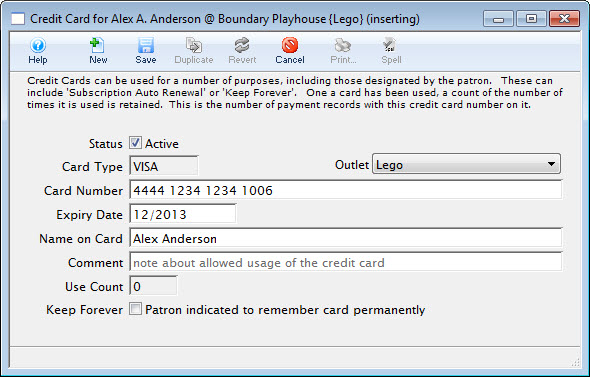
- Enter the credit card number.
Theatre Manager will determine the card type and populate the type into the Card Type field.
- Enter the Expiry Date for the credit card.
- Type the name from the card exactly how it appears.
This is an optional process all though it allows for stronger security when processing the card.
- Enter any comments about the card as needed.
The Use Count will increase as the patron uses the card over and over.
- Click the Save
 button.
button.
- Close the Credit Card detail window.
The card information now appears in the Credit Card tab.
Changing a Credit Card Expiry or Purpose
- Expiry Date for an existing card. A change will affect all future authorizations for post dated payments.
- Name on the card if it was swiped incorrectly.
- Blacklist status - you can black list a card which can be used to prevent this card from being used again.
- If the same card number is in use by other patrons, you may be prompted to also blacklist those patrons.
- Only employees with permissions in functions tab can clear the blacklist status.
 |
If you need to change the card number used on future post dated credit cards, please refer to changing post dated credit card. You could change the expiry date using this process. |
- Open the Credit Card
 tab.
tab.
The Credit Card tab is located on the Patron Window.
- Select the Credit Card to be edited.
- Click the Open
 button.
button.
The Credit Card detail window opens.
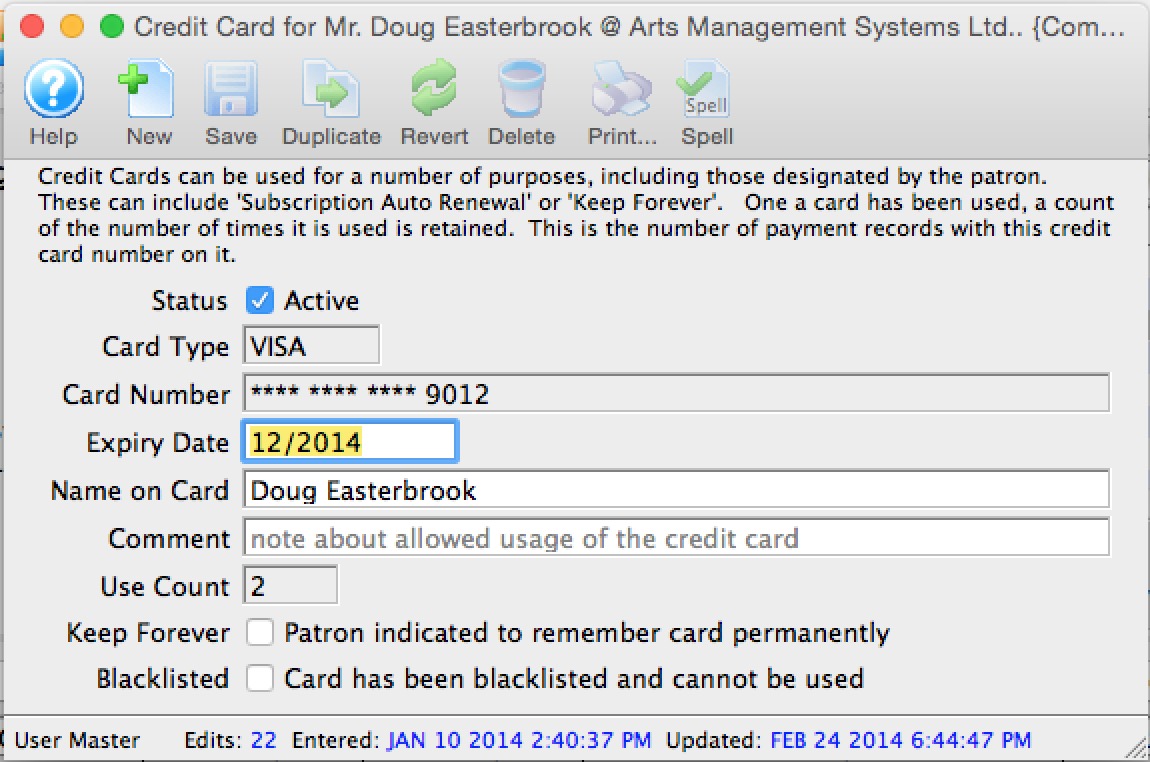
- Make changes as needed.
- Click the Save
 button.
button.
- Close the Credit Card detail window.
The card information is now updated in the Credit Card tab.
Delete a Credit Card
- Open the Credit Card
 tab.
tab.
The Credit Card tab is located on the Patron Window.
- Select a credit card.
Select a credit card by single clicking on it.
- Click the Delete
 button. One of two messages will open:
button. One of two messages will open:
The message below indicates the card has been used for previous transactions within Theatre Manger. For record and auditing purposes the card can not be removed from the patrons record.
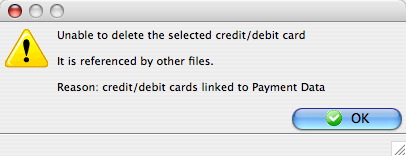
This message indicates the card has no previous transactions history within Theatre Manger.It can deleted from the system.
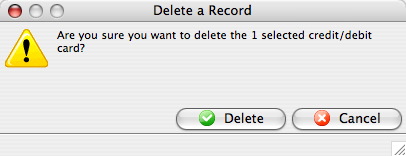
- Click the Delete
 button.
button.
The credit card is now removed from the patrons file.
Household Tab
This tab stores information related to all members of the household. Changes to this tab will effect all members of the household.
Parts of the Household Tab
| Tax Exempt Certificate | When entered Theatre Manager will not charge taxes to the patron. |
| Household General Notes | Notes about the household. Notes entered in this field will be viable in the household tab of each household member. Notes changed in one record will effect all records. |
Match Tab
The Match tab allows you to indicate that a particular patron record is that of a Matching Gift Company.
Parts of the Match Tab
| Matching gift company | A checkmark indicates that this patron record is of a Matching Gift Company. |
| Match gift ratio | The ratio of the donor's gift that the company will match. |
| Minimum amount | The minimum threshold below which the company will not match (if applicable). This field is optional. |
| Maximum amount | The maximum threshold above which the company will not match (if applicable). This field is optional. |
Account History Tabs
Ticket Tab

The tickets tab shows a summary of all tickets bought by the patron. They may be shown by different types and years using the pull down bar in the bottom left corner.
- Refer to Examining Purchases if the user cannot view patron tickets.
- For a description of the buttons on this window and the procedure to sell a ticket are described in Selling Tickets.
Parts of the Ticket Tab
| Order # | The order number is a reference number for the order. |
| Play Code | A unique code used to define the event. |
| Performance Code | A code which describes which day the event took place on. |
| Section/Row/Seat | Section/Row/Seat provides the location of the Patron's seat. |
| Qty | The number of admissions the ticket allows. Theatre Manager allows "Group Tickets" for festival seating events. |
| Total Cost | Displays the amount paid for the ticket. The price includes markups, discounts, and taxes. |
| Pc | Pc pertains to the "Price Code" selected when the ticket was purchased. |
| Promotion | Displays the "Sales Promotion" used when the ticket was purchased. |
| Date Printed | Date the ticket was printed on. |
| Performance Date | The date the performance will take place. |
| Performance Time | Time the performance will take place. |
| Play Title | The name of the event the ticket was purchased to. |
| Used? | The status of the ticket can be marked as used if attendance is tracked within Theatre Manager. |
 |
Clicking the Tickets button opens a popup that allows you to:
|
 |
Detail opens the ticket transaction. Click here for more information. |
 |
Returns tickets back to a sales state and allows a refund or transfer of patrons funds to another form. For more information click here. |
 |
Prints or emails the selected tickets if they are not yet printed. |
 |
Unprints tickets that already have a printed date. For more information click here. |
 |
Same as the Attandance by House and Calendar Report - Print Graphic Map by Ticket report. Maps the patron's highlighted tickets to their seats in the venue. For more information on printing a graphic map by ticket, click here. |
 |
|
Patron Ticket Purchases
The tickets a patron has purchased are displayed using the Tickets Tab in the Patron Account. Refer to the appropriate links for more in depth descriptions.
To display tickets, you perform the following steps:
- Select the Tickets Tab in the Patron record.
Theatre Manager displays a summary of all the non-archived tickets which fall under the parameters set using the two pull down menus on the bottom left of the tab.

- Double click on a line of ticket information
The ticket detail window opens and displays detailed ticket information. There are four tabs within the Ticket Detail Window. Depending on the type of ticket these tabs may or may not be available to view.

To view the Detailed Ticket Information
Ticket Detail Tab
Play Information |
|
| Play | The name of the play the ticket is for. |
| Venue | The name of the venue that the play is located in. |
| Code | The ticket code which includes the play code, performance code, performance date and performance time. |
| Seat | The seat that the ticket is for. |
Order Information |
|
| Promotion | Promotion that this order was sold under. |
| Sold By | The name of the clerk that handled the order. |
| Quantity | The quantity that the ticket admits. |
| Price | The gross price of the ticket. |
| Discount | The amount of the discount received for the ticket. |
| Ticket Fee 1 | The amount of the ticket fee that was included. |
| Ticket Fee 2 | The amount of the ticket fee that was included. |
| Ticket Fee 3 | The amount of the ticket fee that was included. |
| City Tax | The amount of tax that was charged. |
| State/PST Tax | The amount of tax that was charged. |
| Federal/GST Tax | The amount of tax that was charged. |
| Ticket Cost | The net ticket cost after all discounts, fees and taxes. |
| Auction Item | If this was an auction item, then the description of the item appears here. |
Patron Information |
|
| Name | The name of the patron that purchased the ticket. |
| Attended Status | The status of the ticket as whether it was used for attendance yet. |
| Order # | The order number that this ticket was sold under. |
| Ticket # | The number of the ticket. |
| Tax Code | The tax code that was used. |
| Bought | The date that the ticket was purchased. |
| Journalized | The date that the ticket was entered in the general journal. |
| Printed | The date that the ticket was printed. |
| Print By | The last user that printed the ticket and the number of times that it was printed. |
Transactions Tab
| Seq # | The sequence number of the transaction. |
| Transaction Date | The date the transaction occurred. |
| Journal No | The journal number for the transaction. |
| Code | The code for the transaction type. |
| Transaction Desc | A description of the transaction. |
| Order # | The order number that the transaction was a part of. |
| Play Code | The play code that the transaction was a part of. |
| Performance Code | The performance code that the transaction was a part of. |
| Type | The type of ticket that was used. |
| Description of Entry | A description of what the transaction did. |
| Debit | The amount debited in conjunction with the transaction. |
| Credit | The amount credited in conjunction with the transaction. |
| User | The user who entered the transaction. |
| Qty | The quantity of items in conjunction with the transaction. |
| Total | The total amount for the transaction. |
| First Name | The first name of the patron that the transaction is attached to. |
| Last Name | The last name of the patron that the transaction is attached to. |
| Patron # | The patron number who the transaction is attached to. |
| Campaign | The campaign used if this was a donation. |
| Member Type | The membership type that used. |
| Promotion | The promotion that was used on the transaction. |
| Group | |
| Merchant | |
| Play Title | The title of the play that the transaction affected. |
| Play Code | The play code that the transaction was attached to. |
| Outlet Owner | The owner of the outlet that made transaction. |
| Outlet Other | The outlet that the transaction took place at. |
| GL # | The G/L number that the transaction affected. |
| Fee | The fees that were charged in conjunction with the transaction. |
Order Notes Tab
Ticket Handling |
|
| Hold for Pickup / Taken | Denotes that patron will pick up ticket from the Box Office prior to performance. |
| Mail to Patron | Denotes that ticket should be mailed to patron. |
| Hold for Will Call | Denotes that the ticket will be picked up at Will Call prior to the performance. |
| Hold @ Door for Coupon | Denotes that ticket should be held. Patron needs to present a coupon in order to receive ticket. |
Order Notes |
Listing of any order notes entered by any user. |
Donation Tab

A Donation would be any item given to an organization without intention of receiving a benefit. Most donors receive a tax receipt for their donation. Donations can be Inserted, Modified, or Deleted depending on the need. To learn more about Donation Features click here.
Parts of the Donation Tab
| Status | |
| Order # | The order number is a reference number for the order. |
| Prog Yr | Program Year. |
| Use | Use |
| Campaign Name | Name of the campaign. |
| Fiscal Year | Fiscal Year of the donation. |
| Donation Date | Date the donation was made. |
| Pledge Amount | The amount the patron pledged. |
| Actual Amount | The amount recieved to this date. |
| Giving Level | What level of giving the donation is at. |
| Balance | Outstanding balance of the pledged amount remaining. |
| Total Receipted | The amount of the donation that has been issued receipts. |
| Soft Credit | Soft Credits that have been applied to the donation. |
| Program Name | The name of the program. |
 |
Add a new donation. For more information, click here. |
 |
Opens the highlighted donation. For more information, click here. |
 |
Deletes the highlighted donation. For more information, click here. |
 |
Opens the Payment window for the highlighted donation. For more information, click here. |
 |
Prints the highlighted donation. For more information, click here. |
 |
Opens the Set Donation Name dialog for the highlighted donation. For more information, click here. |
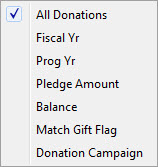 |
The Donations search filter. |
Event / Play Tab

The Event / Play tab is used to keep track of which events / plays a patron or household has purchased.

Parts of the Tab
| Play # | The unique number used to distinguish between events / plays. |
| Year | The year the event / play is associated with. |
| Play Code | A unique code used to distinguish between events / plays. |
| Play Title | The title of the event / play. |
| Count | Count of tickets purchased to that event. |
| Price | Total value of the tickets that the patron has purchased |
| Outlet-Owner | The outlet the created the event / play. |
 |
Not supported on this tab. |
 |
Not supported on this tab. |
 |
Not supported on this tab. |
Adding an Event / Play to a Patron Through the Event / Play Tab
Editing an Event / Play From the Patron's Event Play Tab
Deleting an Event / Play from a Patron's Event / Play Tab
Mail List Tab

This tab is used to view all of the mail lists that a patron belongs to. It is also used to manually add or remove patrons to or from a mail list. You can also access the mail list criteria window from this tab.

Parts of the Mail List Tab
| List # | This is the number that was assigned to the mail list when it was created. |
| Source | How the patron was added to the mail list. |
| Mail List Name | This column displays the names of the mail lists that the patron belongs to. |
| Mail List Description | This is a brief description of the nature of the mail list. |
| Date Added | This is the date that the patron was added to the corresponding mail list. |
| Date Updated | The date the mail list was last ran or updated. |
| Outlet-Owner | The outlet the mail list belongs to. |
| Mail List Active? | Displays the current active or inactive state of the mail list. |
| Web? | Shows the mail lists status on the web site. |
| Changed By | The last person to edit or update the mail list. |
 |
Clicking this button allows the user to attach a patron to any mail list manually. For more information, Click here. |
 |
Clicking this button opens the mail list criteria window. For more information on mail list criteria and how it can be edited click here. |
 |
This button removes a patron from the selected mail list. For more information Click here. |
Pass G.C. Tab

The Member Tab tracks data for memberships, gift certificates and/or event passes for a patron. For more information on memberships click here.
|
"Membership" is a broad term meaning "Gift Certificates," "Flex Passes," "Vouchers," "Other Income" or a variety of other forms. Since the name of the field is customizable, some organizations may retain the term "Membership," while others change it to reflect their own terminology such as "GC/Pass," "Gift Certs." or even "Other Income." The nomenclature in your database may be different than "memberships." |

Parts of the Pass / G.C. Tab
| Order | The unique number for this order. |
| Fiscal Year | Fiscal year the membership belongs to. |
| Member Type | The type of membership purchased. Membership types are setup in Code Tables. Click here for more information. |
| Date First Member | Date the membership has been valid since. |
| Control # | The control number for this membership used for redemption purposes. |
| Purchase $ | The value of the membership at the time of purchase. |
| Issued Qty | Number of admissions the membership was valid for at the time of purchase. |
| Remain $ | Remaining dollar value the membership can be redeemed for. |
| Remain Qty | Remaining admissions for the membership. |
| Date Renewed | Date the membership can be renewed on or till. |
| Last Renewed | Date the membership was last renewed. |
| Expire Date | Date that the membership will expire. |
| Notes | This column displays any notes that are pertinent to the membership. |
 |
Clicking this button allows you to buy a new membership. For more information on buying memberships click here. |
 |
Clicking this button allows viewing the membership detail window. For more information on membership details click here. |
 |
Clicking this button allows refunding a membership. For more information on refunding memberships click here. |
 |
Adds a payment to the membership. |
 |
When the membership preferences define, prints the selected membership. For more information on Print Memberships, Click here. For more information on setting up membership types click here. |
 |
When the membership preferences define the ability to unprint, unprints the selected membership. For more information on setting up membership types click here. |
 |
Use the Valid/Invalid filter to search for current or expired Memberships. |
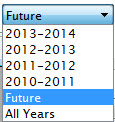 |
Use the Date Filter to search for Memberships in specific years. Use this in conjunction with the Valid/Invalid filter. |
Relation Tab

 The relationships tab shows the relationships that this patron has with other patrons in the database. This could be used like various types of patron interactions like:
The relationships tab shows the relationships that this patron has with other patrons in the database. This could be used like various types of patron interactions like:
- Coworkers, bosses or employee relationships - which might be beneficial for group sales
- family relationships like parents, children, grandparents or gardians - for drama classes or educational purposes
- relationships created for safety reasons like doctors, who can pick up a child from drama camps (and who may not for legal reasons) - for educational classes in case of emergency.
- patrons relationships like who typically sit together (implying a change in one ticket may cause a change in another) or who definitely should not sit together
- Fundraising relationships such as whom are neighbours to each other, who are in a common circle of friends, etc. for identifying the best person to introduce you to a possible new benefactor to your cause.
 |
You can define the kinds of relationship you want to track in the relationship code table and inactivate any you no longer want to use. |
Relationships can be categorized and contain personalized notes. Select columns in the Relationship tab relevant to your organization and your relationship management.
 |
When a relationship is: |

Parts of the Relationship Tab
| Patron # | The patron number of the other patron in the relationship. |
| First Name | The first name of the other patron in the relationship. |
| Last Name | Last name of the other patron in the relationship. |
| Company | The Company associated with the other patron. |
| Type | The type of relationship the patron listed has with the selected patron. |
| Primary Phone | The phone number of the patron listed. |
| The email associated with the patron listed. | |
| Relationship Note | Any notes made about the listed patron. |
| Reason | A description of what this relationship is. The relationship can be viewed from both patrons and Theatre Manager automatically adjusts the terminology displayed in the column based on the code tables. For example: under patron one, the relationship may indicate that patron one is the 'child' of patron 2. On patron 2, it will indicate that patron 2 is the 'Parent' of patron 1 to help understand the relationship easier. |
| Donation Amount Pledged | The pledge amount of the other patron in the relationship. This information could be helpful to soliciting donations of the current patron. |
| Donation Amount Soft Credit | Value of Soft Credit the other patron has. This information could be helpful in soliciting donations of the current patron. |
| Donation Count | The number of donations the other patron has made |
| Hours | Number of hours the other patron has contributed through work or volunteering. This information could be helpful in filling in volunteer or work schedules. |
| Relationship Notes | The notes allow for an additional description of the relationship. This could be useful for describing relationships of people in partnerships or business. |
| Outlet | The outlet identification number. |
 |
Adds a new relationship to the patrons record. Click here to learn more about adding a relationship. |
 |
Edits a current relationship. Click here to learn more about editing a relationship. |
 |
Removes a relationship from a patrons record. Click here to learn more about deleting a relationship. |
 |
Opens the patron record for the other patron in the relationship. |
Add A Relationship
The Relationships tab allows you to define a a connection, association, or involvement between two patrons. For example, two co-workers who purchase tickets sepatrately, but often go to events together and like to sit together. Or one patron has authorized another to pick up tickets for them.
These relationships are customizable through the Relationships code table, click here to see more information about the Relationships table.
As relationships are defined between patrons, both patrons in the relationship will be shown in each other's Relationship tab in the Patron Record.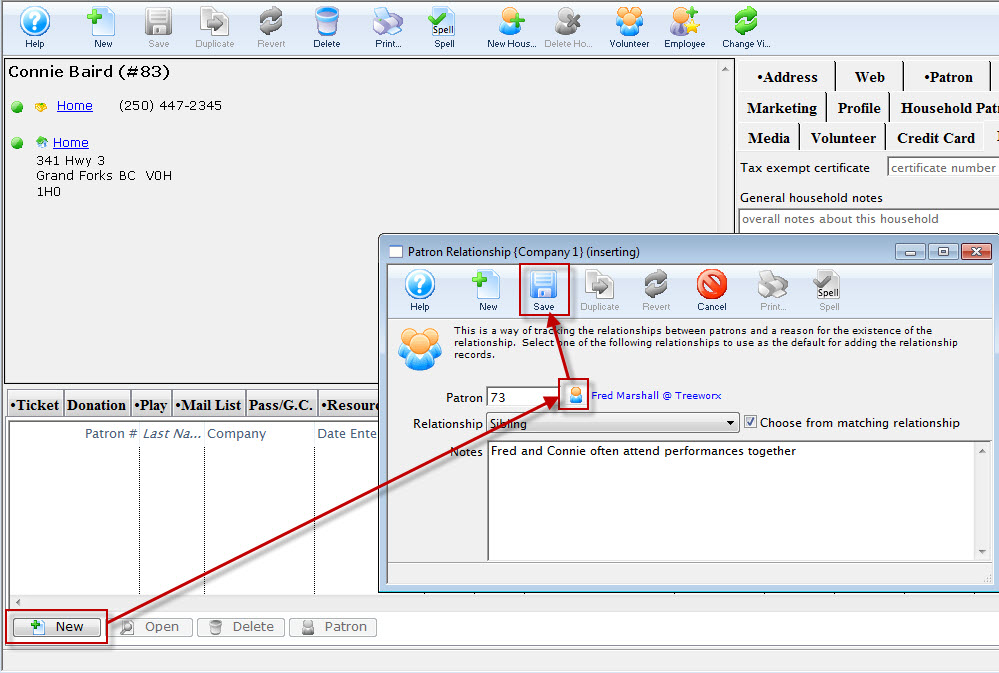
For details on how to access the Patron window click here.
- Click the Relationship
 tab.
tab.
- Click the Add
 button.
button.
The Patron Relationship window opens.
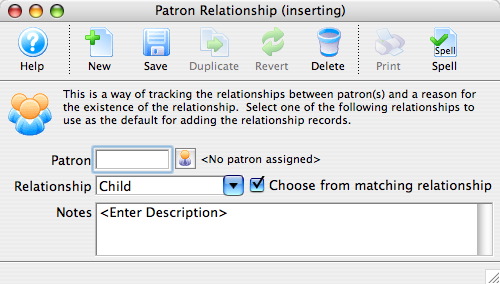
- Click the Patron
 button.
button.
The Contact List opens.
- Search for the other patron in the relationship.
For more information on searching for patrons click here.
- Click the Select
 button.
button.
- Choose a Relationship from the drop down.
The drop-down is populated from the Patron Relationships Code Table. For more information about how to set those values, click here. When setting up the code tables, you can define the Relationship type and the inverse name for the relationship. For example, Parent/Child
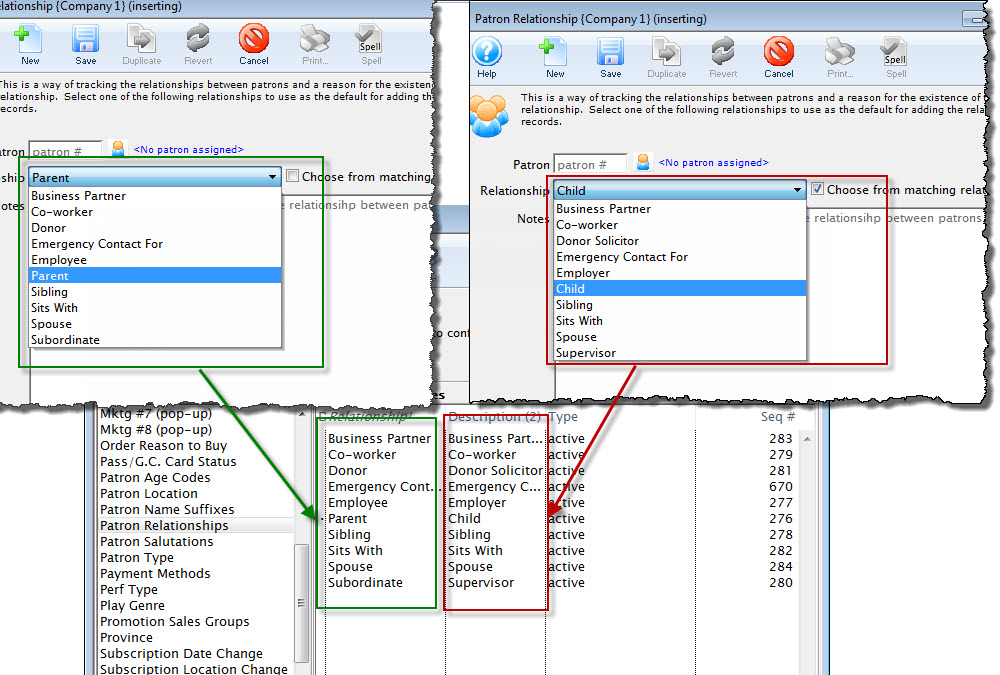
When you un-check the check box in adding a relationship in the Patron, you are presented with only the the Relationship Type and not the inverse. For more information on the Patron Relationship code table, click here.
- Enter any applicable notes.
- Click the Save
 button.
button.
- Close the Patron Relationship window.
The new relationship now appears in the Relationships tab of both patrons.
Add Multiple Relationships
A convenient way to add multiple relationships to a Patron Record by dragging a number of patrons from the Contact List window onto the Relation tab of a Patron Record.
For example, this would be useful if you were creating relationships between a company and all the staff, volunteers or donors that are associated with that company. To complete this task quickly, you would:
- Find the company Patron Record in the database.
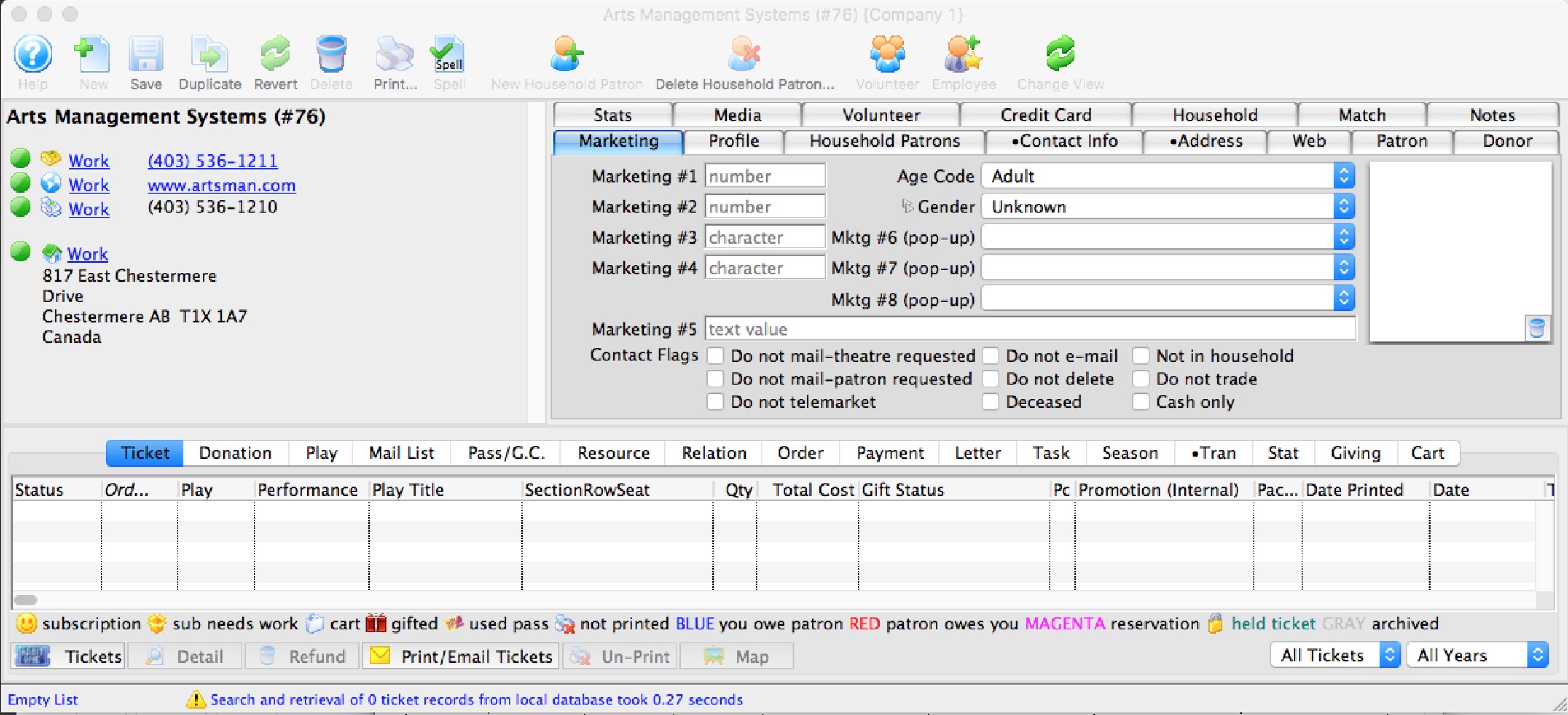
- Open the record and select the Relation tab.

- Open the Contact List window and find all Patrons that work for the company.

- Highlight and drag the Patrons from the Contact List window onto the Relation tab.

- Theatre Manager asks for a relationship. The opposing relationship is applied to all Patrons that are being added.

- Click the OK button to create the relationships.
Should the corresponding relationship not currently exist, it can be added in the Patron Relation section of the Code Tables.
Delete Relationship
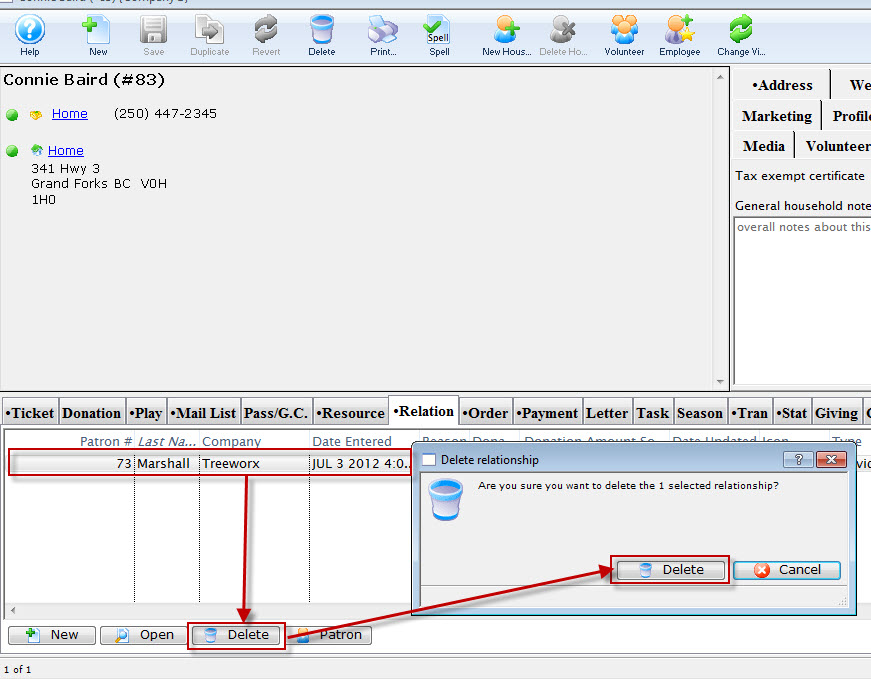
- Open the Patron
 window.
window.
For details on how to access the Patron window click here.
- Click the Relationship
 tab.
tab.
- Click the Delete
 button.
button.
A warning message will appear.
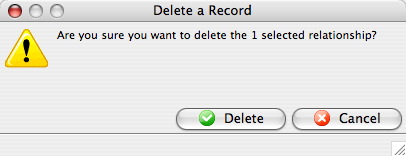
- Click the Delete
 button.
button.
The relationship is now deleted from both patrons records.
Edit a Relationship

To edit an existing relationship, you perform the following steps:
- Open the Patron
 window.
window.
For details on how to access the Patron window click here.
- Click the Relationship
 tab.
tab.
- Select the relationship to be edited.
- Click the Edit
 button.
button.

- Edit the relationship information as needed.
- Click the Save
 button.
button.
- Close the Patron Relationship window.
The new relationship now appears in the relationships tab.
Resource Tab

The Resource Tab is used by the Facility Management portion of Theatre Manager to keep track of Resources associated with a Patron. For more information on Resources, Click here.

Order Tab

The order tab allows the user to view a summary of all previous purchases the patron has made.
For more information on Order management, click here.
You an also select one or more orders and right click on then to perform some of the functions below.
One of the important ones is the ability to rebuild order balances. This will:
- recalculate any balances that look to be errant on the patron record
- recalculate the overall patron balance
- Allocate payments to amount paid for donations, tickets, passes, etc on the order
Parts of the Orders Tab
| Order | A unique number used to define the order. |
| Date | Date on which the order was made. |
| Tix Qty | Number of tickets in the order. |
| Tix Amount | Value of the tickets in the order. |
| Donation Amount | Value of the donations in the order. |
| Membership Amount | Value of the memberships in the order. |
| Fee Total | Value of the fees in the order. |
| Order Total | Combined total value of the donation. |
| Balance | Displays the amount the patron owes. |
| Final Date Due | Date which the outstanding balance on the order is due. |
| Outlet | The number representing the outlet responsible for the order. |
 |
Opens a new order window. For more information, Click here. |
 |
Opens the selected order. For more information, Click here. |
 |
You can
|
 |
After placing an order for a patron, an invoice for the order can be created and printed from the patron window. Click here for more information. |
 |
Transfers the selected order to another patron including payments. Click here for more information. |
 |
Opens a print dialog, to print the selected order. |
 |
Opens the Transaction history record for the selected order. Click here for more information. |
| Include Closed Orders | This box should be checked to show orders which have received payment and been closed. |
Order Tab - Transaction History
The Transaction History window is used to review transactions associated with a Patron. This window displays details of the transaction. These include the date the transaction was create or updated, journal numbers, transaction descriptions and a Theatre Manager code representing the type of transaction.
Use the search drop down to specify the type of transactions to display. Uncheck the include boxes to limit the view of the transaction.
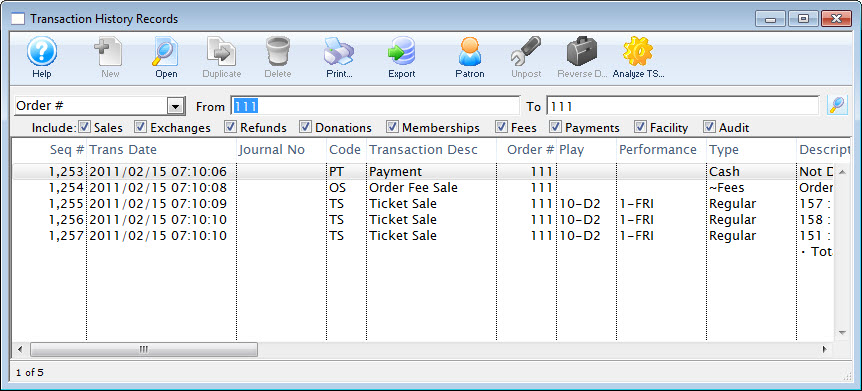
Parts of the Transaction History Window
 |
This function is not available in this window. |
 |
Opens the Transaction Detail window for further detail about the transaction. |
 |
This function is not available in this window. |
 |
This function is not available in this window. |
 |
Prints a copy of the information in the window. |
 |
Exports the information in the window for importing into another program. |
 |
Opens the Patron record of the patron associated with the transaction. |
 |
Attempts to unpost the transaction where applicable. This function is not yet available |
 |
Creates a reverse debit or credit for the transaction. This function is not yet available. |
 |
Analyzes the TS transactions to verify that they are in balance. |
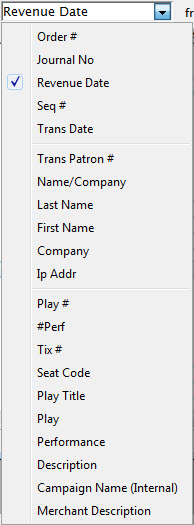 |
A drop down menu of the available search functions. |
 |
Initiates a search based on the parameters in the To and From fields. |
| Include | The items checked will be included in the search. Uncheck an item to remove it from the search. |
| Seq. # | The sequence number of the transaction. |
| Trans. Date | The date of the transaction. |
| Journal No | The journal number of the transaction. |
| Code | The transaction code associated with the transaction. |
| Transaction Desc | A description of the transaction. |
| Order # | The order number the transaction was part of. |
| Play | The event the transaction is associated with. |
| Performance | The performance the transaction is associated with. |
| Description of Entry | An entry description. |
| Debit | The amount of the debit associated with the transaction. |
| Credit | The amount of the credit associated with the transaction. |
| User | The user who handled the transaction. |
| Qty | The quantity of items in the transaction. |
| Total | The total of the transaction |
| First Name | The first name of the patron associated with the transaction. |
| Last Name | The last name of the patron associated with the transaction. |
| Company | The company associated with the transaction. |
| Patron # | The patron number associated with the transaction. |
| Campaign | The donation campaign associated with the transaction. |
| Description | A description of the donation campaign. |
| Promotion | The promotion that used with the transaction. |
| Group | The report group of the promotion. |
| Merchant | The merchant that was used to process the transaction. |
| Event Title | The event title associated with the transaction. |
| Event Code | The event code associated with the transaction. |
| GL # | The general ledger number associated with the transaction. |
| Fee | The fee associated with the transaction. |
Payment Tab

The payment tab allows the user to view a summary of all payments the patron has made toward previous purchases.

Parts of the Payment Tab
| Payment Order # | The number given to the payment to tie it to the order. |
| Date Received | Date the payment was received. |
| Recd By | Employee who took the payment. |
| Srce | Represents the payment source. |
| Payment Method | Method received for payment. |
| Total Paid | Value of the payment. |
| Deposit | Deposit number for this payment. |
| Date Printed | Date the receipt for this payment was printed. |
| Seq # | Merchant Account number applicable to credit cards processed through Theatre Manager. |
| Merchant | Name of the merchant account used to process the payment. |
| Outlet-Owner | Outlet responsible for collecting the payment. |
 |
Opens the Payment Data window for the selected payment. For more information Click here. |
 |
Voids the selected payments. You can only void two things:
|
 |
Deletes the selected payments. Click here for more information on deleting payments. |
 |
Allows printing a receipt for the payment if a receipt ticket face has been assigned in the Company Preferences. Click here for more information. |
 |
Unprints the receipt for the payment. |
 |
Allows a transfer of a payment. Click here for more information. |
| Include Payments for closed Order(s) | This box should be selected to show orders which have received payment and been closed. |
Payment Data Window
 button.
button.
It will show various information such as how the payment was made, the order number, the elapsed time for authorization, and any information necessary to contact the bank for an online or phone in authorization.
 |
If you are using Moneris P400 EMV pins pads, you may need to look at the EMV Results tab when talking to Moneris about an authorization taken through the pin pad. |
Payment Transactions
Click the Open  button, to open the Transaction Detail window.
button, to open the Transaction Detail window.
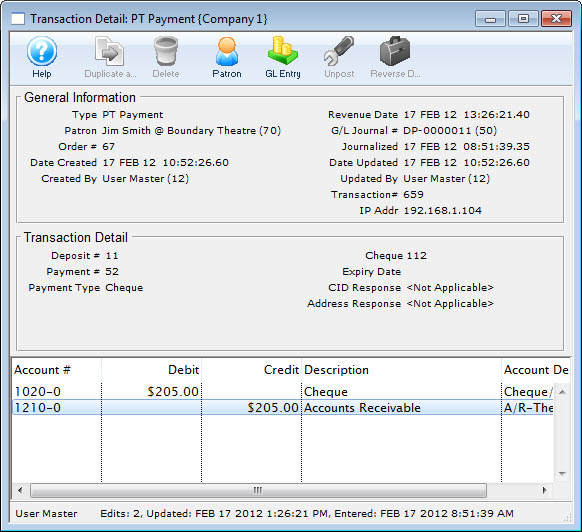
The Transaction Detail displays all information pertaining to a specific transaction. To view the detail of a particular transaction, select the transaction tab on a Patron's record and double click on the transaction. For more information on accessing the Patron Transaction tab, click here.
 |
You may black list this card if you do not want patrons to use it again. If the card is not shredded, you will be asked if you want to black list other patrons with the same card (who are not shredded). |
 |
|
Payment EMV Detail
This window shows the raw authorization results from the Moneris EMV response to an authorization. It can be used when talking to Moneris support about issues with the PinPad. Moneris requires this to be stored for at least 24 months.
Payment Receipt (Moneris P400)
This shows the receipts retrieved from the Moneris P400 pin pad with all the elements required to be printed. You can see:
- Customer/Cardholder receipt copy on the left side of the window
- Merchant receipt copy on the right side of the window
You can print the cardholder receipt on a ticket face by clicking the receipt button on the toolbar (or from the payment list window).
You can also select and copy the text in the cardholder receipt if you want to paste it into an email to send to a patron.
 |
Printing Moneris P400 receipts requires following the setup procedures to import a sample Ticket Face we have created for you. Or, you can create your own. |
Payment Linked Refund List
This will help you determine how much has been refunded against a card already - since you can only refund up to the original amount you authorized on the card.
Patron Letter Tab
You can attach individual letters to individual patrons and to customize letters that can be attached to individual donations, payments, ticket transactions, or passes. For more information on letters click here.
 |
To re-send any 'email' (including web confirmations), you can right click on the email to mark it as not done. You can also double click on the email and change its status from done, to not done. |
Parts of the Letters Tab
| Status | This column displays the printed status of the letter, whether it is done or not. |
| Type | This column displays the type of the letter, if it was a single letter or was it a merged letter. |
| Priority | Displays the priority level of the letter. This can be used to help asses printing needs. |
| Requested by | The user who added the letter to the patron. |
| Note | This column displays notes associated with the letter. |
| Records/File Connected to Correspondence | It is very important to pay attention to this field when printing a form letter from the Letters Tab. This field displays the items the Theatre Manager currently has in memory. Donor Data, Member Data, Personnel Data, etc. To print a form letter from the letters tab, ensure Theatre Manager has the correct information in memory to print the letter. For example, To print a donation letter from the letters tab, the Items Connected should list donation information about the donation that is being merged. If it does not, load that information into memory. To load a file into memory before printing it, consult a support technician to do so. Click here for more information. |
| Date Begin | Date the letter was added to the patrons record. |
| Date End | The last date the letter was updated. |
| Date Printed | The date which the letter was printed. |
 |
A letter can be added to a patron record using this button. A letter added this way will only draw on the patrons contact information. For more information on creating letters click here. |
 |
Opens a window to show the envelope information about the letter selected in the patrons record. This shows its current status, when it was sent and who it went to. You can change the status and cause the letter or email to be resent. Click here for more information. |
 |
Deletes the selected letter.Click here for more information. |
 |
Opens the merged form letter with any attached documents. Click here for more information. |
 |
Sends the selected correspondence immediately. |
 |
Limits the letters viewed in the letters tab. Once an option other then All Letters is selected a search field will appear to the right of the field. Search criteria can be entered and the Search  button clicked to refresh the list. button clicked to refresh the list. |
Email/Letter Detail
When you click the Open  button in the Patron's Letter tab, the letter detail opens. The resulting window indicates envelope information about the letter or system notification. The window that is displayed is different, depending if it is the result of a:
button in the Patron's Letter tab, the letter detail opens. The resulting window indicates envelope information about the letter or system notification. The window that is displayed is different, depending if it is the result of a:
- System Notification such as from the web listener confirming a purchase or password request
- Eblast or batch print which comes from the form letter merge
Editing the envelope information lets you change the status, priority and security level of an email being sent to a patron. You can also re merge and resend or change the priority to 'done' to avoid printing or emailing.
Email Status
If you see errors in emails as desribed in the window above, you can address some on this window and/or on the Note Detail window.
- Based on the error message (as per the sample below), you may need to:
- change the patron's email address to correct it. You can pick one from the drop down, or go to the patron and add a new one or edit an existing one. Make sure it is their primary email address, or if the email address in this list is blank, set it as a primary email address.
After fixing the patrons email address in the patron record, CHANGE the email address on the individual email and it will be resent using the new address.
- if emails do not send because your outgoing email credentials are wrong, then fix them in company preferences
- if you are getting SMTP: 550 Requested..... messages for most emails, see step 2 above
- if you are getting SMTP: 535 Incorrect authentication data yet test emails work, it is probably because you were sending test emails to someone inside the mail server, rather than outside. In that case make sure you email server allows relay from the inside of the network to the world.
- change the patron's email address to correct it. You can pick one from the drop down, or go to the patron and add a new one or edit an existing one. Make sure it is their primary email address, or if the email address in this list is blank, set it as a primary email address.
- After correcting the problem, change the status of all the emails from Error to Not Done using the popup on the window.
- Alternately, if you can't figure out why a specific email will not sent, change the status to Done
- The web sales listener will pick up all the Not Done messages and try to resend them after a few minutes.
 |
Refer to managing unsent emails for more information. |
Letter/Email Attachments
this window shows any attachments that are part of the email correspondence. Some of them may be print at home tickets, invoices, or calendar files that are associated with a web order. The icons indicate whether the attachment has been processed to create its content.
 |
An email will not send if there is an error in the content of one of the attachments.
If you delete a bad attachment, the email will then send without it. (its probably best to find out why it didn't send - such as a bad web page. |
Forms Tab
Task Tab
Tasks are at the heart of the Facility Management module.
For more information about the Facility Management module click here. To read more specifically about tasks and their place within Facility Management, click here. This can be used to track meetings with patrons or notes as well as all other tasks where this patron is assigned as a participant.

Parts of the Tasks tab
| Status | The current status of the task (Done, Not Done, In Progress, Cancelled). |
| Task # | The sequence number assigned by the database to the task. |
| Type | The Type of the Task of the task. Task types are defined in the Facility Task Type code table. |
| Description | The description of the task. |
| Duration | The length of time of the task. |
| Begin Date | Date the task is set to begin. |
| Date End | Projected completion date of the task. |
| Task Notes | Notes associated with the task (if any). |
Attaching an Document to a Patron Record
There are times you will want to attach external documents to a patron's file, for example a scanned invoice, a word document, etc.
In the following example, we will attach a document called 10-17-12-Invoice.jpg to the patron's record.To do this, you perform the following steps:
- Open the patron record of the Patron you are attaching the document to.

- Click on the Task tab.

- Click the New
 button.
button.
The Task inserting window opens.
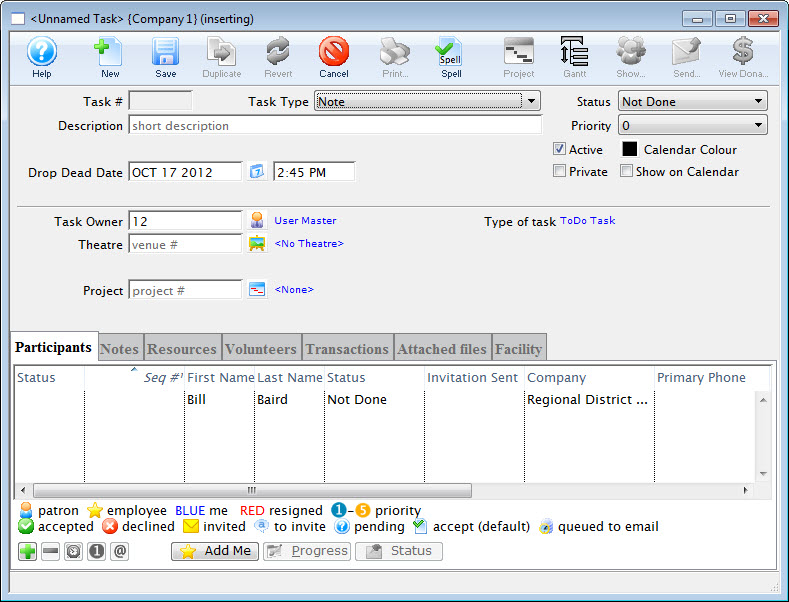
- Enter a Description for the Task and click the Save
 button.
button.
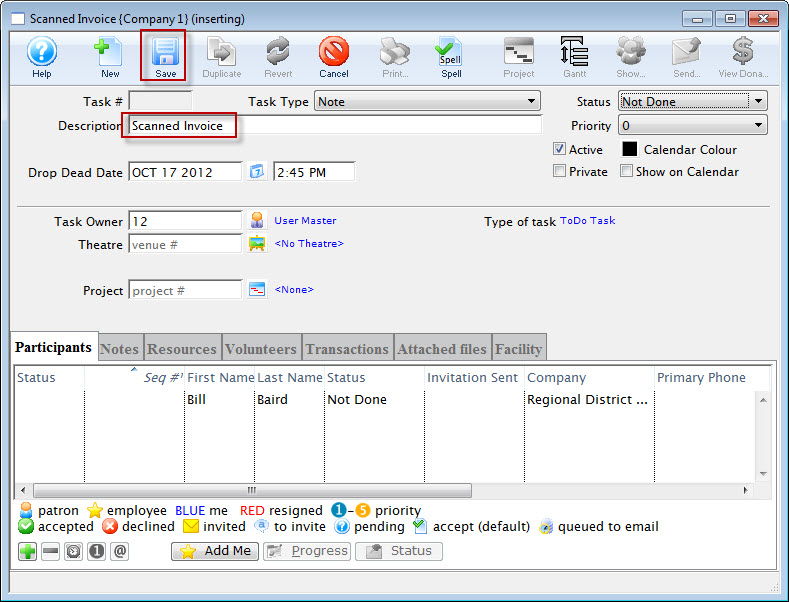
After saving, the Attached File tab is now available for selection.

- Open the Attached files tab and click the Add Doc
 button.
button.
The Select File dialog for your operating system opens.
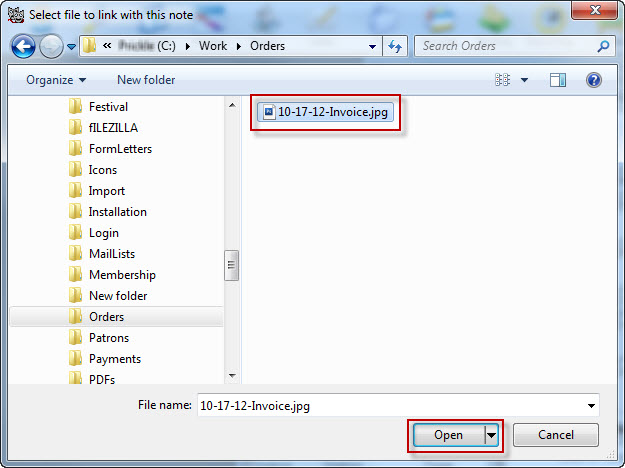
- Locate the file and click the Open button.
The document is added to the Patron's record.
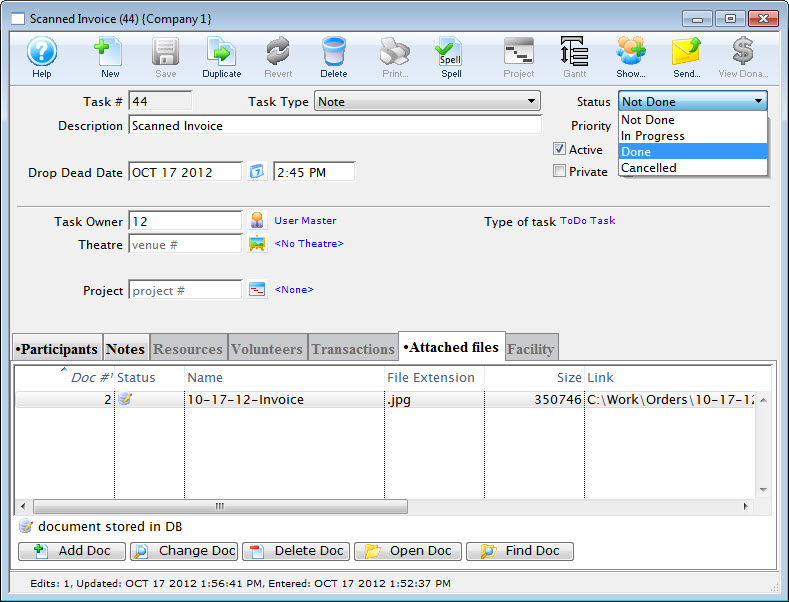
Season Tab

This tab keeps track of a patron's season subscription package information. Refer to Seasons Subscriptions to learn how to book a subscription.

Parts of the Season Subscription Tab
| Ref.# | This column displays the reference number that was assigned to the patron's favorite seats. This number can be used for internal tracking purposes. |
| Year | This column displays the year the that season subscription was purchased. |
| Season Package | This column displays the season subscription that was sold to the patron. |
| Series | This column displays which series the patron has booked their season subscription for. The picture above shows that the patron has booked his subscription for the first Saturday performance for each show. |
| Printed | This column displays the date that the patron's season tickets were printed. |
 | Opens the Select a Season package to add a new record. |
 | Opens the selected subscription record. |
 | Deletes the selected subscription record. |
 | Books the selected subscription record. |
 | Lets you make a payment for the selected Subscription. |
 | Lets you renew the selected Subscription. |
 | Prints the renewal notice for the selected subscription. |
 | Prints the renewal notice for the selected subscription. |
| Active | Enabling this check box shows only the active subscriptions. |
| Inactive | Enabling this check box displays the inactive subscriptions for this patron. |
Transaction Tab

The Transaction Tab shows all the transactions that have occurred for the patron.

Parts of the Transaction Tab
| Seq# | A unique number used to track the transaction |
| Trans Date | Date and time the transaction took place. |
| Journal No | A unique journal number for tracking the transaction line. |
| Code | The transaction code used to describe the type of transaction. |
| Transaction Desc | Description of the transaction. |
| Order # | The order number for the transaction. This number can be used to track the transaction by order. |
| Play Code | Play code is only displayed if the transaction effects and event. |
| Performance Code | Performance code is only displayed if the transaction effects a performance. |
| Type | The type of transaction. |
| Description of Entry | Detail on the the purpose of the transaction. |
 |
Can be used to manually enter a transaction. |
 |
Opens the detail window of the transaction. |
 |
Deletes the selected transaction. |
 |
Used to search for specific transactions. |
Searching Transactions
- Open the Transaction
 tab.
tab.
The Transaction tab is located on the Patron Window.
- Select a search field from the menu.

- Fill the To and From fields with the parameters to
search.

- Click the Search
 button.
button.
The results of the search will be displayed in the table.
Statistic Tab
Clicking the Statistic tab on the bottom half of Patron Window will open the Patron Statistic Tab.

Parts of the Statistic tab
| Year-Statistics | The fiscal year range the statistic belongs to. |
| # Donation | The number of donations made within the fiscal year. |
| Donation Actual Amount | The cumulative value a patron has confirmed they will donate within the fiscal year. |
| Soft Credits | The cumulative value of soft credits made within the fiscal year. |
| Hard Pledges | The cumulative value of hard pledge donations made within the fiscal year. |
| # Tix | The number of tickets bought within the fiscal year. |
| Tix Sales Total | The cumulative value of tickets bought within the fiscal year. |
| Regular | The dollars spent purchasing tickets using standard ticket sales procedure. |
| Subscription | Dollars spent on Subscription ticket sales based on show setup. |
| Other Type 1 | Dollars spent on Other Type 1 ticket sales based on show setup. |
| Other Type 2 | Dollars spent on Other Type 2 ticket sales based on show setup. |
| Other Type 3 | Dollars spent on Other Type 3 ticket sales based on show setup. |
| # Member | The number of membership items bought within the fiscal year. |
| Pass Value | The dollars spent by the patron on the purchase of passes, memberships, Gift certificates or other items. | # Fee | The number of times a fee paid within the fiscal year. |
| Fee Total | The dollars collected from the patron for fees on ticket orders. |
| #StaffVoluneer | The number of scheduled times a patron has Staff, or Volunteer or Personnel activities within a fiscal year. | #StaffVoluneerAmount | The rate charged for Staff, or Voluneer or Personnel activities with in a fiscal year. |
| Resource Value | The cumulative value of Merchandise or Resources bought within the fiscal year. |
| #Projects | The cumulative value of projects within the fiscal year. |
| Stat# | The stat database sequence number. |
| Outlet | The Outlet control number. |
| Outlet-Owner | The Outlet reporting the transactions. |
| Fiscal Year | The year based on account setup within Company Preferences. Click here for more information. |
Donor Summaries Tab

This tab is used as a reference to view the 'saved' patron giving levels created during specific moments in time. You can use this information as a quick overview of where the patron was each year rather then reviewing all their individual donations under the donor tab.
For more information on Donation Giving Levels, click here.

This data is used when people need to EXPORT out the total $$$ donated by patrons based on certain criteria and what giving level they are at.
Parts of the Donor Summaries Tab
| Date | The date the overall level was created or saved. |
| Combined Pledge | Total value of pledges within this level of giving. |
| Number Gifts | Number of donations made to reach the Giving Level. |
| Includes Matching | To reach the level did the matrix include matching gift totals. |
| Combined Giving Amount Matching Gift | Total value of matching gifts contributing to the patron reaching this level of giving. |
| Combined Giving Amount Soft Credits | Total value of soft credits contributing to the patron reaching this level of giving. |
| Giving Level | The level in the giving matrix the patron reached. |
| Giving Level Matrix | The name of the matrix the giving capacity is assigned to. |
| Outlet-Owner | Outlet the giving matrix belongs to. |
Adding a Patron to a Giving Level
- Click the Reports button.
The Report window opens. Select Donation Reports & Receipts in the left column. On the right hand column, choose between:
- Donor Program Insert - Giving Level
- Donor Program Insert - Giving Level with $$$ Totals
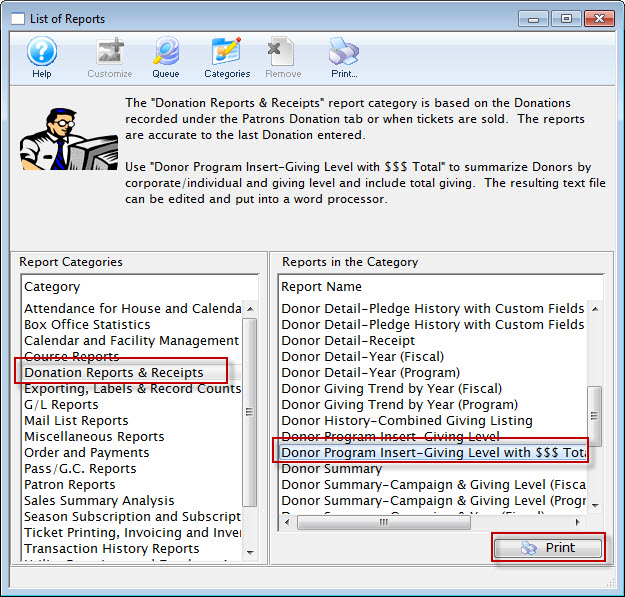
- Click the Print
 button.
button.
The criteria window opens. Enter the criteria as needed.
- Click the Insert Summary tab.
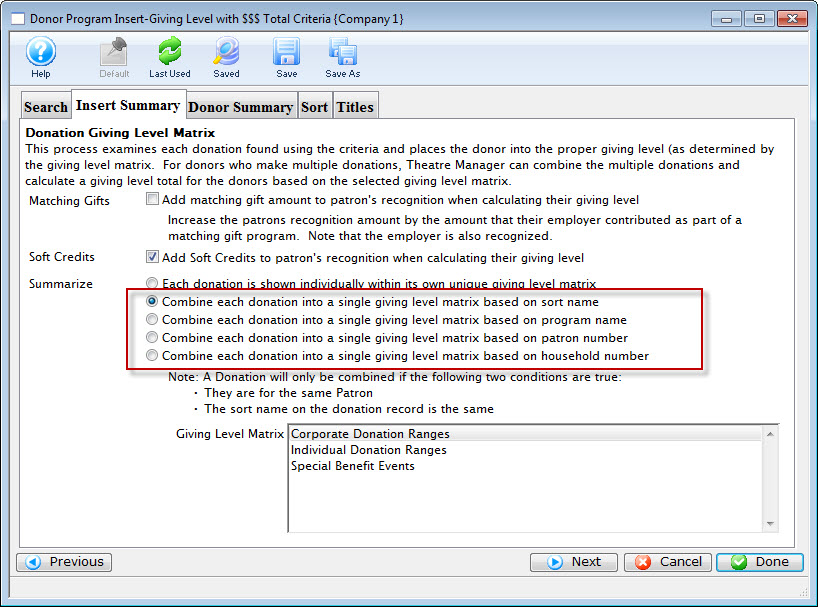
- Select the Add Soft Credits check box, then choose one of the Combine each donation into a single giving level option.
- Open the Donor Summary tab.
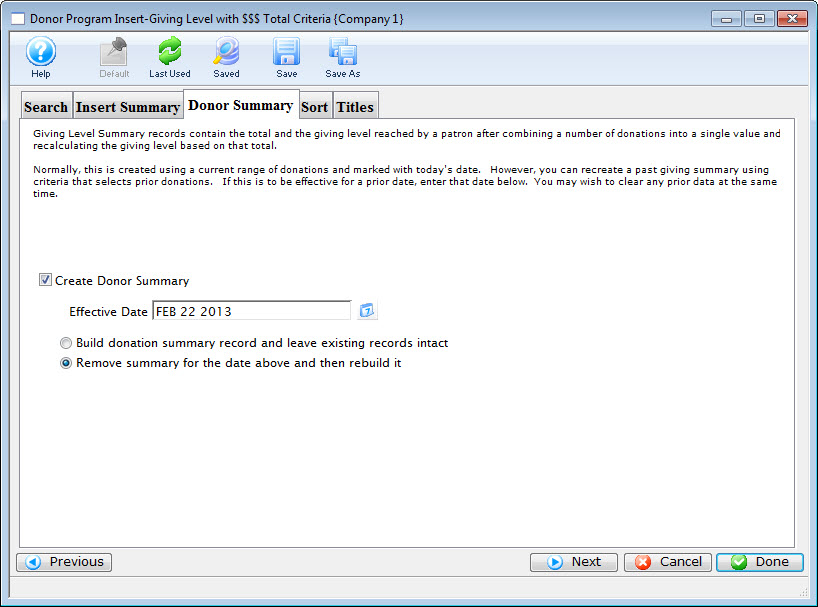
- Check the box next to Create Donor Summary. This will populate the information into the Giving tab.
- Click the Done
 button.
button.
The report will generate to screen or the designated print location. Once complete the giving details will appear in the Patron Record.

The information in this tab is optional, as the data and giving levels for ANY time period can be calculated using the reports "Donor Program Insert-xxx" at any time.
This data is also used when people need to EXPORT out the total $$$ donated by patrons based on certain criteria and what giving level they are at. You then run the report with Your criteria, to get the results.
You then can EXPORT out this data using the file called "Donation Program Listing Level Attained" to use the total $, or level of information. Another option people then do with this data is use it in Mail List buiding. (for example: build the level listing for all donations based on criteria).
You run a mail list build to refer to the list and only the patrons with more then $500 and criteria x, y, and z should be added to a mail list.
A powerful option to use when doing donation management.
Cart Tab
- look at the cart status to see if they checked out the cart or if there were some issues.
- open up and view details about the shopping cart.
- If the cart is active and the patron calls you for assistance, it is also possible to take over the shopping cart on their behalf and check them out.
You can also view all carts for all patrons.


Parts of the Web Cart Tab
| Cart # | A unique number representing the patrons web shopping cart. |
| Patron # | The Patron identification number. |
| First Name | Patrons first name. |
| Last Name | Patrons last name. |
| Company | The name of the company the patron belongs to. |
| Status | The status of the shopping cart. Typically you might see:
|
| Hits | The number of web pages that the patron accessed for that shopping cart. It is possible to check out a couple of tickets in 8 page hits if the patron has an account. Average is probably about 20 as patron shop, especially for subscriptions. Any large number generally means that the patron was unsure. |
| Cart Value | Total value of the patrons cart. |
| Tix Qty | Number of tickets the in the cart. |
| Pass Qty | The number of passes in the cart. |
| Donation Qty | Number of donations in the cart. |
| Checkout Date | The date the patron paid for the iteams in the cart. |
 |
Not available - only web listener can create shopping carts. |
 |
Opens an existing shopping cart so that you can view the web logs, contents and possible 'check out' an active cart on behalf of a patron. |
 |
Deletes a shopping cart for the patron. |
Adding a New Patron
Patrons can be added to the database as an individual or as a member of a household. A household groups together common buying units or patrons that share some of the same contact information. A household might be workers in a company, members of a service group, a family in a home. The word household can be customized under the Appearance tab in Company Preferences.
When inserting a patron, Theatre Manager creates a unique number for each new record entered. This number is the patron number.
Patron numbers cannot be reused if a patron is deleted or merged. The amount of information to be entered upon initial patron insertion is determined by the user. Using the Mandatory Data Tab found under the menu System Preferences, the user is able to set mandatory fields for patron insertion. This means that the user decides which patron fields must be entered before the new patron record can be saved. In other words, if fields have been made mandatory, then Theatre Manager will not save a new record if one or more of the mandatory fields are not filled in.
There are two different ways to insert a patron. The first is via the Contact List and the second is the Patron Window.
|
Quick reference information for Adding a New Patron |
- Click the Patron
 button on the main Theatre Manager toolbar / ribbon bar.
button on the main Theatre Manager toolbar / ribbon bar.
The Contacts For window opens.
- Click the New
 button.
button.
The New Household Insert window opens.
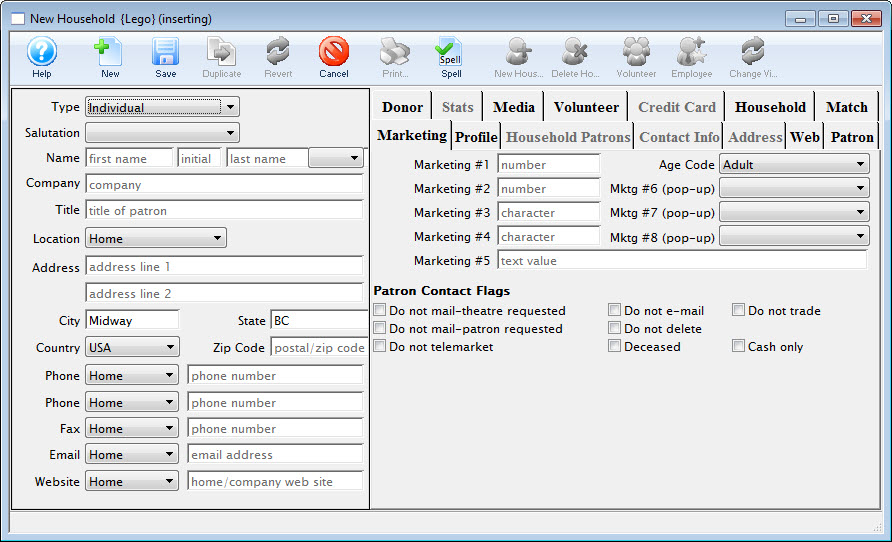
-
Enter information into the mandatory patron fields.
The patron's basic information should be filled in. For more information on setting mandatory fields click here. All mandatory fields must be filled in or Theatre Manager displays a message in red at the bottom of the window describing which fields must be completed before the patron can be saved.
- Click the Save
 button.
button.
The patron record is saved to the database and a patron window opens for the new patron. They will now appear on the Contacts List window.
Inserting a New Household Member from the Patron Window
- Use the Contact List to locate a member of the existing household.
Click here for more information on the Contact List.
Single click on the existing member of the household and click the Open
 button.
button. The patron window for the selected patron will open.
- Click the New Household Patron
 button.
button.
The Patron Contact Card (inserting) window will open.
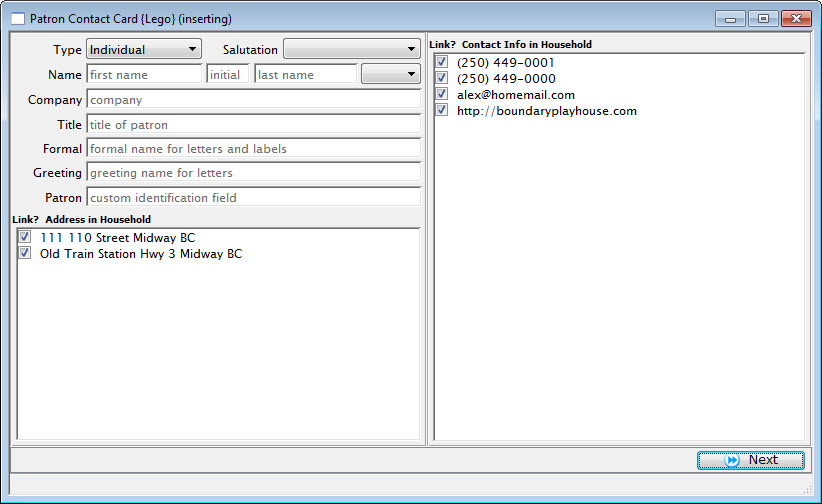
- Enter the mandatory patron fields.
For more information on setting mandatory fields Click here. Each patron must have one address and one piece of contact information.
Deselect the addresses or contacts that are not connected to the patron. This can be done by clicking once on the check box. The check mark will disappear.
All mandatory fields must be filled in or Theatre Manager will display a message in red at the bottom of the window describing which fields must be completed before the patron can be saved.

Click the Next
 button.
button.The contact card for the new patron opens. Details, such as marketing information, donor history and patron details can be added to the record.

Click the Close Window
 button.
button.The new patron record is now saved in the database. The patron now displays in the household.
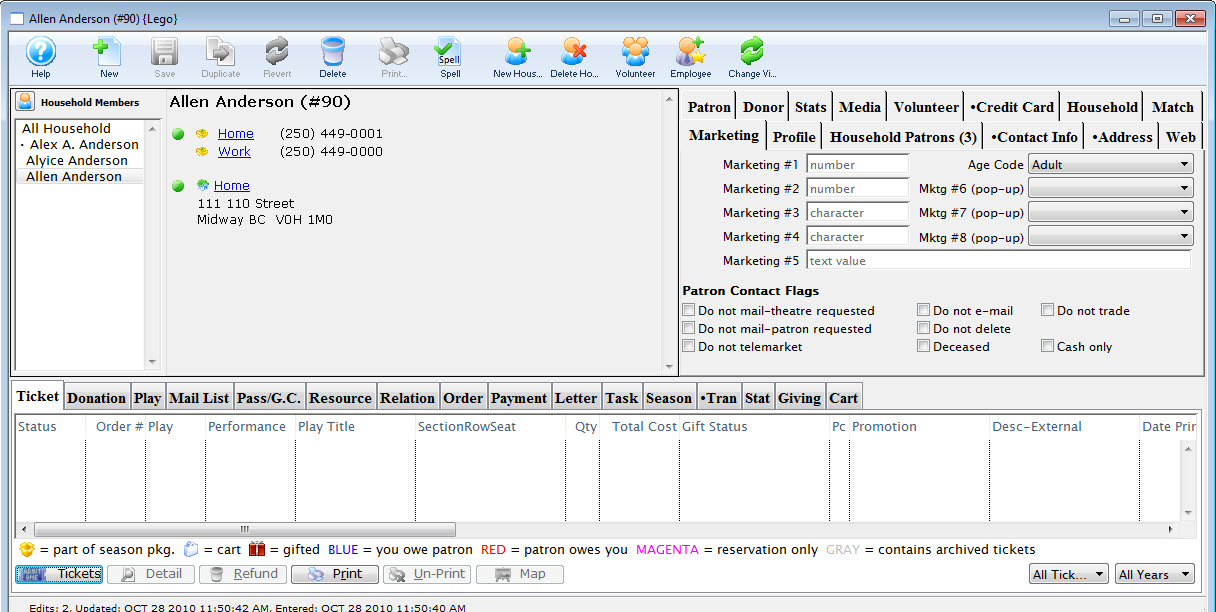
Inserting a New Household from the Patron Window
- In the patron window click the New
 button.
button.
The New Household (Inserting) window will open.

- Enter mandatory patron fields.
The Patron's basic information should be filled in. For more information on setting mandatory fields Click here. All mandatory fields must be filled in or Theatre Manager will display a message in red at the bottom of the window describing which fields must be completed before the patron can be saved.
- Click the Save
 button.
button.
The patron record is saved in the database and a patron window will open for the new patron.
Contact List Window
The Contact List can be used to produce a listing of patrons in the database. This list can also be narrowed to only patrons on a specific grouping by using select criteria.
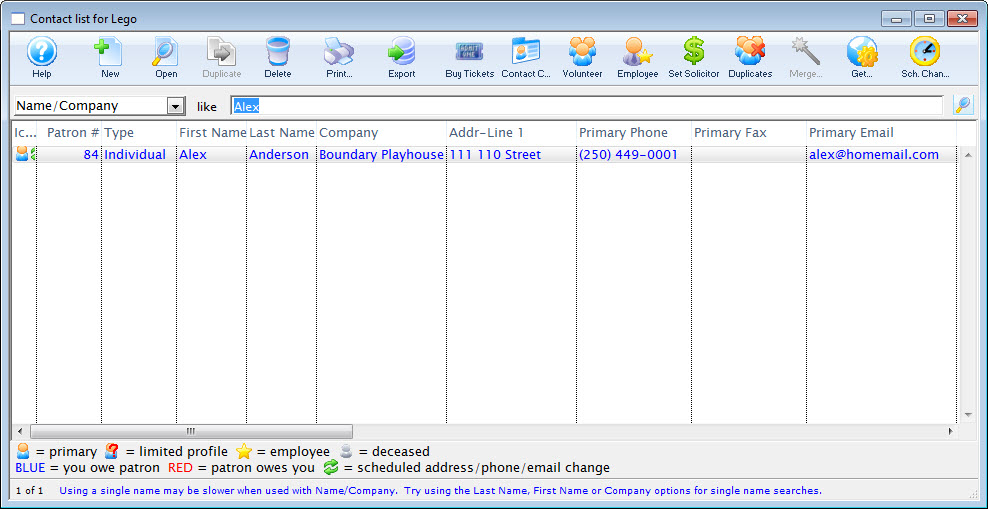
Contact List Buttons
 |
Inserts a new Patron. Click here to learn more about inserting new patrons. |
 |
Opens the Patron window for the selected patron. |
 |
Not available in this window. |
 |
Deletes the patron. Click here for more information on deleting patrons. |
 |
Prints a report the of the patrons in the contact list to screen or default print location. |
 |
Exports the data from the contact list into a tab delimited format and saves it to a selected location. |
 |
Opens the Orders window for the selected patron in the contact list. Click here for more information on purchasing tickets. |
 |
Opens the Contact Card for the selected patron in the contact list. Click here for more information on the Contact Card. |
 |
Opens the volunteer history for the selected patron. Click here for more information. |
 |
Use this to manage the employee logon information for this patron.Click here for more information on adding employees. |
 |
Assigns a donor solicitor to the patron record.Click here for more information. |
 |
Searches the contact list for duplicate patrons. Click here for more information on duplicate records. |
 |
Merges two or more selected patrons from the contact list. |
 |
Use address information to copy to clipboard or show in a browser, dhows a map of the patron's address or the weather at the patron address. Click here for more information. |
 |
Displays a list of scheduled address or contact listing changes. Click here for more information on how to scheduled contact changes. |
Contact List Search
Search options require parameters to search within. The most common search parameter is From To. This option allows for a start and end range to be entered for the search. It can limit down the list quickly and can be as specific as needed. The second most common search parameter is Like. Like returns results containing the value entered for the search.
| Patron # | A patron number starting from one number to another. If the exact number is known this can be entered in both fields. The patron assigned that number will appear as the result. |
| Name/Company | Enter a part of the patrons first name, last name or company. All three fields in the database will be searched for a record containing like information. i.e. Ab returns Blaine Abel, Julie Abel and Lauren MacIntosh of ABC Book Store. |
| First Name | The first letter, part of or a complete first name. The more entered the more accurate the results will be. |
| Last Name | The first letter, part of or all of the patrons last name. The more entered the more accurate the result. This field only searches the last name field within the database. |
| Phone/Email/Website | Part or all of a telephone, fax number, email address or website. Spaces, dashes and brackets are not needed when entering phone or fax numbers. They will be automatically formatted. |
| Balance-Tickets | A balance owed to or by a patron within a ticket purchase. A minus in front of an entered number will result in money owed to the patron. |
| Credit Card | Part or all of a credit card number. This search option may return partial results depending on your settings for PCI in the System Preferances setup. |
| Employee # | The number of the Employee. |
| Patron Type | Patron Type can be used to sort patrons records into categories. |
| Addr-Line 1 | A number, street or full address to be searched by that would have been entered in the first address field provided. |
| Addr-Line 2 | A number, street or full address to be searched by that would have been entered in the second address field provided. |
| City | First letter, part or all of a city name. The more entered the more accurate the results. |
| Province/State | First letter, part or all of the province or state. The more entered the more accurate the result. |
| Postal Code/Zip Code | Part or all of the postal code or zip code. The more entered the more accurate the result. |
| Balance-Donation | A balance owed to or by the patron with a donation contribution. A minus in front of an entered number will result in money owed to the patron. |
| Date Entered | Enter a date range to view patrons entered into the system within that range. |
| Date Updated | Enter a date range to view patrons with updated records within that range. |
| Marketing #1 | A customizable numeric range to search by. |
| Marketing #2 | A customizable numeric range to search by. |
| Marketing #3 | A customizable character range to search by. |
| Marketing #4 | A customizable character range to search by. |
| Mktg #6 (Pop-Up) | Search from one of the options listed in the marketing pop-up. Marketing #6 is a customized field. For more information click here. |
| Mktg #7 (Pop-Up) | Search from one of the options listed in the marketing pop-up. Marketing #7 is a customized field. For more information click here. |
| Mktg #8 (Pop-Up) | Search from one of the options listed in the marketing pop-up. Marketing #8 is a customized field. For more information click here. |
| Age Code | Age Codes are used to categorize personnel and/or volunteers into particular age ranges. |
| Match Gift Company | Search for company's who are or are not flagged as matching gift givers. Matching gift companies are designated under the Donor tab. This search is either 'Yes' to indicate the list will contain records that are flagged as Matching Gift Companies, or 'No' to indicate that the list will contain records that are NOT flagged as Matching Gift Companies. For more information click here. |
| Patron Donor Giving Capacity | Select a giving level. The donor tab of the database will be searched for matching patrons. Giving capacity is assigned under the Donor tab. For more information click here. |
| Control Number | Numeric field to search by control number. Control numbers are associated with items purchased under the Membership tab. For more information click here. |
| Pass/G.C. Card Number | Numeric field to search by member card number. |
| Ticket Number | A number field to search by ticket number. Each ticket has it's own unique number as a reference. The patron displayed with have purchased the ticket with the number entered. |
| Order # | An order number is a unique number used to define the order. |
| Tix Comment | Searches for comments entered in the Payments window. |
| PCI Data Check | Helps you to identify data attached to patrons that could be construed as a possible clear text credit card in violation of PCI guidelines. Click here for full information on the particulars of this function.
|
Contact List Columns
Indicates a patron who is the head of a household. Other items in this list indicate that the patron is an  Employee, or has Employee, or has  Scheduled Contact Information changes. Scheduled Contact Information changes. |
|
| Patron # | A unique number representing the patrons account. |
| First Name | First name of the patron. |
| Last Name | Last name of the patron. |
| Company | Company the patron works for. |
| Primary Phone | Phone number designated as the primary contact number. |
| Balance | Outstanding balance in the patrons account. |
| Addr-Line 1 | First address line. |
| Addr-Line 2 | Secondary address line. |
Get Patron Information
The Get Patron Info button in the Contact List menu performs three functions:
- Copy patron name and address to the clipboard.
- Show map of patron address using MapQuest. Click here for more information.
- Show weather at patron address using Weather Underground. Click here for more information.

Copy Patron Name and Address to the Clipboard
Making this selection copies the details of the curent patron to the clipboard. The information can then be pasted into a word processor or worksheet application by using the Edit >> Paste menu.

The ticket list is copied in a tab delimited format. It can then be pasted into a Worksheet (e.g. Microsoft Excel) with the ticketing information being placed into their individual cells. It can also be copied and pasted into other applications (e.g. Microsoft Word)
Address
Mr. Jake Belleville
Vice President
Barnes Management
1362 Main St NW
Calgary Alberta T5W 0Z2
Address and Phone
Mr. Jake Belleville
Vice President
Barnes Management
1362 Main St NW
Calgary Alberta T5W 0Z2H: (403) 264-0466
W: (403) 245-9877
F: (403) 245-6389
Alternate Address
Mr. Jake Belleville
23 Orange Blvd.
Sarastoa Florida 34237
USA From :JAN To :FEBalt H: (941) 453-5673
alt F: (941) 453-4352
Ticket List
Mr. Jake Belleville
Order Play Performance Sect/Row/Seat Qty Price Price Code Promotion Title
119 01-002 1-SUN Festival Seating 1 10.70 A Regular RAINMAKER
119 01-002 1-SUN Festival Seating 1 10.70 A Regular RAINMAKER
120 01-02 1-THUR Bal Centre/AA/07 1 8.03 B Regular ROLLING STONES CONCERT
120 01-02 1-THUR Bal Centre/AA/08 1 8.03 B Regular ROLLING STONES CONCERT
118 01-D2 1-FRI 2/26/1 1 21.40 A Regular YOU SAY TOMATO
118 01-D2 1-FRI 2/26/2 1 21.40 A Regular YOU SAY TOMATO
Adding Campaign Solicitors to Patrons belonging to a List
To add a Solisitor to a number of patrons, you perform the following steps:
- Click the Patron
 button in the main Theatre Manager toolbar / ribbon bar.
button in the main Theatre Manager toolbar / ribbon bar.
The Contact List window opens.

- Search for the Patrons to add solicitors to.
To learn more about searching for patrons click here.
- Select the Patrons to add a solicitor to.
You may wish to add a certain solicitor to some patrons and a different solicitor to others. Select the patrons for the first solicitor and repeat for the second group as needed.
- Click the Solicitor
 button.
button.
An empty employee list opens.
- Click the Search
 button.
button.
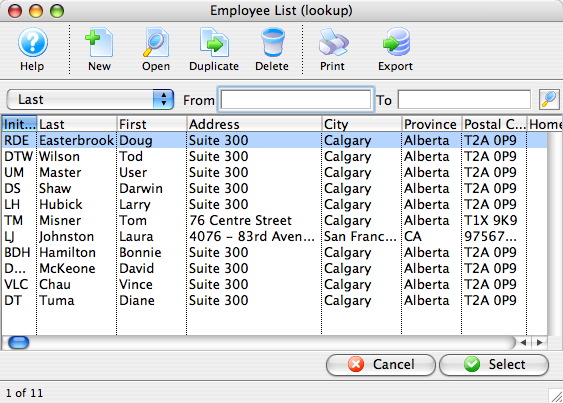
- Click on the Employee to select as solicitor and click the Select
 button.
button.
A confirmation message opens.

- Click the Yes
 button.
button.
This solicitor is now assigned to the previously selected patrons.
Google Maps from a List of Patrons
You can use Google Maps to locate either a single address, or a group of addresses from any patron contact list. This means from the Patron Contact List, the WHO's IN tab of a Mail List of Patrons, an Attendance list on an Event setup or anywhere you can generate a listing of patrons.
This is helpful if you wish to see a graphic representation of where your subscribers or donors live.
To generate a map from the Contact List, you perform the following steps:
- Open the patron list window.
- Search for some patrons.
- Select the patrons by holding the Ctrl Key as you click.
- When you have completed yuour list, right click on the selected list of patrons, and choose Google Map.

Your default browser opens, and take you to Google Maps, and plots the patrons from your contact list on the map.

Map to Patron's Address
The Map of Patron Address function will send the patron's address to the Mapquest Website and open the default web browser with a map of the patron's address. This function will only work if there is an internet connection.
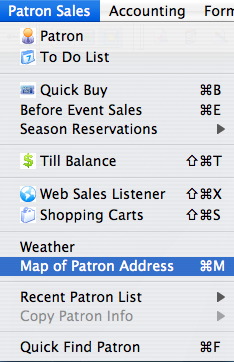

Patron Management - Weather
This option will display the weather in the current patron's city. This option can only be used if the computer has an internet connection. The site used for this function is http://www.wunderground.com/.

Recent Patrons
 |
You can access the recenpt patron list from the main toolbar by option clicking on the patron icon |

When a patron is selected the Patron window opens, displaying their information.
Editing Patron Information
- Find the patron to be edited.
Click here to learn how to find patrons.
- Double-Click on the patron's name in the top left corner of the window.

The patron contact card will open.
For information on the Patron Contact Card click here.

- Add and/or change the contact information as needed.
- Close the Contact Card window.
The changes made to the patron have been saved.
Splitting a Patron from a Household
To split a patron from a household, you perform the following steps:
- Open the patron record for the patron you wish to split.
Click here for more information on searching for a patron.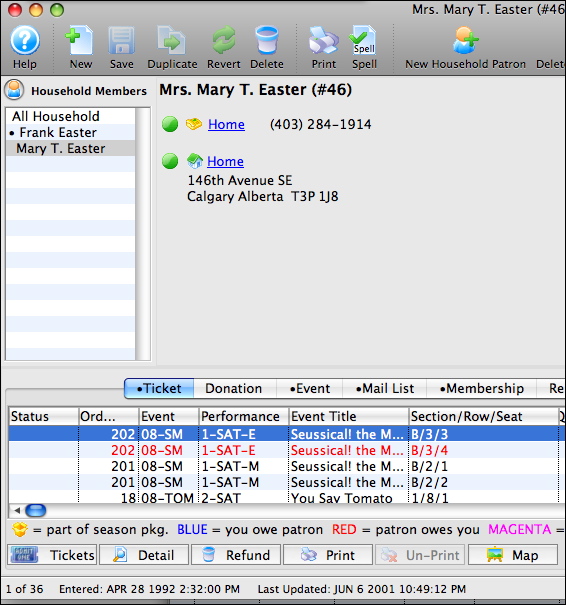
- Right-click on the patron's name in the household members list.

- Click Split patron into new household.
- Click the Yes
 button on the warning pop-up window.
button on the warning pop-up window.
 The patron will now be split from the household. All of the patron's historical data will remain with their record.
The patron will now be split from the household. All of the patron's historical data will remain with their record.
Deleting Patrons
A patron can only be deleted if there is there is no Financial History associated with the record. Employee access to deleting records can be controlled when employees are created in Theatre Manager. Refer to the section Employee Access.
 |
A patron who has financial transactions of any kind associated with their record cannot be deleted. You can mark them as deceased or do not email and included those criteria in reports and mail lists. |
Deleting a patron with no financial information
- Find the patron to be deleted in the contact list.
Click here to learn how to find patrons.
Single click on the patron to be deleted in order to select them.

- Click the Delete
 button
on the Contact List window toolbar / ribbon bar.
button
on the Contact List window toolbar / ribbon bar.
If the patron record contains financial history several diifferent messages, similar to the one below, will appear.
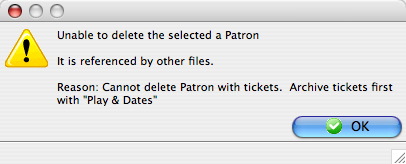
If the patron record contains no financial history, a confirmation window will appear.
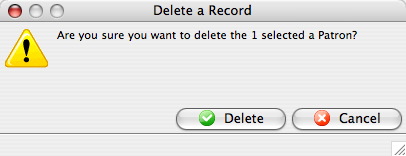
Click the Delete
 button.
button.When the deletion is successful, the patron record and patron number are removed. That patron number is not be re-assigned to another patron. This number is no longer available for use as it was a unique identifier to that specific patron.
Removing patrons with financial history
Theatre Manager needs to keep a record of all sales and financial data intact to ensure the overall system balances and all part reports show proper ticket sales, donations, etc.
There are two trick you can employ to making these people go away.
 |
Option 1: Change the name of the patron::
|
 |
If you really want to get rid of patrons with history:
|




 An entry in this field does not actually
reserve complimentary tickets for the media patron.
An entry in this field does not actually
reserve complimentary tickets for the media patron.